Data Communication Scholarship at ICPSR
We are now accepting applications for two 2022 competitions (ICPSR Undergraduate and ICPSR Master's), which are listed below.

2024 ICPSR Data Communication Scholarship
Times are changing, and so is the ICPSR Research Paper Competition. Since 2007, the annual competition has showcased undergraduate and graduate students’ research papers that have used data archived at ICPSR.
Winners from ICPSR’s member institutions have covered topics from “ Testing the Theory of Rational Crime with United States Data, 1994-2002 ” in 2007 to “ Does (Trans)Gender Identity Complicate the Relationship between Education and Self-Rated Health? ” in 2022.
Now, we’re excited to announce that the ICPSR Research Paper Competition is transitioning to the ICPSR Data Communication Scholarship. Starting in November 2023, students from ICPSR member institutions can apply for the scholarship. Instead of the traditional research paper format, ICPSR is recognizing students for creating videos about ICPSR data! "We not only want students using our data, but we want to empower the next generation of data advocates," said Linda Detterman, ICPSR's Membership and Communications Director.
Learning Objectives
After completing this project, students should be able to:
- Use the ICPSR search tools to find data on a topic of interest to them.
- Drill down into the information about a study to determine:
- The basics: What was the study about? Why was the research conducted, and what topics were covered?
- Methodological concepts: Who was in the sample and how were they selected to participate? When and how were the data collected, and was the study part of a larger data collection effort (e.g., longitudinal, repeated cross-section, data collected from more than one ‘source’ [e.g., school, teachers, parents, and kids])?
- Other details: Who were the investigators? Was the research funded and by whom? Are the data members-only or available to all, what is the data citation
- Examine related publications to see what has been done with the data
- Synthesize the information to identify research topics for which the data are well suited
- Create an “advertisement” about the data, highlighting the key features of the study
Feb. 23, 2024, at Midnight, ET
Submissions
What to Submit:
- An entry form that includes information about the submitter(s) and the data.
- The link to a video, no longer than 2 minutes in length, that describes an ICPSR study that gives the viewer a “run down” of the important points and a glimpse at potential uses. Details about what to include can be found in the “Preparing Your Entry” section.
About the Scholarship
Students from ICPSR member institutions are eligible to win scholarships of $1,000 (first place) or $750 (second place) for creating a short video to promote a study in the ICPSR catalog. Realizing that coursework requirements and assignments have changed since the ICPSR Paper Competition was launched in 2007, we are giving the competition a major facelift to better match what students are being asked to do in an era of more creative, less traditional assignments. Upon completing the video, students should have gained experience navigating and searching ICPSR , identifying data of interest, and using the information provided for each study to determine potential uses of the data.
Preparing Your Entry
The Fine Print
- To be eligible, students must attend a school that is a member of ICPSR. If you are unsure whether your school is a member, please check the member list .
- Students entering the competition must graduate or have graduated no earlier than April 1 of the year prior to submission. For example, students entering in 2024 have to graduate April 1, 2023, or later.
- Studies chosen for the videos must be part of ICPSR's curated collection. Specifically, studies found in OpenICPSR and studies with a description that contains a link to another site from which to get the data are not eligible. Note: some study description pages point to the project’s website for further description – that’s okay, as long as you can download the data from the ICPSR page (clicking on download lists files in formats such as SPSS, Stata, SAS, R, and ASCII or CSV as well as documentation files).

- We encourage you to search all of the collection, but you can also start your search with only the eligible studies .
- Think about a topic you are interested in and might like to conduct research on.
- Use the search tools on icpsr.umich.edu to see what ICPSR has related to that topic. You can start by looking for studies about your topic, studies that contain questions (variables) related to that topic, or research that has been published about your topic. Results for all three types of searches appear on the Search Results page so you don’t need to redo your search to switch from one to the other. You may need to expand or narrow your search based on the results.
- Find a few studies that look interesting to you. Click on the title to get to the “study homepage” where you will find additional information about the data. Once you find one that you think you want to use for your video, try to answer the questions below based on the information on the study homepage and in the codebook, and any other documentation provided.
- Create a video of no more than 2 minutes that captures the important points about the study you chose. You might frame the video by thinking about it as a “commercial” for the data – highlighting any special features – or what you would tell a researcher interested in learning more about the data. Be creative, but keep in mind what you know about social research.
- Fill out the entry form and include the link to your video!
How to Approach the Data
Your task for this scholarship opportunity is not to analyze the data, but to learn as much about it as you possibly can and to share that information with other social scientists in an engaging way. No problem, right?!?
Make sure you learn and assess:
- What is the purpose of the study – why were the data originally collected?
- Who carried out the study and did they appear to have funding to do so? If yes, from whom?
- What topic areas are covered in the data?
- Who is in the sample and how were they selected?
- When and how were the data collected?
- Was this a one-time data collection or was it part of a larger project with ongoing data collection?
- What was the source of the data (e.g., individual adults, an adult representing a household, records from an employer, newspaper stories)?
- Are the data restricted (do you have to apply for access)?
- What has been done with the data already?
- What are the strengths of these data that might set them apart from other studies? Are there any limitations?

Entry Forms
Papers must be submitted electronically via the ICPSR Research Paper Competition Entry and Publication Release Form
- Awards will be announced in April 2024.
- Cash prizes will be awarded in each competition.
- Each winner will receive a certificate in recognition of the award.
- Letters of achievement will be written to the student, and to the faculty, departments, and deans at the student's institution, upon request.
Promoting the ICPSR Data Communication Scholarship
ICPSR encourages the early promotion of the ICPSR Data Communication Scholarship in your campus community. Please share and/or post these images to help student authors be made aware of it.

For more information, please email the ICPSR Data Communication Scholarship team at [email protected] .
First Place - ICPSR Undergraduate - Simran Sethi Khanna, Princeton University
First Place - ICPSR Master's - Madeline Smith-Johnson, Rice University
First Place - ICPSR Undergraduate - H. S. Matthew Ng, Verity Y. Q. Lua, and Nadyanna M. Majeed, Singapore Management University
Second Place - ICPSR Undergraduate - Taran Samarth, Pennsylvania State University
First Place - ICPSR Master's - In Jeong Hwang, Harvard University
Second Place - ICPSR Master's - Beverly J. Pettrey, Cleveland State University
First Place - ICPSR Undergraduate - Jessica J Cox, Elizabethtown College
Second Place - ICPSR Undergraduate - Rachel Bickelman, Elizabethtown College
First Place - ICPSR Master's - Ruiqian Li, Baylor University
First Place - ICPSR Undergraduate - Arnold Johnsen, Northwestern University
Second Place - ICPSR Undergraduate - Emalie Rell, Elizabethtown College
First Place - ICPSR Master's - Angela Lee, Harvard University
ICPSR Master's First Place Winner - Paul Hemez, Bowling Green State University
ICPSR Master's Second Place Winner - Matthew Utterback, Cornell University
ICPSR Undergraduate Winner - Candace M. Evans, McMurry University (Texas)
ICPSR Master's Winner - Brielle Bryan, Harvard University
ICPSR Undergraduate Winner - Tiffany Foster, Hiram College (OH)
ICPSR Undergraduate Winner - Lorraine Blatt, Grinnell College (IA)
ICPSR Master's Winner - Peter Lista, Indiana University-Bloomington
RCMD Competition Winner - Jian Li, Central University of Finance and Economics (Beijing)
Data Curation Competition Winner - Tiffany Chao, University of Illinois, Urbana-Champaign
( see all winners )
What are your chances of acceptance?
Calculate for all schools, your chance of acceptance.
Your chancing factors
Extracurriculars.
20 Science Research Competitions for High Schoolers
What’s covered:, why should you enter a science research competition, how do science research competitions affect my admissions chances.
Participation in science research competitions offers many benefits to students; for example, it can make them more competitive candidates for college admissions and provide them with valuable experience in a sought-after field. There’s a wide variety of science research competitions for high schoolers, including the high-profile contests listed below.
Entering a science research competition demonstrates that you take initiative and that you care about academics beyond the grades in your courses, both of which are qualities that colleges appreciate in prospective students.
Participation in competitions is a strong extracurricular activity, and successes—like making the finals or winning—can provide you with a chance to earn a scholarship, make your college application more attention-grabbing, or even open doors, such as laying the groundwork for a career in science research and helping you land an internship.
Another way to showcase your initiative and skills is to work on an independent research paper. There are a number of ways to do independent research, including working with a high school teacher, reaching out to local professors, or taking part in a structured research program.
For example, the Lumiere Research Scholar Program is one type of structured research program tailored for high school students. In the program, you work 1-1 with a researcher on an independent research project. The program is run by researchers from Harvard and helps create the structure for you to get started quickly doing your own research. Many of Lumiere’s alums have used their research in the structured program to then apply to research competitions like ISEF.
Whether you participate in a structured program first or dive right into a competition, engaging in research allows you to explore one of your interests deeply, while simultaneously boosting your profile for college admissions.
1. American Academy of Neurology – Neuroscience Research Prize
Grades: 9-12
Type: National
The AAN Neuroscience Research Prize competition challenges students to investigate problems regarding the brain or nervous system. The competition is only open to individual students—group projects are ineligible. Teachers are encouraged to provide guidance and support; however, they should allow students to demonstrate their own creativity. Winners and their projects are highlighted at the AAN Annual Meeting.
2. Envirothon
Type: State and National
Envirothon is North America’s largest environmental education competition, with more than 25,000 students participating in the multi-level competition each year. Student teams are first challenged at state-level competitions with the winners moving on to face top teams from across the globe at the annual international competition.
The international competition is a six-day event held in a different location each summer—for example, in an open range of the western U.S. one year, and at a Maritime coastal community of eastern Canada the next. The competition offers participants the chance to win thousands of dollars in scholarships.
3. Regeneron International Science and Engineering Fair (ISEF)
Type: Local, Regional, and International
The Regeneron ISEF is the world’s largest international pre-college science competition—more than 1,800 high school students, representing more than 75 countries, regions, and territories, take part. Students showcase independent research and compete for roughly $8 million in awards across 21 categories .
This is not a group-based competition—individual students enroll in local school science fairs before advancing to upper-level competitions in hopes of reaching the national stage.
4. National Science Bowl
Hosted by the Department of Energy in Washington, D.C., the National Science Bowl is a highly publicized competition that tests students’ knowledge in all areas of science and mathematics, including biology, chemistry, earth science, physics, energy, and math. Students compete in teams of four (plus an alternate) and have a teacher who serves as an advisor.
The National Science Bowl is one of the largest science competitions in the country—roughly 330,000 students have participated in it throughout its 32-year history.
5. National Science Olympiad
One of the nation’s premier STEM competitions, the National Science Olympiad is the pinnacle of achievement for the country’s top Science Olympiad teams. In 2022, the U.S. top 120 teams, plus a Global Ambassador Team from Japan (for a total of more than 2,000 students) squared off in a variety of events for the chance to be named the Science Olympiad National Champions.
Teams also compete annually for the opportunity to win prizes and scholarships, including a one-time $10,000 Science Olympiad Founders’ Scholarship. About 6,000 teams compete each year, beginning at the regional level in hopes of reaching the national competition.
6. Regeneron Science Talent Search (STS)
Established in 1942 and hosted by the Society for Science, the Regeneron Science Talent Search is considered the most prestigious high school science research competition in the nation. The competition tasks young scientists with presenting their original research before a panel of nationally recognized professional scientists.
Of the 1,800 entrants, 300 Regeneron STS scholars are selected—they and their schools are awarded $2,000 each. Forty finalists are then picked from the pool of scholars. They receive an all-expenses-paid trip to Washington, D.C., where they compete for an additional $1.8 million in awards, with a top prize of $250,000.
7. Stockholm Junior Water Prize
Type: Regional, State, National, and International
In this competition, students from around the world seek to address the current and future water challenges facing the world. Competition for the Stockholm Junior Water Prize occurs on four levels: regional, state, national, and international.
- Regional winners receive a certificate and a nomination to compete in the state competition.
- State winners receive a medal and an all-expenses-paid trip to compete in the national competition.
- National winners receive a trophy, a $10,000 scholarship, and an all-expenses-paid trip to the international competition in Stockholm, Sweden.
- International winners receive a crystal trophy and a $15,000 scholarship, along with a $5,000 award for their school.
In order to participate, students can begin to research and develop a practical project proposal either as an individual or with a group. To reach the national level, students must be nominated by a national organizer representing their country.
8. TOPSS Competition for High School Psychology Students
To participate in this competition, students must submit a video of up to 3 minutes that demonstrates an interest in and understanding of a topic in psychology that they think could benefit their local community and improve lives. Students must also utilize at least one peer-reviewed research study on their topic, and must include a closing slide citing their source(s). Up to three winners are chosen to receive a $300 scholarship.
9. Junior Science and Humanities Symposium (JSHS) National Competition
Type: Regional and National
The Junior Science and Humanities Symposium National Competition is one of the country’s longest-running STEM competitions—participants are required to submit and present scientific research papers and compete for military-sponsored undergraduate scholarships.
The JSHS national competition is the result of a collaborative effort between the Department of Defense and academic research institutes nationwide. It is designed to emulate a professional symposium. Research projects are organized into categories such as Environmental Science, Engineering and Technology, and Medicine and Health. After competing regionally, about 250 students are chosen to attend an annual symposium to showcase their work.
10. MIT THINK Scholars Program
In the fall of each year, interested students can enter project proposals into competition for selection from a group of undergraduate students at MIT. If selected, students will be able to carry out their project—receiving up to $1000 in funding to complete their research. They’ll also be invited to a four-day symposium at MIT the following year.
Finalists are guided with weekly mentorship and will have the opportunity to present their findings to MIT students and faculty at the end of the program.
11. Toshiba/NSTA ExploraVision
Grades: K-12
In this competition, students compete in groups of 2-4 to select a technology and forecast how it will evolve over the next decade or beyond, while discussing the scientific achievements that will need to be made to get there.
Students will submit an abstract as well as a detailed description paper that is not to exceed 11 pages. In doing so, they will be entered into competition and considered for a number of financial awards, as well as a trip to Washington, D.C., for the ExploraVision Awards Weekend. The competition is nationally recognized and is sponsored by Toshiba and the National Science Teachers Association.
12. Conrad Challenge
Teams of 2-5 students are tasked with designing and detailing project proposals to tackle various problems categories such as Aerospace & Aviation, Health & Nutrition, Cyber-Technology & Security, and Energy & Environment. In doing so, they will identify problems in the world and come up with a feasible and innovative solution, working with judges and mentors along the way.
Finalists will be selected from the competing teams and invited to the Innovation Summit in Houston, where they will pitch their projects to judges and potentially receive numerous prizes and awards, ranging from scholarships to consulting services.
13. USA Biolympiad Competition
Type: National and International
Over the course of two years, students will undergo multiple rounds of testing that will eventually pinpoint twenty finalists to be selected for training in a residential program with the goal of representing the USA in the International Biology Olympiad. As such, this is one of the most prestigious and difficult competitions, not just in biology, but in all high school sciences. However, the experience is second to none, and is the ultimate test for students devoted to the future of biology.
14. Davidson Fellows Scholarship
While not exclusive to STEM, the Davidson Fellows program offers various major scholarships for students interested in careers in sciences. Listed as one of the “ 10 Biggest Scholarships in the World ,” this program requires students to submit a variety of components related to an independent research study with the broad goal of contributing positively to society through the advancement of science. Students will submit multiple essays as well as a video summary, and must include an additional visual model reporting their findings.
15. Destination Imagination
Type: Regional, State, National, International
Destination Imagination is another worldwide competition that includes a variety of subjects, but it specializes in science-based challenges. Students will form teams and choose from a list of different challenges to compete in in categories such as Technical, Scientific, and Engineering.
Students will solve these challenges and present their solutions in regional competitions. Regional winners will move on to statewide competitions before being invited to the Global Finals, where over 8,000 students from 28 states and 12 countries compete for awards. 150,000 students compete annually in the competition at some level.
16. Breakthrough Junior Challenge
For students looking for a more creatively inspired and unconventional competition, the Breakthrough Junior Challenge tasks students with creating a short two-minute video in which they explain and demonstrate a complex scientific concept.
Does that sound simple enough? Over 2,400 students from over 100 countries submitted videos in 2022, meaning there’s no shortage of competition here. Winning applicants will need to demonstrate immense creativity and understanding of complex scientific concepts, but rest assured—the prize is worth the difficulty.
The winner will receive a $250,000 scholarship for accredited colleges and universities, as well as a $100,000 grant to the winner’s school for the development of a science lab, and a $50,000 award to a teacher of the winner’s choosing.
17. Biotechnology Institute: BioGENEius Challenge
Students from across the country are invited to participate in the Biotechnology Institute’s BioGENEius Challenge, where they’ll be able to choose to complete a project in the Healthcare, Sustainability, or Environment categories. If accepted, students will need to complete an extensive research project and demonstrate results, and then compete in either local or a virtual “At-Large” competition, with other student competitors from around the world.
18. Genes in Space
Grades: 7-12
For students interested in the science of space and its overlap with our current understanding of the human genome, this competition combines these two worlds by tasking students with designing a DNA experiment that addresses challenges in space exploration and travel.
Students will submit a project proposal, and semifinalists will be selected to pitch their experiments in Seattle. After doing so, finalists will be selected to work with mentors and scientists from schools, such as Harvard and MIT, to design a real-life experiment. One finalist’s experiment will win the opportunity to be conducted at the International Space Station. The lucky winner will travel to the Kennedy Space Center to see the winning experiment’s launch!
19. Odyssey of the Mind
Students will form teams to compete in a variety of STEM-based challenges in this global problem-solving competition, culminating in a World Finals competition that takes place in East Lansing, Michigan.
Over 800 teams from 33 states and 15 countries compete each year in challenges ranging from designing vehicles to building small structures that can withstand hundreds of pounds. These challenges are designed to encourage creativity in the performative and presentational elements of competition.
20. U.S. National Chemistry Olympiad
Type: Regional, National, International
Students interested in Chemistry are able to participate in the USNCO, in which they’ll take rigorous exams to prove their skills in the Chemistry field. Top test-takers will be selected to attend a prestigious Study Camp, where they’ll compete for the chance to represent the U.S. at the International Chemistry Olympiad. Interested students can contact their Local Coordinator, who can be found through the program’s website.
The influence your participation in science research competitions can have on your college admissions varies—considerations such as how well you performed and the prestige of the event factor into how admissions officers view the competition. That being said, the four tiers of extracurricular activities provide a good general guide for understanding how colleges view your activities outside the classroom.
The most esteemed and well-known science research competitions are organized into Tiers 1 and 2. Extracurricular activities in these categories are extremely rare, demonstrate exceptional achievement, and hold considerable sway with admissions officers. Tiers 3 and 4 are reserved for more modest accomplishments—like winning a regional (rather than a national) competition—and carry less weight at colleges than their higher-tiered counterparts.
Generally, participation in a science research competition will be considered at least a Tier 2 activity. As stated before, this varies depending on the competition and your performance. For example, being a finalist or winner in something like the Regeneron Science Talent Search or the International Biology Olympiad—prestigious national and international competitions—is very likely to be considered a Tier 1 achievement.
However, lower-tiered extracurriculars are still valuable, as they show colleges a more well-rounded picture of you as a student, and highlight your desire to pursue your interests outside of school.
Curious how your participation in science research competitions affects your odds of college admissions? Collegevine can help. Our free chancing calculator uses factors like grades, test scores, and extracurricular activities—like science research competitions— to calculate your chances of getting into hundreds of colleges across the country! You can even use the information provided to identify where you can improve your college profile and ultimately bolster your odds of getting into your dream school.
Disclaimer: This post includes content sponsored by Lumiere Education.
Related CollegeVine Blog Posts


Get your ticket
Research Papers Competition
The Sloan Sports Analytics Conference showcases cutting-edge research that is frequently featured in top media outlets throughout the world and has even changed the way sports are analyzed. The Research Papers Competition is an ideal way to build your reputation within the field of sports analytics.
This year’s competition will feature six sports tracks – Basketball, Baseball, Soccer, Football, Business of Sports, and Other Sports.
Abstract Submissions for SSAC24 are now closed
Abstracts are selected based on the novelty, academic rigor, and impact of the research.
All submissions are required to be open-source and a link to the author's GitHub repository or other repository supporting the research will be required.
Please refer to our Research Papers Rules page for full details on the submission and evaluation process. We look forward to reading your contribution!
Competition Format
The competition consists of the following phases:
- Abstract Phase
Authors submit abstracts. Based on the judged merits of their abstract submissions, a select group of authors will be invited to submit full manuscripts.
- Full Manuscript Phase
Invited authors submit full manuscripts. Referees will evaluate every manuscript, and authors of the best submissions will be invited to give a presentation on their findings at the conference. The referees will also select a separate set of authors who will be invited to present their work during a poster session, as well as a final set of three authors to give a deep-dive of their work in an open-source workshop.
- Conference Phase I
a. Presentations
Invited authors will present their findings during the first day of the conference. Based on the quality of the presentation and manuscript, one paper per sports track (see tracks below) and one wildcard will be selected to present at the conference in front of a panel of industry experts. The judge scores will be tabulated and the winners will be announced following presentations.
b. Poster Competition
All posters selected for the conference will be entered into a competition for Best Poster, determined by a combination of a fan and judges vote during the weekend of the conference.
Note: this competition is independent of the presentation finals, and none of the posters will advance to the presentation finals.
Timeline (all times Eastern Time)
Abstract submission due – Oct. 01, 2023, 11:59 p.m. EST
Full paper requests sent out – Mid-October 2023
Full paper submission due (if selected) – Dec. 01, 2023, 11:59 p.m. EST
Finalists and posters announced – Mid-January 2024
Submission of poster (if selected) – Early-February 2024
Submission of presentation (if selected) – Mid-February 2024
Conference presentations (if selected) – Conference Day
Open-Source Requirement
For the Sloan Sports Analytics Conference, the Research Papers competition has been a tremendous opportunity for researchers to both share their work with the community and improve the application of analytics across sports. We are excited to continue requiring all papers to be open-source for SSAC 2024 to further the impact of the great work of researchers in the industry.
Open-source research helps advance our mission to democratize analytics in sports by allowing researchers to build on top of the models and methods of their peers, both amplifying the effect of their research and better enabling widespread adoption of their work. We strongly believe that continued research into sports analytics is what makes our games more exciting and participants more effective.
All papers will be required to submit a link to the team's GitHub repository, or another open-source repository, with the data used to conduct the research. This should include any publicly available data or private data used in the research. For any private / proprietary data, please use your best judgement to anonymize any personal information before sharing publicly. The code running the models is not required to be submitted, but is encouraged, as it contributes to the communal spirit of open-source work by which researchers build off of each other's work to further the application of analytics across sports.
Sports Tracks
Based on abstract content, all submissions will be entered into one of the following Sports Tracks:
- Basketball – All submissions related to the sport of basketball.
- Baseball – All submissions related to the sport of baseball.
- Soccer – All submissions related to the sport of soccer.
- Football – All submissions related to the sport of American football.
- Business of Sports – All submissions related to the business of owning, managing, or marketing a sport, or to new technology or ideas which could change the face of the sport.
- Other Sports – All submissions related to the playing of a sport that is not included in the above Sports Tracks.
Abstract Guidelines
Abstract submissions should be submitted online, and must use the following guidelines:
- Abstracts must contain fewer than 500 words, including title and body.
- Abstracts may include up to two tables or figures combined (e.g. 1 figure and 1 table, or 2 tables).
- Each abstract should contain the following sections:
- Introduction – What question is this research trying to answer? Why is it an important question for the industry?
- Methods – Description of relevant statistical methods used, including data sources or data collection procedures
- Results – Description of actual (not promised) results along with relevant statistics
- Conclusion – The overall takeaway from the study, including how the results will impact the sports industry
Evaluation of Submissions
The conference seeks submissions that report research pertaining to the use of analytics in the sports industry. We are open to contributions ranging from evaluating players and game strategies, to examining the success factors for sports business. In the abstract and full paper submission process, research will be evaluated on, but not necessarily limited to, the following criteria:
- Novelty of research – Does the research provide interesting insight into new models or challenge existing beliefs?
- Academic rigor / validity of model – Are the methodologies of the model and results fundamentally sound and appropriate?
- Reproducibility – Can the model and results be replicated independently?
- Application – What are the applications or potential applications of the insights from the research?
In evaluating presentation finalists at the 2024 SSAC, the above factors will be supplemented by the following criteria, as judged by a panel of academics and industry executives from team management and sports business operations:
- Interest / impact – Is there significant interest in the proposed question in the field of study or the community at large? What are the benefits or impact of the model or application?
The Research Papers team will review all abstracts. The Review Committee will evaluate all manuscript submissions. The Review Committee consists of the Research Papers team, as well as academic professors and experts from top universities in fields including statistics, information sciences, and economics. The industry panel that makes the final winner selection will decide on the basis of the paper and the presentation at the 2024 Sloan Sports Analytics Conference. In these final evaluations, more weight will be given to the final presentation, specifically the highlighted application and impact of the research.
Conflict of Interest Policy
Our objective is to ensure an unbiased evaluation of submissions throughout the process. We are aware that members of the evaluation committee may have had relationships with authors who have submitted papers. When possible, potential conflicts of interest are avoided by minimizing the review of research by the following:
- Authors who have collaborated with the reviewer on previous submissions
- Current or former students who worked with the reviewer
- Colleagues from the same organization
- Any other previous relationships with the author that may prevent an unbiased evaluation of the paper
All potential conflicts of interest will be managed as best as possible while still maintaining the quality of the review process. Final reviews will occur without knowledge of the names of the authors.
Rights and Permissions
All authors retain ownership rights to the research and the right to publish the research after the conference. Upon submission, authors grant access to 42 Analytics to make their research available for public viewing online and in print, for conference use for the Sloan Sports Analytics Conference. Authors are responsible for obtaining permission from third parties to reprint copyrighted information such as data, tables, or figures that may be protected by copyright.
SSAC 2024 Research Papers & Authors Profiles
2024 research paper finalists, approaching in-venue quality tracking from broadcast video using generative ai.
Short Abstract: Over the last 25 years, soccer tracking data has provided a deeper understanding of the ways that players and teams play the game. Although traditional tracking systems require in-venue installation, there is a current push to track players remotely from broadcast footage. However, tracking data obtained from broadcast footage is inherently incomplete due to players being out of the broadcast camera’s field of vision. We address this issue in this paper, leveraging generative AI to predict highly accurate locations of the players for the large portions of games where they cannot be visually perceived.
Author(s): Harry Hughes

Harry Hughes is a doctoral student focusing on how modern artificial intelligence techniques can be applied to sports data. With an undergraduate degree in Software Engineering at the University of Queensland, he is currently working at Stats Perform developing the company's broadcast tracking system.
Michael Horton

Michael Stokl
Harshala Gammulle

Clinton Fookes

Sridha Sridharan
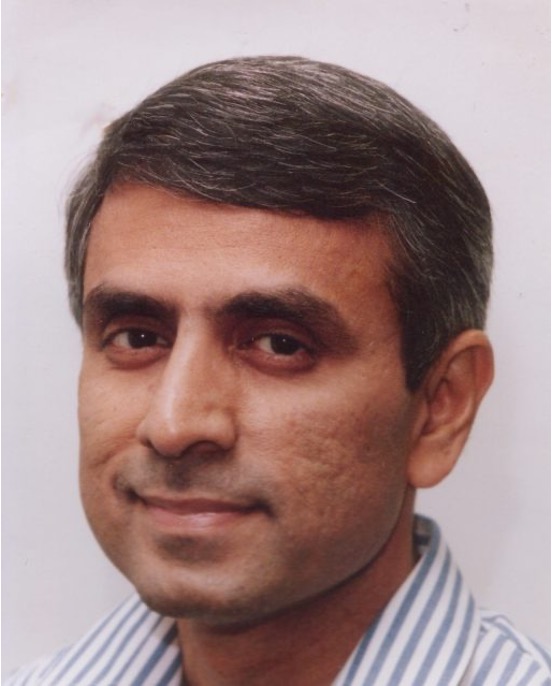
Sateesh Pedagadi
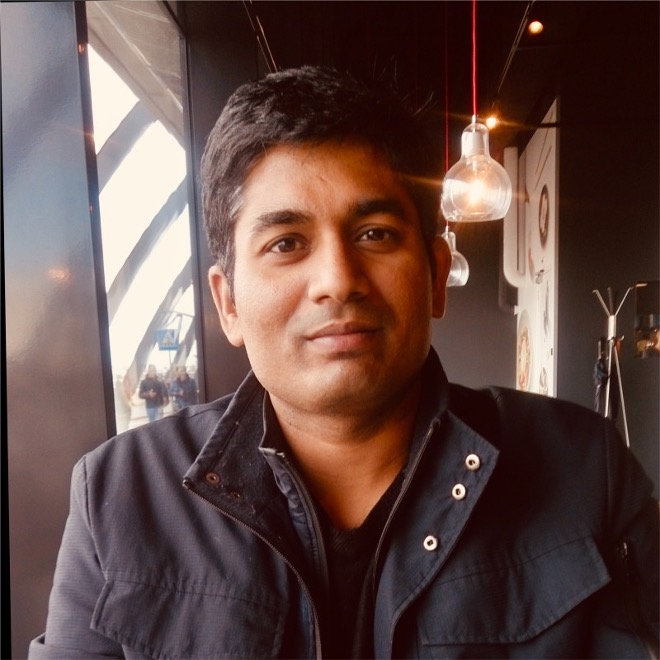
Patrick Lucey

Estimating NBA Team Shot Selection Efficiency from Aggregations of True, Continuous Shot Charts: A Generalized Additive Model Approach
Short Abstract: We develop a novel type of basketball shot chart, a true shot chart, that uses a generalized additive model (GAM) to estimate total shot proficiency continuously in the half-court as a continuous, 3-D surface ( https://sportdataviz.syr.edu/TrueShotChart/ ). Unlike conventional shot charts, which do not consider free throw scoring pursuant to a shot from a given location, true shot charts incorporate total points, from the field and free throw line, pursuant to each shot in an NBA game (from 2016-2022 in the study) toward improved explanatory power of offensive efficiency variation across NBA team-seasons. Whereas conventional shot charts show a league-wide three-point premium over the period of the data, true shot charts show a deepening dispremium since 2018, as the free throw rate for three-point attempts is substantially less than that for two-point attempts. Lastly, we develop a novel shot chart summary measure, shot selection efficiency, as the Pearson correlation between expected proportional volume and expected true points, from the field and free throw line, across the half court space; polynomial regression and XGBoost modeling suggest shot selection efficiency is not only win productive, but a “Moneyball” or partly supra-payroll source of wins.
Author(s): Justin Ehrlich

Dr. Justin A. Ehrlich is an associate professor specializing in sport analytics, machine learning, and computer science. His diverse research spans virtual reality, 3D human pose estimation, advanced visualization, ranking and rating in sports, the business of sport, and the analysis of risks associated with developing Chronic Traumatic Encephalopathy (CTE) in football players. As a faculty member in Syracuse University's Big Data Cluster, Dr. Ehrlich continues to contribute significantly to the field, focusing on big data, rating and ranking methodologies, on-field performance analysis, and advanced shot charts and visualizations. His dedication to advancing sport analytics is evident in the breadth and impact of his research contributions, including innovative approaches to understanding and visualizing player performance on the field.
Shane Sanders

Dr. Shane Sanders is a Professor of Sport Analytics at Syracuse University and an author at sportquant.substack.com. During the summer months, Sanders has done extensive consulting on player acquisition in professional basketball and has published leading academic work in sports economics, statistics, and game theory. In total, he has authored or co-authored 80+ articles in leading journals of these fields, as well as a popular economics book, The Economic Reason. His work has been cited on NPR, in USA Today, in a U.S. Supreme Court sports antitrust case, and other prominent outlets. When not thinking about himself, Sanders–along with his wife, Bhavneet–helps coach his older daughter, Simran, for various middle school spelling, math, and science pursuits. Last year, Simran qualified for and placed well at the Scripps National Spelling Bee. Sanders also helps coach his younger daughter, Nanki, in soccer skills and in her budding academic interests. Hailing from Zionsville, Indiana–”land of Brad Stevens”– Sanders and his brethren have always been disproportionately crazy about basketball. Under the influence of this so-called “hysteria,” his parents, Dennis and Debby, actually bought and maintained an old high school gym for two decades strong.
Feeling the Pressure: A Unified Framework for Automating Pass Rushing Statistics in NFL Games
Short Abstract: In spite of the importance of the pass rush in professional football, pass rushing statistics only include the final outcomes of a play, e.g., sack and pass-made. They do not capture the dynamics of the pass rush or fine-grained insights throughout a play on how much pressure a rusher generates during the rush. In this paper, we propose a unified framework that enables the estimation of defensive pressure scores throughout a play with high accuracy and performance for rusher and blocker identification, rusher-blocker match-up and pressure score estimation and show the real-world applications of our framework including enriched analytics.
Author(s): Sungmin Hong

Sungmin Hong is an Applied Scientist at Amazon Generative AI Innovation Center where he helps expedite the variety of use cases of AWS customers. Before joining Amazon, Sungmin was a postdoctoral research fellow at Harvard Medical School. He holds a Ph.D. in Computer Science from New York University. Outside of work, Sungmin enjoys hiking, reading and cooking.
Laura Kulowski

Laura Kulowski is an Applied Scientist at Amazon’s Generative AI Innovation Center, where she works closely with customers to build generative AI solutions. She holds a PhD in Earth and Planetary Sciences from Harvard University. In her free time, Laura enjoys biking and skiing.

Dan Volk is a Data Scientist at the AWS Generative AI Innovation Center, where he leverages generative AI to create novel solutions to complex problems. He has ten years of experience in machine learning, deep learning and time-series analysis and holds a Master’s in Data Science from UC Berkeley. Outside of work, Dan is a backpacker, snowboarder, mountain biker, drummer, and lifelong fan of all Seattle sports. Bring back the Sonics!

Henry Wang is an Applied Scientist at the AWS Generative AI Innovation Center, where he builds innovative GenAI solutions and co-leads Sports vertical with Dan. He holds a Master’s in Computational Science and Engineering from Harvard University. Outside of work, he loves to play golf casually and compete in tennis at amateur level.
Keegan Abdoo
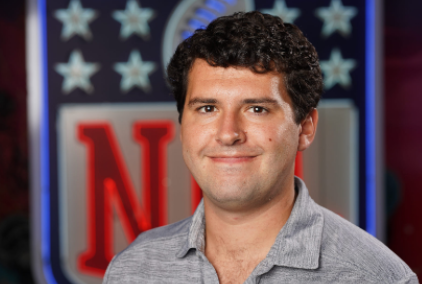
Keegan Abdoo is a Manager of Research and Analytics in the Next Gen Stats department at the National Football League. He has helped build out the Next Gen Stats platform over the last six seasons and was promoted to his current role in January 2023. Coming from a background of charting football, Keegan has strived to expand the NGS toolbox to classify more schematic data. Outside of work, he enjoys skiing, live music, and exploring all of the great restaurants Los Angeles has to offer.
Conor McQuiston
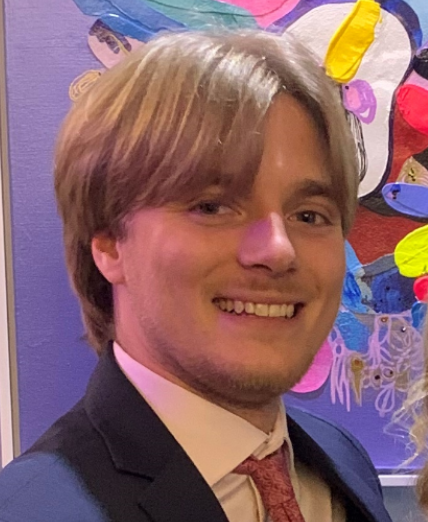
Conor McQuiston is a Research Analyst in the Next Gen Stats department at the National Football League. Since joining Next Gen Stats in October 2022, Conor has used his physics background to help the team to develop and communicate new tracking data metrics to NFL media and all 32 clubs. Prior to joining NGS, he interned as an analytics assistant with the Arizona Cardinals and as a football research intern with Pro Football Focus (PFF). Outside of work, he enjoys going to the beach, reading about history, and trying out new recipes.
Kyeong Hoon (Jonathan) Jung

Kyeong Hoon (Jonathan) Jung is a Principal Software Engineer at the National Football League. He has been with the Next Gen Stats team for the last eight years helping to build out the platform from streaming the raw data, building out microservices to process the data, to building API's that exposes the processed data. He has collaborated with the Amazon Machine Learning Solutions Lab in providing clean data for them to work with as well as providing domain knowledge about the data itself. Outside of work, he enjoys cycling in Los Angeles and hiking in the Sierras.

Mike Band is a Senior Manager of Research and Analytics for Next Gen Stats at the National Football League. Since joining the team in 2018, he has been responsible for ideation, development, and communication of key stats and insights derived from player-tracking data for fans, NFL broadcast partners, and the 32 clubs alike. Mike brings a wealth of knowledge and experience to the team with a master's degree in analytics from the University of Chicago, a bachelor's degree in sport management from the University of Florida, and experience in both the scouting department of the Minnesota Vikings and the recruiting department of Florida Gator Football.
Diego Socolinsky

Diego Socolinsky is a Senior Applied Science Manager with the AWS Generative AI Innovation Center, where he leads the delivery team for the Eastern US and Latin America regions. He has over twenty years of experience in machine learning and computer vision, and holds a PhD degree in mathematics from The Johns Hopkins University.
Measuring Individual Competitiveness and its Impact on Sporting Success
Short Abstract: Although the sports industry pours millions of dollars into understanding talent, we do not know: how to measure individuals’ attitudes towards competition, when these attitudes are formed, how they vary both within individuals over time and across individuals, and, more fundamentally, how important competitiveness is for sporting success. We measure competitiveness and answer these questions by leveraging a rich, dynamic panel dataset on hundreds of top young prospects from a renowned professional soccer academy during the decade leading up to professionalism. The ideas and methods are applicable to all other sports.
Author(s): Julene Palacios-Saracho
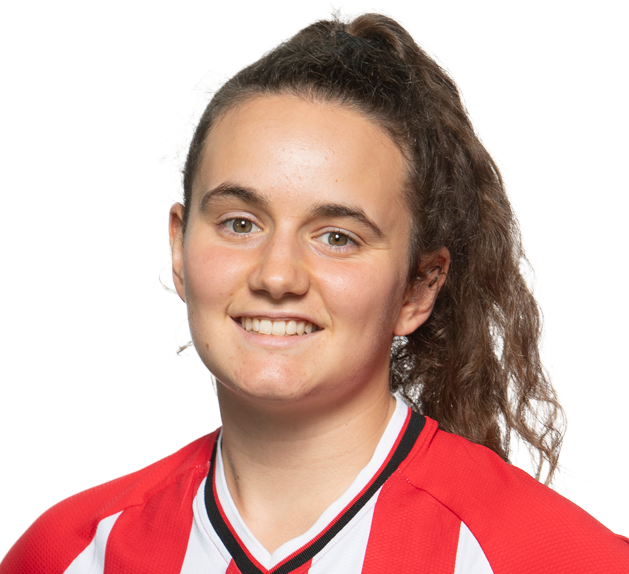
Born in Gorliz (Spain). Currently studying a joint degree BA in Business Economics and BSc in Industrial Engineering. I love two intersections: (1) between math, economics and engineering, and (2) between science and sports. Played my first game in Spain’s professional soccer leagues at age 15. My hobbies include reading science (particularly, physics) and music (soundtracks). I play soccer for Athletic Bilbao Women and I am a big fan of Athletic Bilbao.
Ander Palacios-Saracho
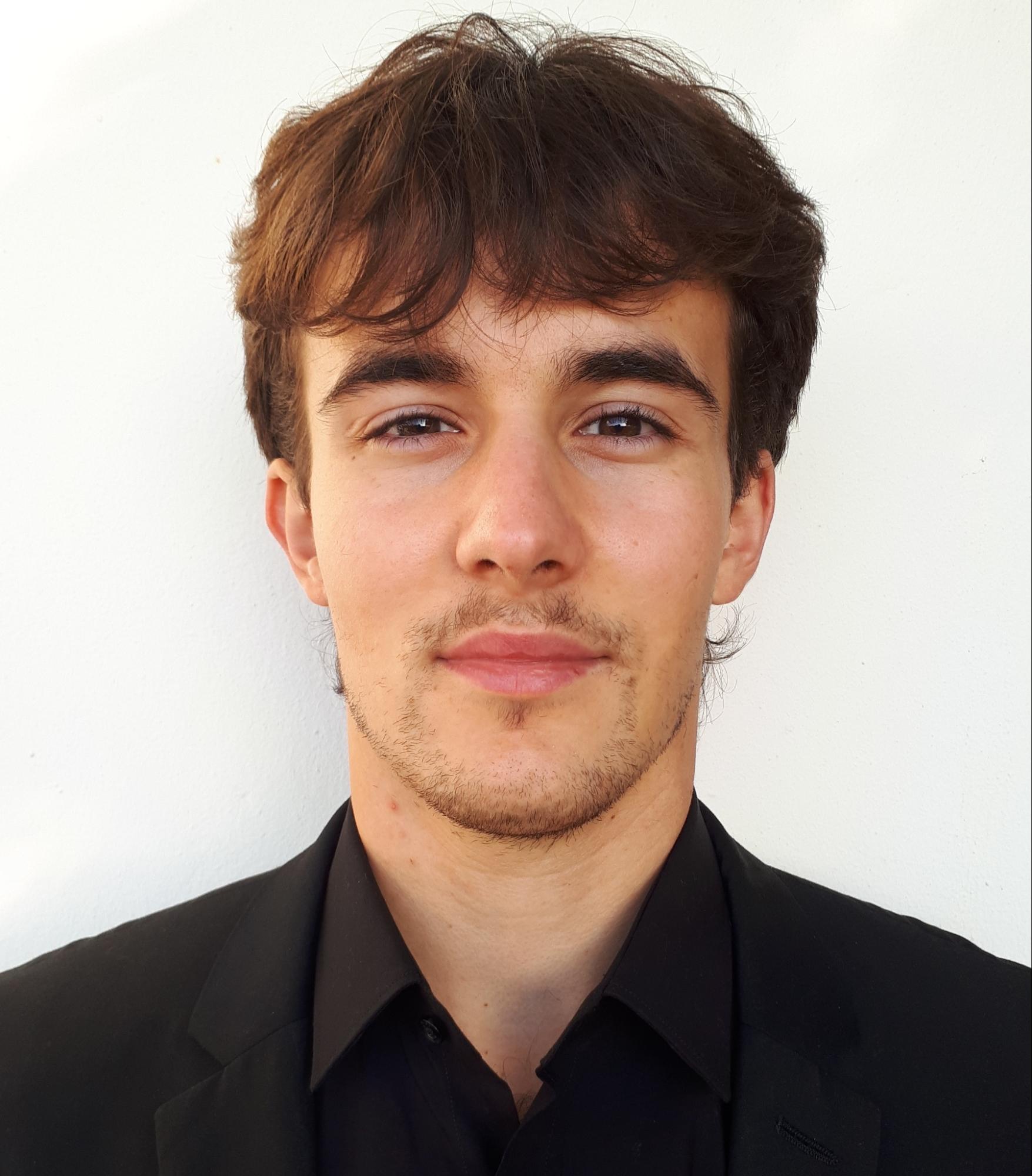
Born in Gorliz (Spain). Currently studying a BSc in Data Science and Artificial Intelligence. Fascinated by the power of data, analytics, and recent advances in technology to try to answer all types of scientific questions, in both the social and natural sciences. Hobbies include soccer, bodyboarding, and free-diving in underwater kelp forests to observe octopus. I am a big fan of Athletic Bilbao, Nottingham Forest, Liverpool FC, and Tadej Pogacar.
No More Throwing Darts at the Wall: Developing Fair Handicaps for Darts using a Markov Decision Process
Short Abstract: Darts is a popular sport that caters to players of all different abilities, and it is therefore common for opponents to have mismatched skill levels. Handicaps are useful interventions that address this mismatch, keeping the game competitive by increasing the weaker player’s chances of winning. However, the design of handicaps in darts has historically been a lot like “throwing darts at the wall” with no rigorous approach. To fill this gap, we develop a framework to model the game of darts with different handicaps, allowing us to evaluate current approaches and design a novel, fairer handicap system.
Author(s): Timothy C.Y. Chan

Timothy Chan is the Associate Vice-President and Vice-Provost, Strategic Initiatives at the University of Toronto, the Canada Research Chair in Novel Optimization and Analytics in Health, a Professor in the Department of Mechanical and Industrial Engineering, and a Senior Fellow of Massey College. His primary research interests are in operations research, optimization, and applied machine learning, with applications in healthcare, medicine, sustainability, and sports. Along with co-author Doug Fearing, he received the MIT Sloan Sports Analytics Conference research paper award in 2013. He recently got back into playing tennis and he is never going back.
Craig Fernandes

Craig Fernandes is a third-year Operations Research PhD Candidate and Vanier Scholar at the University of Toronto supervised by Profs. Timothy Chan and Ningyuan Chen. His research focuses on optimization, game theory & AI/ML techniques applied in economics, emerging markets, and sports. His research has been featured at MIT's Sloan Sports Analytics Conference (SSAC), the New England Symposium on Statistics in Sports (NESSIS), and the Sport Innovation (SPIN) Summit hosted by Own the Podium. He also previously worked as a research data scientist at Amazon and will be conducting a research visit this summer at Dartmouth College's Tuck School of Business. He picked up golf during the pandemic and is now an enthusiast.
Rachael Walker
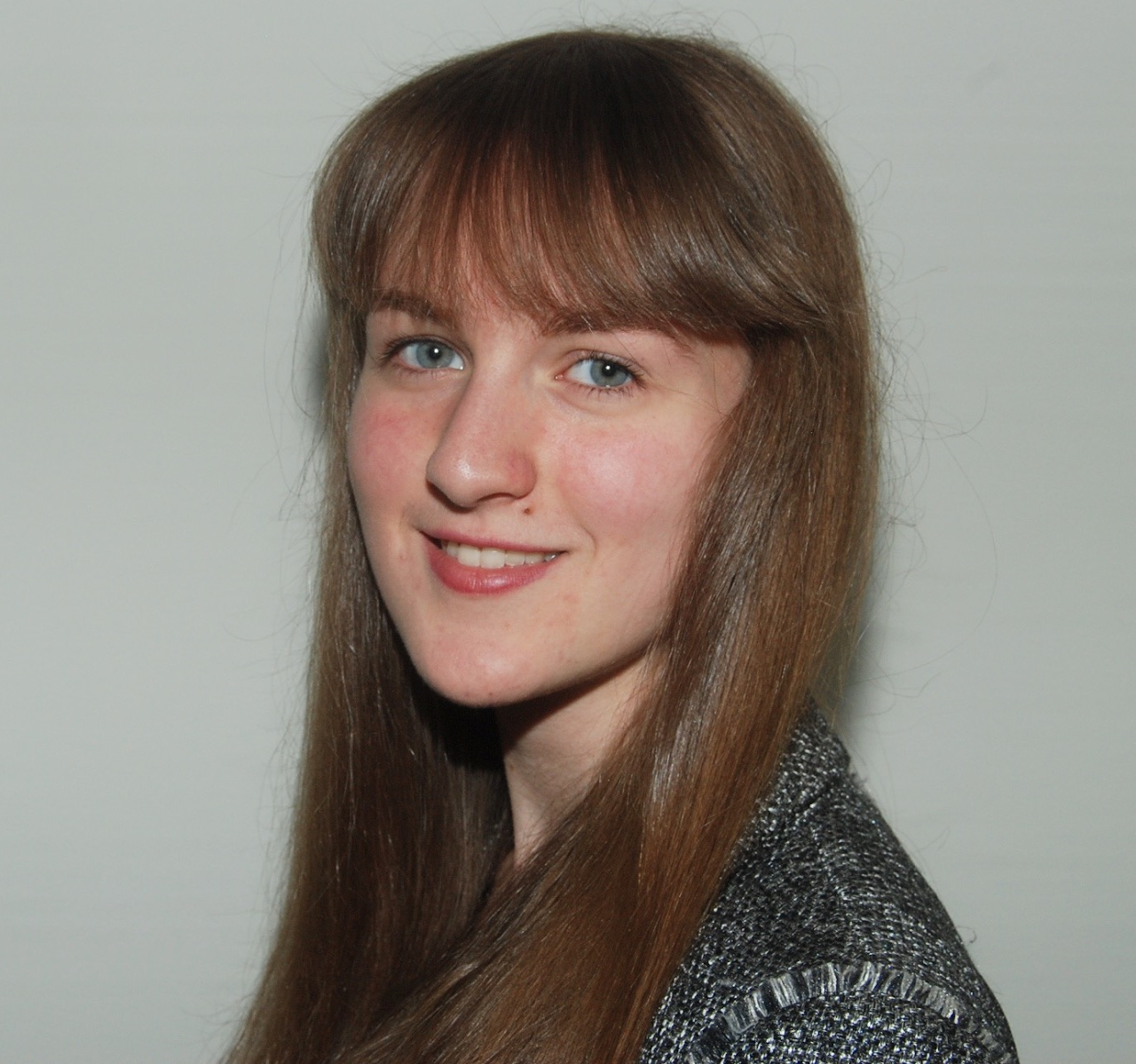
Rachael Walker graduated from the University of Toronto with a BASc in Industrial Engineering and a minor in Artificial Intelligence Engineering. For her undergraduate thesis, she researched the application of stochastic optimization models in sports. Specifically, she examined how Markov models can be used to design fair handicap systems in the game of darts. Rachael recently started a new role on the data science team at the private equity firm Birch Hill Equity Partners. She is also an undeterred fan of the Toronto Maple Leafs.
Optimizing Baseball Fielder Positioning with Consideration for Adaptable Hitters
Short Abstract: This paper presents a novel approach to positioning baseball fielders to maximize expected outs or minimize expected runs allowed against an opposing hitter. We find evidence that our positioning approach is an improvement over MLB average positioning in terms of both hits and runs allowed. We then extend our approach to adaptable hitters who adjust their batted ball strategy in response to the defense’s positioning strategy by modeling the interaction as a zero-sum game and solving for an equilibrium pair of strategies. We demonstrate two examples where the game theory model is appropriate: against shift-beating hitters who pull the ball less frequently when the defense shifts against them and against pull-heavy left-handed hitters who threaten to bunt against an extreme shift.
Author(s): William Melville

William Melville received his undergraduate degree in applied and computational mathematics at BYU in 2020 before starting a job as an analyst with the Texas Rangers. He returned to BYU in 2022 where he is currently pursuing a PhD in computer science. His research focuses on applications of game theory to baseball strategy. His passion for baseball runs much deeper than just the analytics; he also has a great appreciation for the equipment of the game and makes wooden bats in his home woodshop.
Samuel Wise
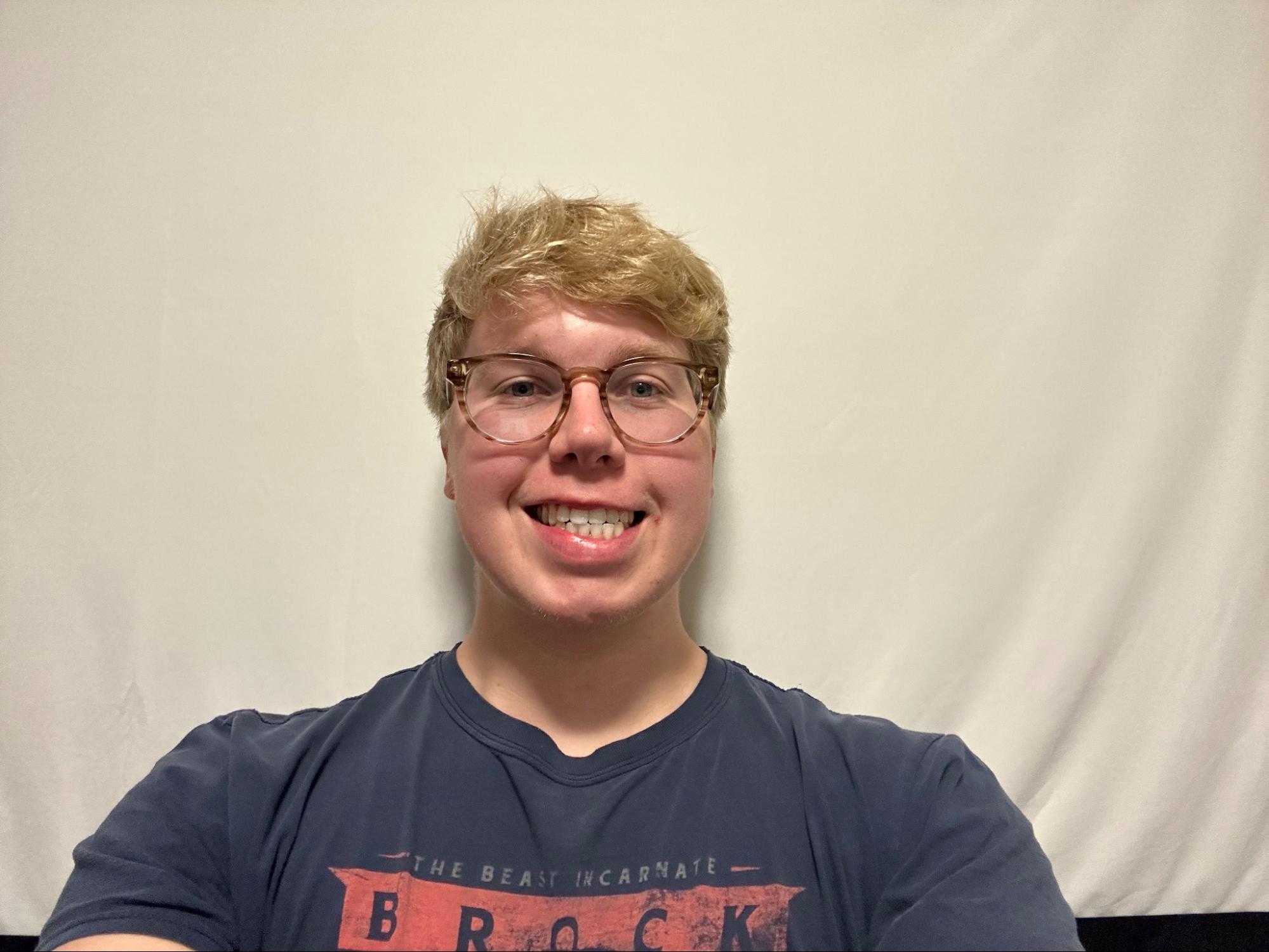
Samuel Wise is an undergraduate at Brigham Young University in his final semester as a Statistics major with an emphasis in Data Science and a minor in Economics. He is from Walnut Creek, California and enjoys exploring his passion for sports through data analytics. He recently has been interested in ranking algorithms and their applications in sports. He is an avid fan of football and the New Orleans Saints, as well as basketball and the UFC. When he is not watching sports, he is watching movies and playing video games with his friends.
Grant Nielson
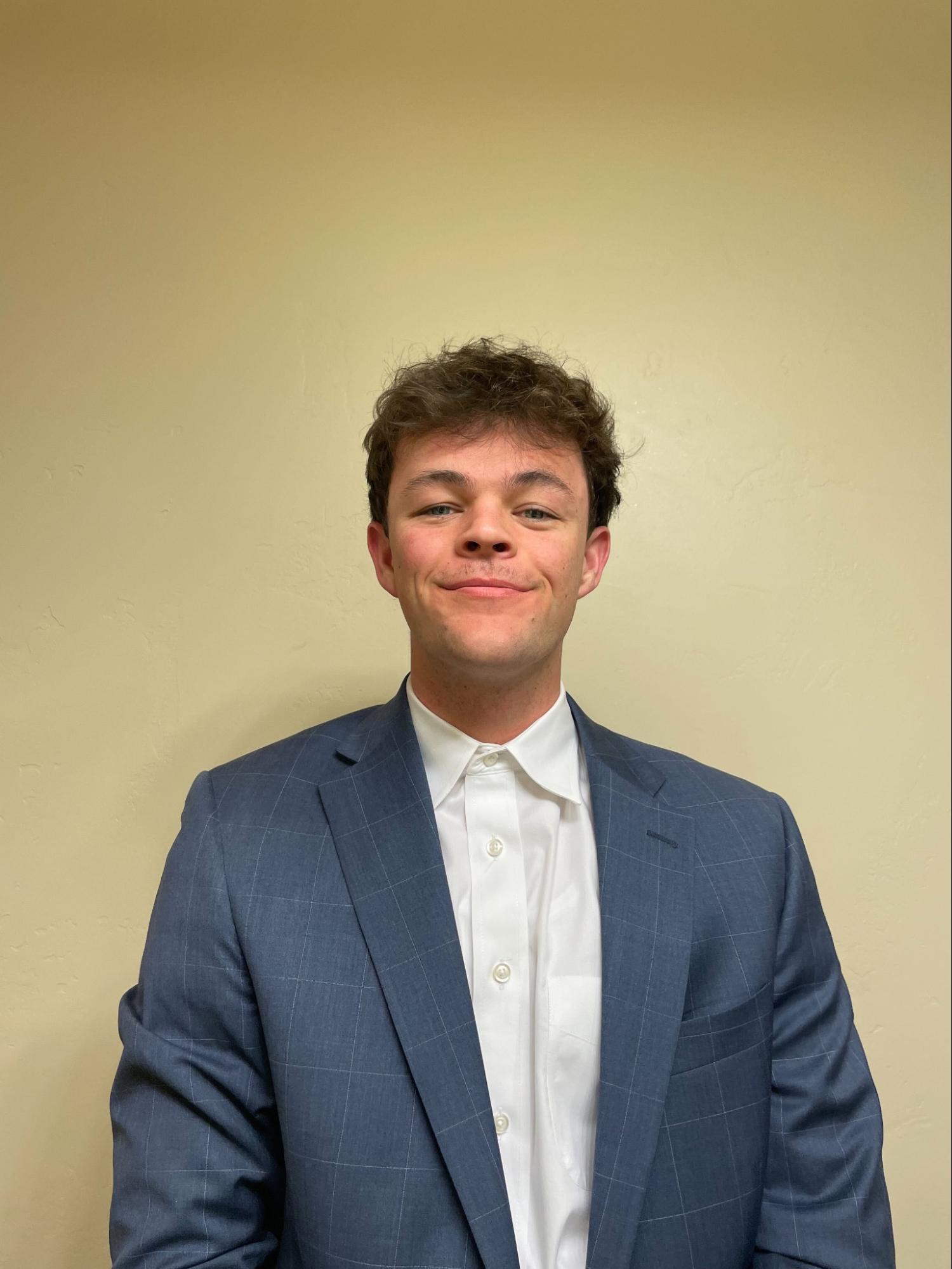
Grant Nielson is in his final undergraduate year studying Statistics at BYU. He has enjoyed this past year working on baseball projects with IDeA labs, helping him towards his goals of attending grad school and working with a major league team. Having Dallas roots, his favorite memory is watching his Texas Rangers win the World Series in person last year. He also enjoys biking along the Wasatch Front, watching Moneyball, and playing piano and basketball.
Tristan Mott

Tristan Mott grew up in Austin, TX and later moved to Alpine, UT. He enjoys spending his free time traveling, backpacking, and fly fishing. In his third year at BYU, he is working on undergraduate degrees in computer engineering (major) and computer science (minor). He is passionate about playing and watching sports and loves working on research projects for the Texas Rangers and BYU baseball teams. He aspires to someday receive a PhD in computer science so that he can make contributions to the fields of sports, machine learning, and game theory.
Christopher Archibald

Christopher Archibald is an Assistant Professor of Computer Science at BYU, where he has been since 2019. His research focuses on Artificial Intelligence and Strategic Reasoning, including Sports Analytics. He received his undergraduate degree in Computer Engineering from BYU in 2006 and a PhD in Computer Science from Stanford University in 2011 under the supervision of Yoav Shoham. From 2011 to 2013 he was a Postdoctoral Fellow at the University of Alberta under the supervision of Michael Bowling. From 2013 to 2019 he was an assistant professor at Mississippi State University. He enjoys teaching, playing games with his kids, and learning about obscure sports.
David Grimsman

David Grimsman is an Assistant Professor in the Computer Science Department at Brigham Young University. He completed BS in Electrical and Computer Engineering at Brigham Young University in 2006 as a Heritage Scholar, and with a focus on signals and systems. After working for BrainStorm, Inc. for several years as a trainer and IT manager, he returned to Brigham Young University and earned an MS in Computer Science in 2016. He then received his PhD in Electrical and Computer Engineering from UC Santa Barbara in 2021. His research interests include multi-agent systems, game theory, distributed optimization, network science, linear systems theory, and security of cyberphysical systems.
The Strain of Success: A Predictive Model for Injury Risk Mitigation and Team Success in Soccer
Short Abstract: Player injuries in soccer significantly impact team performance, club financial stability and player welfare, with the ‘Big Five’ European soccer leagues experiencing a staggering £513 million in injury-related costs during the 2021/22 season. In this paper, we present a novel forward-looking team selection model, framed as a Markov decision process and optimised with Monte Carlo tree search, that balances team performance with the risk of long-term player unavailability due to injury. We demonstrate that real-world teams could reduce the incidence of player injury by ~13% and wages inefficiently spent on injured players by ~11% using our data-driven team selection model.
Author(s): Gregory Everett
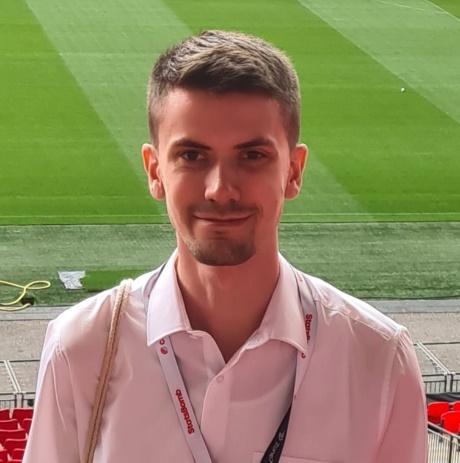
Gregory is a PhD candidate at the University of Southampton, where his research is focused on the use of AI to optimize team performance in soccer. Gregory has published papers previously in this field, focusing on optimizing collective team positioning and predicting player behaviour. He has also gained practical experience through an internship at SentientSports, and has a passion for the development of AI models to enhance the effectiveness of operational processes within soccer clubs.
Dr. Ryan Beal

Ryan is the CEO and Co-Founder of SentientSports, an AI startup dedicated to helping sports brands unlock the full potential of AI. The company specializes in providing personalized content and real-time analytics for innovative fan experiences. Holding a PhD from the University of Southampton, his research focused on AI applications in team sports, a domain in which he has published numerous papers. At SentientSports, Ryan has collaborated with many leading sports brands, including leading clubs in the Premier League and NFL. He has been recognized with a Royal Academy of Engineering 1851 Enterprise Fellowship, and his work has been featured in media outlets such as The Athletic and The Times.
Dr. Tim Matthews

Tim is CTO and co-founder of SentientSports as well as holding a PhD in Computer Vision and Artificial Intelligence from the University of Southampton. His research includes creating SquadGuru, an AI system that surpasses 99% of human players in fantasy sports. At SentientSports, Dr. Matthews leads initiatives in developing AI tools for performance analysis and fan engagement, collaborating with various European football teams, including major English Premier League clubs. His work focuses on merging advanced AI techniques with sports analytics to enhance team performance and decision-making.
Prof. Sarvapali Ramchurn
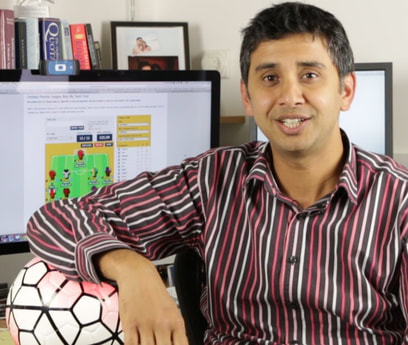
Sarvapali is a leading expert in Artificial Intelligence at the University of Southampton, with a specific focus on trustworthy and responsible AI. He is a co-founder and the Chairman of SentientSports, and also serves as the CEO of Responsible AI UK, the UK government's flagship AI program. Additionally, Professor Ramchurn directs the UKRI Trustworthy Autonomous Systems Hub and has been recognized as a Turing Fellow. His significant academic contributions are evident in his over 7000 citations, and his work has gained widespread recognition, featuring in prominent media outlets like BBC News, New Scientist, Sky News, BBC Click, and Wired.
Prof. Timothy Norman

Professor Timothy Norman is the Head of Electronics and Computer Science at the University of Southampton and serves as the director of the UKRI Minds CDT. His extensive academic career is marked by a strong focus on broader AI topics, including multi-agent systems and AI planning and scheduling. He has been involved in sports research for the past 6 years with a number of his students.
2024 Poster Presenters
How to predict the performance of nba draft prospects.
Short Abstract: We introduce a new mathematical system for predicting outcomes of NBA draft prospects based on the outcomes of other previously drafted players. This approach, which is completely general and applicable to any sport, forms predictions as relevance-weighted averages of prior outcomes using a precise and theoretically justified assessment of relevance derived from principles of information theory. Crucially, a measure called “fit” indicates in advance the unique reliability of each individual prediction and dynamically focuses each prediction on the combinations of predictive variables and previous players that are most informative for the prediction task. Relevance-based prediction addresses complexities that are beyond the capacity of conventional prediction models, but in a way that is more transparent, more flexible, and more theoretically justified than widely used machine learning algorithms.
Author(s): David Turkington

David Turkington is a Founding Partner of Cambridge Sports Analytics. He is also Senior Managing Director and Head of State Street Associates, State Street Corporation’s Cambridge-based innovation hub. Dave is the author of more than 40 peer-reviewed scholarly articles and co-author of three books: Prediction Revisited, Asset Allocation: From Theory to Practice and Beyond, and A Practitioner’s Guide to Asset Allocation. His scholarly research has garnered numerous awards, including the prestigious Harry M. Markowitz Award for his research in relevance-based prediction. Dave graduated summa cum laude from Tufts University with a Bachelor of Arts degree in Mathematics and Quantitative Economics.
Megan Czasonis

Megan Czasonis is a Founding Partner of Cambridge Sports Analytics. She is also Managing Director and Head of Portfolio Management Research at State Street Associates, State Street’s renowned innovation hub located at Harvard Square. Megan has published extensively in peer-reviewed journals and is a co-recipient of the prestigious Harry M. Markowitz Award for her research in relevance-based prediction. Megan is a coauthor of the acclaimed book, Prediction Revisited, which introduces an alternative mathematical system for forming predictions from data. She holds a Bachelor of Science degree in Economics and Finance from Bentley University.
Mark Kritzman

Mark Kritzman is a Founding Partner of Cambridge Sports Analytics. He is also a Founding Partner of Windham Capital Management and State Street Associates, and he teaches a graduate finance course at MIT Sloan. He has served on several boards including the Government Investment Corporation of Singapore, the Institute for Quantitative Research in Finance, the International Securities Exchange, The Investment Fund for Foundations, the MIT Sloan Finance Group, Protego Trust Corporation, and St. John’s University. He has published more than 100 articles in peer-reviewed journals and is the author or co-author of eight books including Prediction Revisited, Asset Allocation: From Theory to Practice and Beyond, The Portable Financial Analyst, and Puzzles of Finance. Mark has won numerous awards for his scholarly research including the Harry M. Markowitz Award for his research in relevance-based prediction. In 2004, Mark was elected a Batten Fellow at the Darden Graduate School of Business Administration, University of Virginia. Mark holds a Bachelor of Science degree in Economics from St. John’s University and a Master of Business Administration degree with distinction from New York University.
Cel Kulasekaran

Cel Kulasekaran is a Founding Partner of Cambridge Sports Analytics. He is also Managing Partner at Windham Capital Management, where he leads applied research for Windham’s asset management business and its strategic partnerships. Cel is the founding architect of Windham’s innovation arm, Windham Labs, which delivers portfolio optimization and risk management technology to investors worldwide. His research has appeared in peer-reviewed academic journals. Cel holds a Bachelor of Science degree in Mathematical Sciences with distinction from Worcester Polytechnic Institute and a Master of Arts degree in Mathematical Finance from Boston University.
Noisy Judgments: A probability surface-based analysis of umpiring variability
Author(s): Emily-Anne Patt

Emily-Anne Patt is the manager for quantitative intelligence and methodologies supporting security and resilience at Alphabet, Inc. based in Washington, D.C. Her background is in econometrics and financial economics, with prior experience in several US government agencies. Fenway Park will always be home, but these days you can find her at Nationals Park or coaching the scholar athletes at the Washington Nationals Youth Baseball Academy.
James Stockton
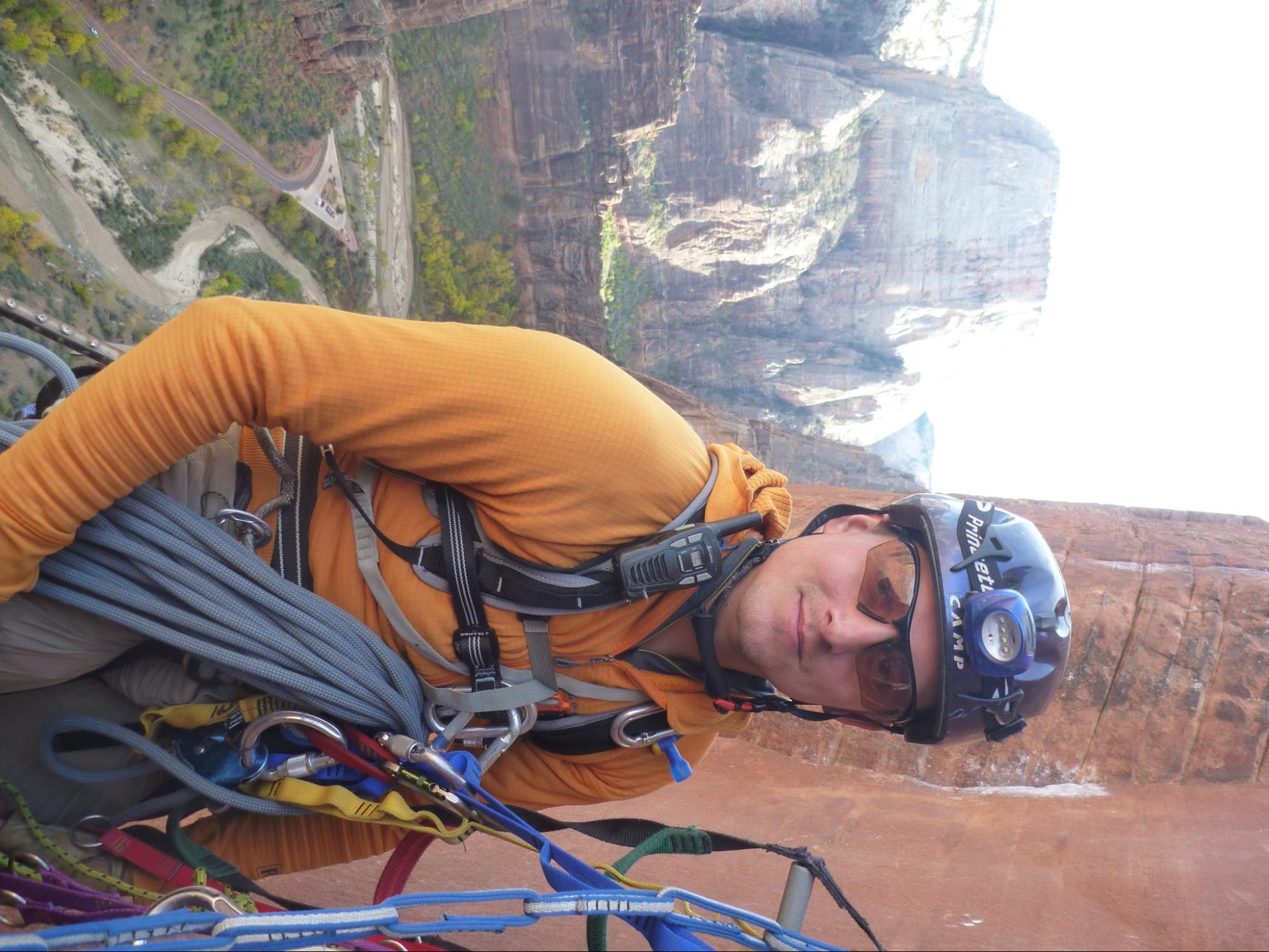
James Stockton, PhD. is the lead data scientist at Altamira Technologies supporting the United States Air Force Chief Data and AI Office based in northern Virginia. His background is in astronomy and astrophysics and he has worked as a data scientist in private industry, academia, and supported federal customers in the DoD/IC space for over a decade. He's an avid climber and mountaineer and will happily talk about mechanical advantage haul systems longer than any sane person should.
Player Pressure Map - A Novel Representation of Pressure in Soccer for Evaluating Player Performance in Different Game Contexts
Short Abstract: In Noisy Judgments: A probability surface-based analysis of umpiring variability, we establish the size, shape, and position of the strike zone as called during an MLB game by building a prior probability surface from 5.3 million called balls and strikes between the 2008 and 2022 seasons. We used this surface to evaluate changes in the actual strike zone over time, stress-testing the reliability of the model with established baseball facts related to batter and pitcher handedness and seasonal shifts. A sensitivity study shows the validity of the surface at lower pitch counts, allowing us to evaluate individual player and umpire performance across games and within a game. This analysis leads us to propose a novel methodology for evaluating a catcher's framing ability--the Framing Induced Strike Zone (FISZ).
Author(s): Chaoyi Gu
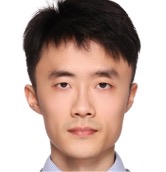
Aaron (Chaoyi Gu) received the MS degree (First class) in sports analytics and technologies from the Institute for Sport Business, Loughborough University, London, United Kingdom in 2020. Chaoyi is currently a Ph.D. from the Institute for Digital Technologies, Loughborough University, London. His research interests include machine learning, multi-agent systems, and sports analytics.
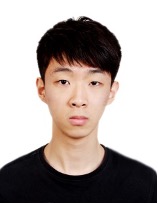
Jiaming (Jamie) Na is a PhD student at Loughborough University's Institute for Digital Technologies. With a background in statistics and a long-time passion for sports, his research centers on advancing sports analytics through computer vision AI models. His work aims to revolutionize performance analysis and strategic decision-making in athletics.
Yisheng Pei

Yisheng Pei is a third-year PhD student at Loughborough University London and a loyal Arsenal fan. His research interest lies in machine learning and deep learning applications in sports analytics, particularly soccer. He is always looking forward to understanding and quantifying players’ efforts on the pitch.n should.
Varuna De Silva

Varuna De Silva is a Reader (Associate Professor) in Machine Intelligence at Loughborough University. He directs the machine intelligence lab at Loughborough University London, where his team works on multi agent reinforcement learning, multimodal machine learning and their applications in Sports Analytics and Autonomous Systems.
A model-based risk-impact analysis of dribble actions in women's soccer
Short Abstract: Our paper presents a model-based approach to quantify individual dribbles in women's soccer based on value and risk attributes. By analyzing over 48,000 dribbles in the 2023 Women's World Cup using machine learning techniques, we measure the expected probability of success and the expected threat of each dribble. The results highlight players who outperform expectations, but can also be used to analyze the playing philosophy of different teams. The findings have implications for player recruitment and development as well as team tactics in women's football. The source code can be found on https://github.com/stefanthiem/xT_Dribbles_Pressure .
Author(s): Tobias Beckman

After completing his master's degree in mathematics, Tobias joined the European consultancy d-fine in 2019. Having played soccer enthusiastically from an early age, he quickly joined the company's sports analytics team. There, he now uses his knowledge to quantify the youth development work of soccer clubs, develop methods for match analysis and develop customized scouting platforms using modern open-source tools.
Gerhard Waldhart

Gerhard is a sports scientist and soccer analyst, currently serving as the Head of Match Analysis for VfL Wolfsburg Women, champion of the German Bundesliga in 2022 and UWCL Women’s Champions League Finalist 2023. Gerhard has been a licensed coach for 17 years and is currently pursuing a master's degree in match analysis at the University of Cologne – always looking for an added edge through data and analytics.
Stefan Thiem

Stefan is a Senior Consultant at the European consultancy d-fine, where he works as a data scientist. In his projects, he supports sports clubs gaining insights from data for match analysis and talent evaluation. He graduated from the University of Münster with a PhD in sports economics and with a bachelor’s degree in mathematics. In addition, he has been holding a soccer coaching license from the UEFA for seven years. Stefan is very passionate about sports in general and he maintains his own sports podcast, where he covers and discusses interesting scientific questions related to sports.
Oliver Wohak

Oliver is a Senior Manager at the European consultancy d-fine, where he supports his clients in tackling the most complex challenges in digital transformation. Driven by his passion for sports and complemented by his master’s degrees in physics and Business Administration, Oliver built up the Sports Analytics team within d-fine and has been supporting clubs and associations in developing internal data analytics and IT solutions for over 5 years. While his main focus is on scouting, match analysis and talent development in soccer, his experience also includes ice hockey, basketball and handball. Stemming from his time in the US, Oliver is an avid American Football fan, roots for the Eagles and especially enjoys Fantasy Football season.
Using Tracking Data to Build Offensive Line Development Tools
Short Abstract: American football has in recent years made drastic shifts towards the quantitative. The proliferation of charting and tracking data has given us the ability to better evaluate and value players, but player development has been left wanting. In this paper we use NFL's Next Gen Stats data to build tools for offensive linemen in pass protection, which will help teams more efficiently watch film, monitor performance and fitness, build rosters, and game plan, with player development as the central focus.
Author(s): Eric Eager

Eric Eager is the VP of Research and Development at SumerSports. He holds a doctorate in mathematical biology from the University of Nebraska - Lincoln, and has published over 30 papers, including three at the MIT Sloan Sports Analytics Conference. He is the co-author of the book: Football Analytics with Python and R: Learning Data Science Through the Lens of Sports.
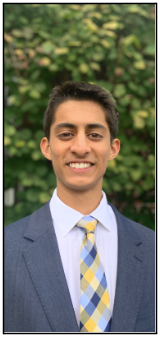
Tej Seth is a data scientist at SumerSports with a focus on football analytics. He graduated from the University of Michigan, where he worked with the football team. He is an avid Lions fan and outside of football loves listening to podcasts and going to the gym.
Ben Brown

Ben Brown is a data scientist at SumerSports. Prior to joining Sumer, he was the Head of Betting Innovation at PFF, where he won numerous DFS tournaments at both the NFL and NCAA level and hosted the PFF Daily Betting Podcast and various live streams.
Haley English
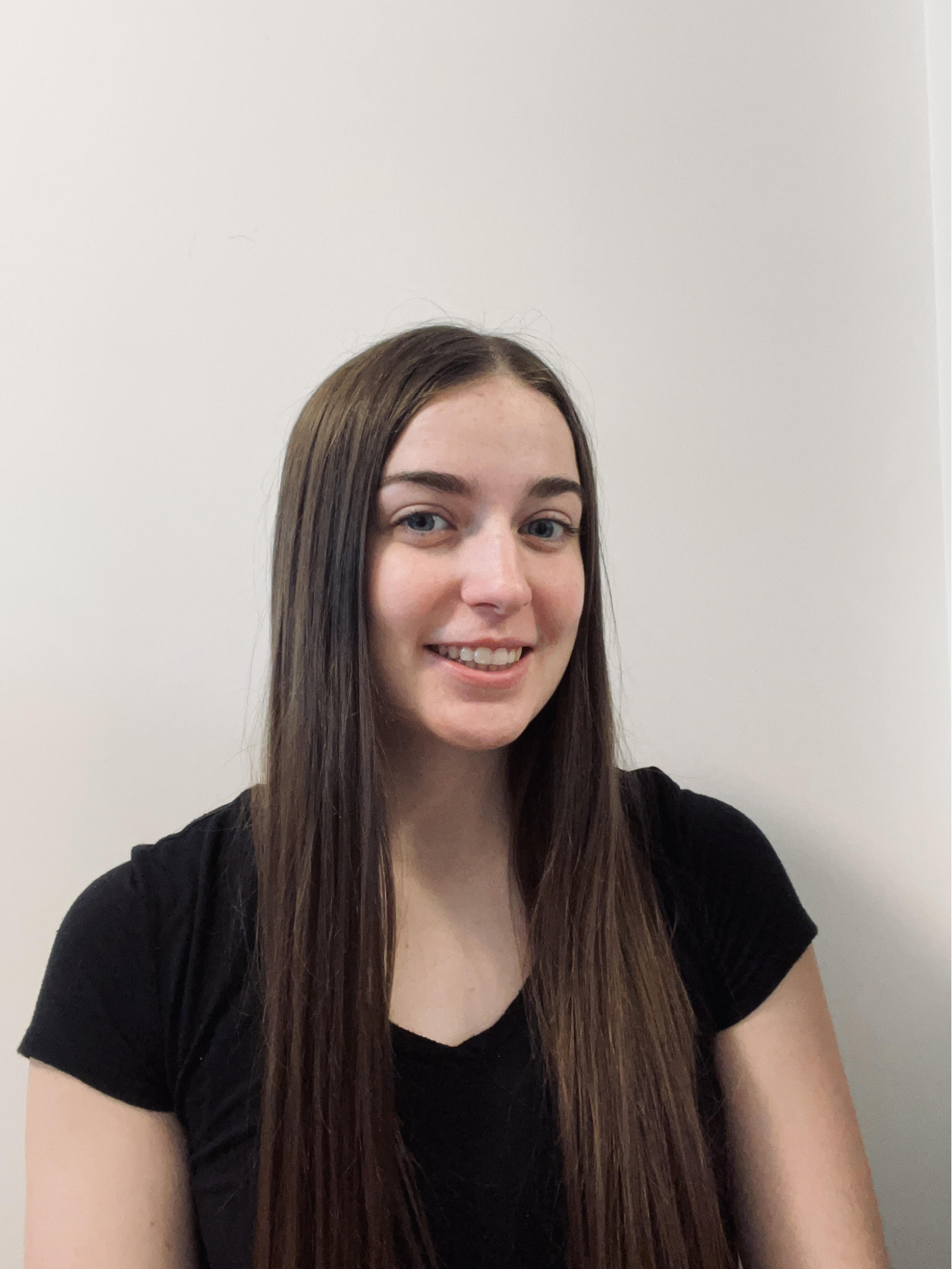
Haley English is currently a Football Information Intern with the Detroit Lions. She recently graduated from Villanova University and previously interned at Pro Football Focus. Outside of football analytics, she enjoys taking trips to the lake and watching her former sport, gymnastics.
Geoff Schwartz

From his pre-Bar Mitzvah stuttering days to being drafted 241st (out of 252) in the 2008 NFL draft, Geoff Schwartz has overcome adversity to exceed all expectations and impressively succeed in life. His eight-year career included stints with the Carolina Panthers, Minnesota Vikings, Kansas City Chiefs and New York Giants, where he signed a 4-year deal to become a starting guard on the Eli Manning-led team. Unfortunately, injuries derailed Geoff’s career and caused his retirement from the NFL in February 2017. Before his retirement Geoff began a seamless transition to a career in media. He can be heard daily on Sirius XM Radio 373 hosting PAC-12 Today and on the weekend hosting Fox Sports Radio. Geoff is a Fox Sports NFL gambling analyst, providing digital and written content. He hosts his own podcast, Geoff Schwartz Is Smarter Than You, where Geoff makes the average football fan smarter. He appears routinely on sports radio talk shows and podcasts throughout the country offering his insights on football, other sports plus a wide variety of non-sports related topics.
How Much Do Faceoffs Matter? Translating Faceoffs to Goals, Wins, and Championships in Hockey
Short Abstract: In hockey, faceoffs have long been acknowledged as important drivers of puck possession, but their actual impact on scoring outcomes remains inadequately measured. It is acceptedly evident that a center winning 54% of their faceoffs outperforms one with a 51% success rate, but the tangible extent of this advantage in terms of goals, wins, and losses remains underexplored. This research fills the void by continuing the effort to translate faceoff results to scoring outcomes, measuring faceoff performance in goals, wins, and losses in a novel manner. We explore evidence that faceoffs are an undervalued championship-caliber market inefficiency and offer models enabling General Managers to see role-specific projections of how different personnel and usage could maximize offense, defense, and championship chances.
Author(s): Tad Berkery

Tad is a senior at Johns Hopkins University majoring in Computer Science and Economics and minoring in Computational Medicine and Applied Mathematics & Statistics. He has completed research or worked directly for teams spanning the Big Ten, MLB, NHL, and NFL. Tad has also been featured in The Washington Post and is the author of What’s the “Right” Career? . In his free time, you can find him hanging out with family and friends, playing games, or trying his hand at becoming an at-home barista.
Chase Seibold

Chase is a recent graduate of Syracuse University, holding Bachelor's degrees in Economics and Sport Analytics, along with a Master's degree in Applied Data Science. During his time at Syracuse, he interned with Wasserman in the baseball department and contributed to the Washington Nationals R&D group as an intern. He is currently an R&D Analyst for the Nationals.
Max Stevens

My name is Max Stevens, and I am currently a student at Johns Hopkins University, set to graduate in May 2024 with degrees in Applied Mathematics & Statistics and Economics. Professionally, I have gained valuable experience as a Data Analyst intern at Attain Sports, a sports holding company with interests in baseball and soccer. My role involved predictive modeling for game scenarios and applying my analytical skills to enhance the business aspects of their sports portfolio. Previously, I was a member of the Johns Hopkins football team. I am a dedicated fan of Boston sports having grown up in Lexington, Massachusetts. Most recently, I have discovered a passion for European football and have pledged myself to the Tottenham Hotspur football club, COYS.

Justin is a recent graduate from Johns Hopkins who was a part of the Johns Hopkins University Sports Analytics Research Group for three years. During his time working under Dr. Anton Dahbura, he worked on projects in baseball, football, and hockey, including projects for the Baltimore Orioles and Ravens. Since graduating in May with degrees in Computer Science and Applied Mathematics & Statistics, he has been working on the AWS Cloudfront Team as a Software Developer Engineer.
Anton Dahbura

Anton (Tony) Dahbura received the BSEE, MSEE, and PhD in Electrical Engineering and Computer Science from the Johns Hopkins University in 1981, 1982, and 1984, respectively. He served as a researcher at AT&T Bell Laboratories, was an Invited Lecturer in the Department of Computer Science at Princeton University, and served as Research Director of the Motorola Cambridge Research Center in Cambridge, Massachusetts. In January, 2012 he was named Executive Director of the Johns Hopkins University Information Security Institute in Baltimore and joined the faculty of the Johns Hopkins University Department of Computer Science as an Associate Research Scientist. In September 2018 he was named Co-Director of the Johns Hopkins University Institute for Assured Autonomy. Tony has had a love for baseball since childhood. He was named to the National Under-18 Baseball Team of El Salvador, where he lived for most of his early years, and was an outfielder for Johns Hopkins as an undergraduate. In 2010 he became co-owner of the Hagerstown Suns, the low-A affiliate of the Washington Nationals.
Analyzing NBA Player Positions and Interactions with Density-Functional Fluctuation Theory
Short Abstract: Player tracking data can enhance the quantification of player abilities and our understanding of team composition and broader team strategies. In this work, we demonstrate how density-functional fluctuation theory (DFFT), an extension of a Nobel Prize-winning physics approach, can process basketball tracking data by treating players as interacting densities. By training the interactions on different play outcomes, we can evaluate play-outcome likelihoods based on player positions, determine which players are in strong or weak positions, and understand which players consistently instigate strong responses from the opposing team (i.e., ‘player gravity’). We find that our approach not only identifies the overall strengths of a player, but also identifies subtleties such as those who are left-handed (e.g., D. Russell) or who instigate changes non-locally through frequent passes (e.g., N. Jokic).
Author(s): Boris Barron

Boris Barron is a PhD candidate in Theoretical Physics at Cornell University, where he is affiliated with the Cornell Population Center. He holds a Master of Science in Mathematical and Theoretical Physics from the University of Oxford and a Bachelor of Science in Biophysics from York University. His research experience has spanned microfluidics, laser stability physics, machine learning, and increasingly complex systems in the broadest sense. Recently, he has been developing a novel framework for understanding residential segregation, with work that has included presentations at the U.S. Census Bureau, American Sociological Association (ASA), American Physical Society (APS), and the Population Association of America (PAA). His work has been funded in part by NSERC PGS-D. Beyond academia, Boris used to be a competitive ballroom dancer and is a speed typist, averaging over 120 words per minute – height limitations have prevented him from being a serious contender in basketball.
Nathan S. Sitaraman

Nathan Sitaraman is a postdoctoral associate in the Cornell Laboratory for Accelerator-based ScienceS and Education (CLASSE) and a part-time consultant for the Dallas Mavericks. He graduated from Yale University cum laude with a bachelor's degree in physics, and completed his PhD in physics at Cornell. His research focuses on improving teamwork among superconducting electrons, as well as the much more complicated problem of improving teamwork among basketball players.
Tomas A. Arias

Tomás Arias, a Professor of Physics at Cornell University, holds SB and PhD degrees in Physics from the Massachusetts Institute of Technology, where he also briefly served on the faculty in the late 1990s before joining Cornell. He is an expert in developing novel density-functional theory (DFT) methods, with thirty years of experience and more than 60 publications on this topic alone, contributing to a total of 91 publications with over 25,000 citations. His recent work involves the development of joint density-functional theory (JDFT), a specialized method for analyzing the equilibrium of liquids and solids, and density functional fluctuation theory (DFFT), which extends the theory to understand the collective behaviors of human crowds and animal groups, as well as human residential segregation and group sports.
Previous Research Paper Finalists
Full paper submission form, full paper submissions for ssac24 are due friday, december 1, 2023 at 11:59pm et., open source competition - voting.
Review our SSAC 2022 open source finalists below and cast your vote for your favorite submission HERE !
2022 Open Source Finalists
Alejandro Rodriguez Pascal, Ishan Mehta, Muhammad Khan, Rose Yu, Frank Rodriz
Matthew Wear, Ryan Beal, Tim Matthews, Gopal Ramchurn, Tim Norman
DeMars DeRover
Connor Heaton, Prasenjit Mitra
Subscribe for the latest news and updates

Bringing together the leading figures in sports analytics, business, and technology.
Your browser is not supported
Sorry but it looks as if your browser is out of date. To get the best experience using our site we recommend that you upgrade or switch browsers.
Find a solution
- Skip to main content
- Skip to navigation

- Back to parent navigation item
- Collections
- Sustainability in chemistry
- Simple rules
- Teacher well-being hub
- Women in chemistry
- Global science
- Escape room activities
- Decolonising chemistry teaching
- Teaching science skills
- Post-lockdown teaching support
- Get the print issue
- RSC Education

- More from navigation items
The science competitions your students can enter this year
By Emma Molloy
Discover STEM-themed competitions for you and your students to enter in this academic year

Source: © Shutterstock
Learn about the fantastic array of science competitions your students can enter – so you can sign up as soon as possible
There is a great range of science competitions out there that your students can enter. Competitions come in all shapes and sizes, including essay writing, photography and video competitions, and can be local or national events.
Besides the array of downloadable materials you can make use of in your lessons, as homework or part of a science club, the benefits of taking part include learning how to work in a team, grasping how lessons apply to real-world problems, and there could even be some extra cash to bag!
You can jump straight to the lists of science-writing competitions , or more arty competitions (such as photography and drawing prizes), or simply read on to discover what’s open to you and your students this academic year.
These competitions have been ordered by closing date. Listing a competition does not serve as an endorsement by the RSC. Last updated: October 2023.
UK Chemistry Olympiad
Age: 16–18 (recommended) Registration opens: September 2023 Closes: January 2024
Run by the RSC, the UK Chemistry Olympiad is designed to challenge and inspire older secondary-school students, by encouraging them to push themselves, boost their critical problem-solving skills and test their knowledge in real-world situations. Explore past papers to get an idea of the types of questions involved.
There are three rounds that culminate with the prestigious International Chemistry Olympiad , which will take place this year in Riyadh, Saudi Arabia. Round 1, a written test taken in your school, is scheduled to take place on 25 January 2024. Students then receive bronze, silver or gold certificates depending on their scores. Up to 30 students will then be selected to move on to the second round – a training weekend at the University of Nottingham. Four students will then be chosen to represent the UK in the international competition from 21–30 July 2024.
To get started, register your school or college. Do this and find out more information about preparing on the Olympiad homepage .
Top of the Bench
Age: 14–16 Registration opens: soon Closes: January 2024
Top of the Bench (TOTB) is an annual practical chemistry competition that has been running for over 20 years. It’s a long-standing favourite for students and teachers, and provides an opportunity for students to put their teamwork and practical skills to the test.
Regional heats are led by RSC local sections between October and January. The winning team from each heat progresses to the national final, held in the spring at a UK university (where there is also a session for teachers to explore resources and classroom ideas with one of the RSC’s education coordinators).
First prize is awarded to the best overall school performance, with five teams receiving runners up prizes. The Jacqui Clee Award is also awarded each year to the student who makes an outstanding individual contribution.
Teams must consist of four students: two from year 9/S2; one from year 10/S3; one from year 11/S4.
Find more information including past papers and how to apply on the TOTB homepage .
Slingshot Challenge
Age: 13–18 Registration opens: now Closes: 1 February 2024
The Slingshot Challenge is run by National Geographic and is an exciting opportunity for students to get involved with the global programme. Students can enter in teams of up to six. Individual entries are welcomed although all entries are expected to involve collaboration with peers, stakeholders, and/or marginalized communities.
Students work to prepare a short, 1-minute video, from topics with an environmental focus. Training sessions for teachers and resource/tool kits are available from the website and the providers can offer feedback and technical support ahead of official submissions.
Videos are expected to put forward compelling, evidence-based information and be engaging for the audience. A small number of motivating prizes are awarded each year to the student of up to $10,000.
For full details see the Slingshot Challenge website .
Schools’ Analyst
Age: 16–17 Registration opens: soon Closes: 23 February 2024
The Schools’ Analyst Competition is returning to schools in 2024. Run collaboratively by the Analytical Chemistry Trust Fund and the Royal Society of Chemistry, this event allows students to expand their chemistry knowledge and skills through practical analytical experiments. Students must be in Year 12 (England, Wales, NI)/S5 (Scotland)/5th Year (Ireland).
Schools and colleges register their interest to host a heat and, if randomly selected, can now enter up to 25 teams of three students to compete to be crowned the overall school winner. Each winning school team will then compete within their region to find regional winners. Regional winners receive a cash prize for themselves and their school.
Register your school to take part by 23 February 2024. To take part, students only need access to standard school laboratory equipment and some consumables (a bursary is available for those who need it).
Equipment boxes are sent to 400 entrants, selected at random, and delivered in advance of the event. Results must be submitted by 17 May in Ireland (to ensure schools have the chance to award winners before the summer holidays) and 14 June elsewhere.
Science meets art
If you have some students who would be hooked by the artistic side of science, check out these competitions:
- RSB Photography competition (open to all ages; opens March 2024; £500 top prize for under 18s)
- RSB Nancy Rothwell Award for specimen drawing (ages 7–18; open March–July 2024; prizes include set of drawing pencils and small cash prizes for students and schools)
- Science Without Borders challenge is an artwork competition with a focus on ocean conservation. The 2024 theme is ‘hidden wonders of the deep’ (ages 11–19; closes 4 March 2024; maximum prize of $500)
- British Science Week poster competition ; this year’s theme will be ‘time’ (ages 3–14; closes March 2024)
- RPS Woman Science Photographer of the Year is open to women of all ages and backgrounds (open and under 18s; closing date TBC but expected March 2024)
- Minds Underground Competitions ; Minds Underground run a number of essay competitions each year covering a variety of STEM and other topics (all ages; closing dates vary but 2024 questions will be released January 2024, see website for full details)
MathWorks Math Modeling challenge
Age: 16–19 (England and Wales only) Registration opens: November 2023 Closes: 24 February 2024
The M3 Challenge is an internet-based applied maths competition that inspires participants to pursue STEM education and careers. Working in teams of three to five students, participants have 14 consecutive hours to solve an open-ended maths-modelling problem based around a real issue during the challenge weekend, 1–4 March 2024.
The problem typically has a socially conscious theme – equity, the environment, conservation or recycling, energy use, health, and other topics that young people care about. The challenge gives students the opportunity to use maths modelling processes to represent, analyse, make predictions and otherwise provide insight into real-world phenomena. For example, 2023’s problem centred around modelling the impacts of e-bikes to better understand if they are likely to become part of a global, more sustainable energy plan.
Numerous free resources , including modelling and coding handbooks, videos and sample problems are available to help teams prepare for the event.
The competition’s final presentation and awards ceremony event is held in New York City in late April – an all-expense paid experience for the finalist teams. These top teams will be awarded scholarships toward the pursuit of higher education, with members of the overall winning team receiving $20,000 (»£16,000).
For rules, resources and to register, visit the competition website .
The Cambridge Upper Secondary Science Competition
Age: 16–18 Registration opens: now Closes: 30 September 2023 and 31 March 2024
The Cambridge Upper Secondary Science Competition , run by Cambridge Assessment, is an exciting extra-curricular activity for teams of aspiring scientists who are studying with the Cambridge IGCSE or O Level science programmes.
Teams of three to six students choose a topic and work on a scientific investigation over 20–25 hours. The competition encourages investigations with some practical or community relevance and an eye on sustainability.
Projects may involve laboratory work and should include creative and collaborative working, critical thinking and reflection. Students should be given the opportunity to present their results to a wider audience, perhaps at a science fair or other school event.
Teachers provide initial project evaluations and the best are put forward for consideration by a panel of experts. The winning team receives a certificate and is featured on the competition website. The competition runs twice a year, so keep abreast of all the dates on the website .
TeenTech Awards
Age: 11–16 Registration opens: now Closes: March 2024 for first-round submissions
The TeenTech Awards encourage students to see how they might apply science and technology to real-world problems across several different categories, from food and retail through the future of transport to wearable technology. Students identify an opportunity or a problem, suggest a solution and research the market.
Students can work in teams of up to three people and there are lots of award categories. All submitted projects receive feedback and a bronze, silver or gold award. The event is well supported with training sessions for teachers and students, so everyone knows what to expect and what the judges will be looking for!
The best projects go forward to the TeenTech Awards Final for judging and the winning school in each category will receive a cash prize. The final is expected to take place in London in June 2024.
Science writing competitions
Numerous essays competitions run each year covering all aspects and areas of STEM. Below is just a selection of some of the competitions out there. Entries into science writing competitions make great additions to UCAS applications, and they get students thinking about science, too.
- The Oxford Scientist Schools’ Science Writing Competition (700-word magazine article; ages 15–18; deadline likely to be July 2024; prize includes £50 and being published in the magazine)
- Newnham College, Cambridge (2000-word academic essay; age 16–18 women at state school only; deadline likely to be March 2024; winners receive up to £400 to split with their school). Teachers can sign up to mailing lists now to hear more about this essay competition and other events from the college.
British Science Week poster competition
Age: 3–14 Registration opened: January 2024 Closes: March 2024
British Science Week will run from 8–17 March. Alongside numerous activities and events across the country, there will be a themed poster competition – and this year’s theme will is ‘time’.
Entrants can explore a wide range of ideas covered by the broad theme. Judges are on the look out for an innovative angle or creative interpretation of the theme; clear, accurate and informative content; and effective, engaging communication. This competition is a great way for students to practise their communication skills. There are numerous prizes up for grabs that cover all age categories.
Entrants can be teams or individuals from any organisation, although schools are limited to five entries. Find out more on the website , including activity packs and other resources to make the most of British Science Week.
Big Bang Young Scientists and Engineers Competition
Age: 11–18 Registration opens: October 2023 Closes: 27 March 2024
The Big Bang Competition is open to young people aged 11 to 18 in state-funded education or who are home educated or who enter as part of a community group. Private school participants can get involved as part of a collaboration with state-school peers.
Participants complete project-based work, focusing on investigation, discovery and use of scientific methods. Students choose their own STEM topic and work to submit their project as a written report or short video. The possibilities are endless!
Students can include their involvement in the competition in their extracurricular activities on UCAS forms and personal statements and have a chance of winning a range of awards and cash prizes.
Find out how to get started and get inspired with past projects on the Big Bang website .
BIEA Youth STEAM Competition
Age: 6–18 Registration opens: October 2023 Closes: April 2024 for first-round submissions
The BIEA Youth STEAM Competition asks students to use their creativity to come up with ideas for a more sustainable future based on a specific theme. The theme for 2024 has yet to be announced, but the theme for 2023 was “developing solutions for sustainable cities”. Students research, design and present their solution, including a written report.
Students can enter as individuals or in teams of up to five members and schools can enter more than one team. There are lots of competition categories to cover all age groups. Submissions are expected to be accepted from January 2024 and the international final to be in July 2024. Learn more on the competition website .
Local to Newcastle?
Newcastle Secondary School SciFair is a university-run secondary school science fair for students from state schools across Newcastle. Sci-Fair is a whole day event that will take place during British Science Week. Students can get the opportunity to present their models, posters or PowerPoint presentations about a scientific topic of their choosing. SciFair is open to ages 11–16. There are multiple prizes to be won on the day to recognise student’s efforts. Spaces are limited capacity, so students should wait for their projects to be approved before starting work.
Unsung Heroes of Science video competition
Age: 16–18 Close s: April 2024 TBC
The International Unsung Heroes of Science video competition from Hertford College, University of Oxford is open to all 16–18 students. Entrants are tasked with making a two-minute video sharing the story of a scientist whose contributions were overlooked. Entries can be submitted by individuals or in teams of up to three.
The competition website also has lesson plans and links to videos of previous unsung heros, which are great resources for teachers to inspire their students.
Cambridge Chemistry Challenge
Age: 19 or younger Registration opens: now Closes: 1 June 2024
This competition — aimed at Year 12 students but available to younger students — is designed to stretch and challenge students beyond the curriculum interested in chemistry and is excellent experience for anyone considering chemistry for further study.
Students sit a 90-minute written paper under exam conditions in school, which is sent out to schools in advance. Mark schemes are available to teachers, and for schools submitting more than five scripts, these should be marked by the teacher. Scripts of students scoring over 50% are then submitted. Students who perform well receive a certificate and the best performers are invited to join a residential camp at the University of Cambridge at the end of August
The website contains lots of past papers and mark schemes, which are a valuable resource for teachers. Full details are on the website .
IET Faraday Challenge
Age: 12–13 Registration opens: January 2024 for the 2024–2025 season Closes: July 2024
Faraday Challenges are cross-curricular STEM activity days for UK schools run by the Institution of Engineering and Technology. This annual competition draws on students’ practical science and engineering skills, asking them to work in teams to solve real-world engineering problems and think creatively. Schools can host Challenge Days and invite teams from local schools to join them or apply to join a day at another school. Planning for these events starts early, so plenty of time to get organised for the day.
Teams should be made up of six students aged 12–13 years old (England and Wales Year 8, Scotland S1/S2, Northern Ireland Year 9). Schools may host a challenge day themselves or attend one hosted at another school.
Students win prizes for themselves and a trophy for their school. There is also a national league table and the top teams from across the UK go through to the national final, with the chance to win a cash prize of up to £1000 for their school. Plus, by taking part students will also meet the criteria for achieving a CREST Discovery Award.
If you are not able to enter into the main competition, there is also the opportunity for students to take part in the Virtual Faraday Challenge open to anyone aged 7–15.
Deadlines passed:
Imperial college science & innovation competition.
Age: 4–adult Registration opens: September 2023 Closes: 15 December 2023
The Science & Innovation Competition , run by the Faculty of Natural Sciences at Imperial College, aims to motivate primary and secondary-aged children to engage with science, to encourage them to work as part of a team and engage in fun activities. Adults are also welcome to enter.
Teams of two to four people are asked to develop a new and innovative scientific solution to help achieve one of the United Nation’s Global Goals for Sustainable Development . To enter, teams need to create a five-minute film that describes the science behind their idea. Finalists are invited to take part in an event during spring 2024 at Imperial College, London (date to be confirmed). Learn more on the website .
Global essay competition: Young voices in the chemical sciences for sustainability
Age: 35 and under Registration opens: now Closes: 31 March 2023
An annual essay competition on the role of the chemical sciences in sustainability, organised by the International Organization for Chemical Sciences in Development (IOCD) in collaboration with the Royal Society of Chemistry (RSC). The competition is open globally to entrants under 35 years of age. The theme for the 2023 competition is: How can the chemical sciences lead the stewardship of the Earth’s element resources?
Essays will be grouped into seven regions for shortlisting and selection of winners, based on the entrant’s country of normal residence. Each regional winner will receive a prize of US$500 and their entries will be published in RSC Sustainability . The shortlisted essays will be collected in an annual compendium, Young voices in the chemical sciences for sustainability , available on the IOCD’s website. Individual shortlisted entries will also be featured from time to time on IOCD’s website.
Essays will be judged on how well they highlight the importance of scientific approaches grounded in the chemical sciences for solving sustainability challenges. Entrants should take a broad, global perspective, and reflect on the intersection of science, society and policy aspects, rather than describing a particular scientific advance in great technical detail. Essays must not exceed 1500 words of body copy.
Cambridge Chemistry Race
Age: 16–18 Registration opens: Mon 5 December 2022 Closes: February 2023
In the Cambridge Chemistry Race , teams of 3–5 students solve as many theoretical problems as they can over the course of two hours – ranging from easy riddles to tasks of A-level difficulty and complex chemical problems.
Once a team has solved a question, the examiner verifies their answer and hands them the next question. Points are awarded based on the number of successful attempts. Whoever gets the most points wins!
Students are allowed to use a calculator, books, notes, and printed literature. The challenge aims to test problem-solving skills and chemical understanding rather than knowledge. Explore past questions and solutions here to get an idea of what’s in store.
Schools may only enter one team each and places are first come first served.
The competition is run in collaboration with the University of Cambridge’s Department of Chemistry. This year, it is joined by the University of Oxford too, so students may compete in either city. The competition will take place on Saturday 4 February 2023. Learn more on the competition website .
Quantum on the Clock
Age: 16–18 Closed: 8 July 2022
The Institute of Physics’ QQQ group’s Quantum on the Clock competition is open to all A-level or equivalent students in the UK and Ireland. Students are tasked to create a three-minute video about any aspect of quantum science or technology. Entries can be individual or in teams of up to four students.
Cash prizes are on offer for the winners and runners-up, with the judging focusing on creativity, clarity, engagement and accuracy. The ‘best individual’ and ‘best team’ winners will also receive year subscriptions to Physics World and an expenses-paid invitation to a prize-giving ceremony at the Photon 2022 conference dinner, which will take place from 30 August until 2 September 2022.
To find out more and apply, watch this video and go to the Quantum on the Clock website .
Clean Tech Competition
Age: 15–18 Closed: 22 April 2022 (registration); 29 April 2022 (paper submission deadline)
The Clean Tech Competition research and design challenge asks students to identify a problem with our natural world and resource use that they want to change, innovate a sustainable solution and submit a research paper to the judges. This year there is no topic restriction; entries simply need to have one goal: create a sustainable solution for an environmental issue.
This is a great opportunity to refine research, analysis and literary skills.
Each team should be made up of one to three students, who must be 15–18 years old on the submission deadline, 29 April 2022. Once the papers have been submitted, the top 10 teams from the global pool will be selected to progress to the virtual global finals. They will present their research and prototypes to the judges, and will receive handsome cash prizes, with the first team also earning a continued mentorship from an expert in the field.
Find out more and register on the competition website.
Royal College of Science Union (RCSU) Science Challenge
Age: 14–18 Closed: 11 February 2022
Imperial College London’s RCSU Science Challenge is all about science communication – requiring students to demonstrate their skills in debate and reasoning and teach the public about science and its consequences.
Questions on a given theme are set by eminent scientists – who even read the shortlisted entries, so there’s a real chance students’ work will be seen by world-leading academics. You can find last year’s (Covid-related) questions on the website .
There are both individual and team categories, and students can answer one of the questions in either written or video form of up to 1000 words or four minutes respectively. Winners receive cash prizes, plus there are non-cash prizes for the runners up.
Shortlisted candidates will be informed on 14 March 2022 and invited to the grand final on 21 March 2022 at the Royal Institution, where they will deliver a short presentation. Find more information about taking part on the challenge website .
- Competitions
- Curriculum enhancement and enrichment
Related articles

The real prize of entering STEM competitions
2020-12-10T10:23:00Z By Annabel Jenner
Both you and your students can gain a lot from participating in science competitions besides winning

Brighton College is Top of the Bench
2024-03-20T09:36:00Z By Deborah van Wyk
Winners and runners-up announced in the RSC’s 2024 Top of the Bench competition

2024 Chemistry Olympiad round one results
2024-03-01T16:00:00Z By Deborah van Wyk
Grade boundaries revealed for annual Royal Society of Chemistry Olympiad competition
9 readers' comments
Only registered users can comment on this article., more from feature.

Why fermented foods are good for your gut – and your teaching
2024-04-15T05:30:00Z By Emma Davies
From kimchi to kefir, tuck into the complex chemistry of fermentation and its health potential

Sniffing out the science of smells
2024-03-25T04:00:00Z By Hayley Bennett
What makes a bad smell smell bad? Sniff out the chemical culprits behind obnoxious odours

Strengthen your teaching practice with targeted CPD
2024-03-18T05:00:00Z By David Read
Discover why subject knowledge always packs a punch in the classroom
- Contributors
- Print issue
- Email alerts
Site powered by Webvision Cloud

- Search for: Search
- The Publisher
- Conferences
Fostering research culture among students around the world.
IRC brings forth a venue for the high school, undergraduate and graduate students to display their research writing prowess.
IRC-2023 First Round Submission Form
Article classification: -- Choose from -- Research Paper Viewpoint Technical Paper Conceptual Paper Case Study Literature Review General Review
Competition Category: -- Choose from -- Category 1 - High School Category 2 - Undergraduate Category 3 - Graduate
Extended Abstract: doc|docx
Contact details of corresponding author:
Check your email after sending your entry. You must receive an automated submission acknowledgement. First round results are communicated through email.
READ MORE ABOUT
Irc guidelines.
Be informed of the competition mechanics and guidelines.
READ PROFILE
Current finalists.
Discover who made it to the competition this year.
GET TO KNOW
Past finalists.
Know the students who were part of the competition.
Proceedings
Read and cite the articles published in the journal.
RELIVE MEMORIES
Event highlights.
Browse the previous events hosted by the Institute.
DISCOVER THE
Collaborators.
Get to know the institutions behind the various events.
About the competition
The International Research Competition (IRC) is an epitome of the organization’s commitment to knowledge and research. True to its mission, IIARI upholds the value of research and education for intellectual growth and development. IRC aims to nurture research culture among the students in various education levels.
IRC is an international competition open to all student-researchers across the globe. It brings forth a venue for the high school, undergraduate and graduate students to display their research writing prowess.
1. Objectives
The competition aims to:
- continuously develop strong research culture among students;
- provide platform for the dissemination and publication of student research outputs;
- foster collaboration among student-researchers around the globe; and
- develop camaraderie among fellows in the industry and academic community.
2. Categories
There are three categories of the competition:
Category 1 . High School Students. This competition is open to senior high school students.
Category 2 . Undergraduate Students. This competition is open to undergraduate students in any specializations.
Category 3 . Graduate Students. This competition is open to graduate students both in Masters and Doctorate levels in any specializations.
IRC has three levels namely: first, second and final round.
First round . The competitors submit the extended abstract ( download the format ) of their paper during the first round of the competition. All submissions are through the online submission form. The panel of evaluators choose the papers to continue to the second round of the competition.
Second round . The competitors submit the full manuscript of their paper ( download title page and download anonymous file ), supporting evidence (student identification, proof of enrollment or certificate of graduation) and registration fee of $40 (P2,000 for Philippine competitors). The panel of evaluators choose maximum ten (10) papers from each category to advance to the final round of the competition. All accepted papers will be published in the proceedings journal.
Final round . The top papers are called for an online panel interview. There will be one winner per category.
HOW WINNER IS DETERMINED?
First round.
The chair and co-chair vote to "ACCEPT" or "REJECT" each submission in the three categories. After the votes are casted, they will be tallied to determine any split decision. A third evaluator will be called to make the final decision on the split decision. The final number of second round qualifiers will be announced. Only the qualifiers will be sent notice of acceptance via email.
SECOND ROUND
The qualifiers will be given sufficient time to complete their paper and submit the full paper in proper format in order to register for the competition. Any qualifier who complied with all the requirements (full paper, proof of enrolment/graduation, registration fee, complete registration form) will be the second round finalists. The anonymous full papers will be evaluated by a separate panel comprising 60% of the total scores. Each category has different set of two evaluators. At the end of round two, maximum ten papers enter the final round.
FINAL ROUND
Important due dates, 1. scope of research.
There are four key areas: (1) education; (2) business and finance; (3) social sciences and (4) information technology. The competition accepts any topic within its scope and coverage. The submitted article needs to have strong empirical evidence and make significant contribution to the field. It should have strong theoretical and/or methodological literature. The submission is an original article, not have been nor considered for publishing elsewhere. The author must obtain permission for any used copyrighted materials within the article. The competition only accepts articles in English.
The total word count including references for Category 1 must be 3,000 to 5,000. Meanwhile, the Category 2 and 3 requires 6,000 to 8,000 words including references. There is maximum of 5 authors in one article.
2. Eligibility
The competition is open to currently enrolled students. Authors need to provide valid identification or proof of their enrollment. In case of a team, all the authors must be currently enrolled during the academic year at the time of the competition.
Competitors can use a previously written thesis or dissertation as part of their academic requirement by providing a written certification from the school allowing its use. The paper should have not been published nor considered for publication. Students can use academic papers written from 2021 to 2023. If in case the author had graduated, certificate of graduation should be provided.
The authors are allowed to have mentors or advisors as co-authors. Clearly specify in the manuscript if advisor.
3. Accepted papers
All papers will be published in The Research Probe , the proceedings journal. In addition, some papers can be invited to be published for free in the relevant IIARI journals. Should the author withdraw from the competition after acceptance, a written notice should be sent to the committee at least 7 days before the scheduled final round of the competition.
4. Selection criteria
The finalist in the first and second rounds of the competitions will be chosen through the following criteria:
- Strong empirical evidence - 10%
- Strong contribution to the field - 30%
- Background and related work (15)
- Methodology (20)
- Results and Discussion (20)
- Conclusion (5)
During the final round of the competition, the criteria for the selection include:
- Manuscript Evaluation - 60%
- Panel Interview - 40%

Prizes and awards
One winner will be announced per category who will receive the following prizes:
Category 1. USD100 (P5000), Certificate and Plaque
Category 2. USD150 (P7500), Certificate and Plaque
Category 3. USD200 (P10000), Certificate and Plaque
The second and third placers in each category receive certificate and medal. The winning advisor/mentor also receives certificate. The non-winners receive e-certificate of recognition.
Frequently Asked Questions
Is there any registration fee.
A: The registration fee is $40 (P2,000) for papers accepted in the second round. There is no payment for the paper submission in the first round of the competition.
What certificates I will receive?
If you register to the competition, you will automatically receive certificate of recognition (as finalist), certificate of publication (proceedings journal), certificate of presentation (conference) and certificate of training (conference).
Can I withdraw my paper from the competition?
A: Yes. You may withdraw your paper after acceptance after a written notice to the competition committee at least seven (7) days before the scheduled evaluation.
Can I submit an on-going study?
Yes. You may submit for the Round 1 of the competition. If chosen as finalist, you need to submit the full manuscript.
Can I submit a research article not within my specialization?
Yes. All papers within the competition scope and coverage can be submitted.
Can I submit a study previously conducted?
Yes. You may submit studies conducted from 2022 to 2023.
In case of a team, should all members appear in the panel interview?
All authors should appear in the panel interview except for the advisor or mentor when included as co-author.
If we have further questions and clarifications, how we can communicate with the committee?
For further queries, you can send email to [email protected] or send WhatsApp message to (+63) 916 387 3537.
Committee Members

Dr. Chong Kim Mee

Dr. Manuel O. Malonisio
Co-chairman

Dr. Seema Varshney

Dr. Ariel E. San Jose
Philippines

Dr. Amir Rezaei
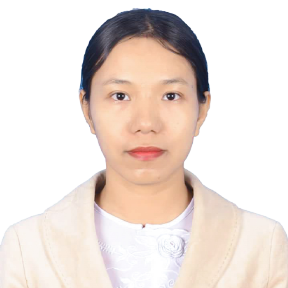
Ei Phyo Khaing

Dr. Andro T. Tabiolo

Wai Wai Than

Marilou O. Montiflor

Ts. Dr. Hamizah Mokhtar

Debbie Butch R. Pequeña

Dr. Kimouche Bilal

Dr. Helmer B. Montejo

Saifullahi Adam Bayero
Need help in manuscript writing.
The manuscript must include pertinent information of the author/s including name/s, name of school, address and email address. The corresponding author, in case of multiple authors, must be properly indicated. There is maximum of 5 authors in one article.
- Venue: Virtual Event
- Sponsorship Details
- Diversity and Inclusion
- Code of Conduct
- Student Support
- Registration
- Author Information
- Presenter Information
- Complete Program
- Your Program
- Artifact Evaluation
- Doctoral Symposium
- Industry Showcase
- Journal-first Papers
- Late Breaking Results
- Research Papers
- Social/Networking
- Student Research Competition
- Student Volunteers
- Tool Demonstrations
- [Workshop] A-Mobile
- [Workshop] ASE4Games 2021
- [Workshop] AeSIR 2021
- [Workshop] HCSE&CS
- [Workshop] IWoR2021
- [Workshop] NLP-SEA
- [Workshop] RAISE2021
- [Workshop] SUSTAIN-SE
- ASE 2021 Committees
- Organizing Committee
- Track Committees
- Artifact Evaluation Chair
- Program Committee
- Doctoral Symposium Chair
- Industry showcases Chair
- Late Breaking Results Chair
- NIER Chairs
- Research Papers Chair
- Student Research Competition Chair
- Tool Demonstrations Chair
- Contributors
- People Index
- Past Editions
Student Research Competition ASE 2021
Accepted papers.
The ACM Student Research Competition (SRC) offers undergraduate and graduate students a unique forum to showcase their research, exchange ideas, and improve their communication skills while competing for prizes at ASE 2021. The ASE SRC consists of a research abstract submission and a presentation competition during the conference. The winners of the competition at the ASE conference will get prizes and the first-place winners will be invited to participate in the ACM Student Research Competition Grand Finals to compete with winners from SRC held at other conferences during the calendar year.
Call for Contributions
Eligibility.
- To participate in the Student Research Competition (SRC), you must be an undergraduate or graduate student pursuing an academic degree at the time of initial submission.
- If you are considering submitting your existing work to SRC which has accepted or is currently under review in other venues or other tracks, we encourage you to add some novel parts other than the existing content to be considered in the competition.
- Supervisors of the work may not be listed as co-authors; for the competition, you should submit a single-authored version of your work.
How to Participate: Submit a Research Abstract
To participate in the competition, you should submit an extended research abstract related to the main ASE themes. The extended research abstract should discuss:
- research problem and motivation for the work
- background and related work
- approach and uniqueness
- results and contributions
The extended abstract must not exceed 2 pages, including all text, appendices, and figures. An additional third page is permitted only if it contains only references. All submissions must be in PDF format and conform, at time of submission, to the IEEE Conference Proceedings Formatting Guidelines (title in 24pt font and full text in 10pt type, LaTeX users must use \documentclass[10pt,conference]{IEEEtran} without including the compsoc or compsocconf option).
You must submit your SRC research abstract electronically using the submission page: ASE 2021 SRC HotCRP submission site . The review process is single-blind, i.e., the author names are visible to the reviewers.
The SRC committee members will review the submissions and select students to participate in the competition. Submissions that are accepted to the competition will be published in the ASE conference proceedings.
Competition: Presentation
If you are selected to participate in the competition, you will be invited to give a short presentation of your research to a panel of judges, which will take place virtually at ASE 2021. You will present a poster describing your work to conference attendees and leading experts in the Software Engineering field, including the SRC committee. Judges will review the posters and discuss the research with participants. After each presentation, there will be a brief question-and-answer session. The judges will evaluate the novelty and significance of your research, and the quality of your presentation, including your poster and the discussion around it. Your evaluation will be based on your knowledge of your research area, the contribution of your research, and the quality of your oral and visual presentation.

Prizes and SRC Grand Finals
The top three winners in each category (undergraduate and graduate) will be recognized during the conference and will receive prizes of US$500, US$300, and US$200, respectively.
The first-place winners of the ASE SRC are invited to compete with winners from other conferences in the ACM Student Research Competition Grand Finals. A separate panel of judges will evaluate all SRC Grand Final participants via the Web. Three undergraduate and three graduate students will be chosen as the SRC Grand Finals winners. They will be invited, along with their advisors, to the annual ACM Awards Banquet, where they will receive formal recognition.
After acceptance, the list of paper authors can not be changed under any circumstances and the list of authors on camera-ready papers must be identical to those on submitted papers. After acceptance paper titles can not be changed except by permission of the Track Chairs, and only then when referees recommended a change for clarity or accuracy with paper content.
SRC Frequently Asked Questions
Q: I am a PhD student. Am I eligible to participate in the SRC?
Yes. As a PhD student, you will compete in the Graduate category of the competition.
Q: What criteria will be used to evaluate the poster and conference presentations?
The judges will assess the poster presentations using the following criteria: Oral presentation, Visual presentation, Research methods, and Significance of contribution. For the conference presentation, the evaluation criteria are Knowledge of research area, Contribution of research, and Presentation.
Q: My research is not related to software engineering or any of the main themes of the ASE conference. Can I still participate in the Student Research Competition?
Yes, but not at ASE. To participate in the competition at ASE, your research needs to be related to the main themes of the ASE conference (see the topics for the main conference track). If your research is not among the topics relevant for ASE, please check the list of current SRC calls to find a conference that is better related.
Q: Does my extended abstract get published in the proceedings?
It depends if you are interested to publish your extended abstract. We will shortlist a list of accepted extended abstracts and the interested authors can submit their camera-ready before the camera-ready deadline to be able to publish their research. Or you can just decide to participate in the competition without publishing your research.
Additional Information
For additional information, consult the ACM Student Research Competition website or contact the ASE SRC chairs Dr Xuan Bach D. Le and Dr Catia Trubiani
Program Display Configuration
Tue 16 nov displayed time zone: hobart change.
Xuan Bach D. Le Student Research Competition Chair
The university of melbourne.
Catia Trubiani Student Research Competition Chair
Gran sasso science institute.
Barbora Buhnova
Masaryk university.
Christos Tsigkanos
Ferdian Thung
Singapore management university.
Gabriele Bavota
Software institute, usi università della svizzera italiana, switzerland.
Grace Lewis
Carnegie mellon software engineering institute, united states.
Leonardo Mariani
University of milano-bicocca.
Martina Maggio
Saarland university, germany / lund university, sweden.
Quang Loc Le
University college london, united kingdom.
Radu Calinescu
University of york, uk.
Sergey Mechtaev
Toby Murray
University of melbourne.
Weiyi Shang
Concordia university.
Huawei Software Engineering Application Technology Lab
Queens University, Kingston, Canada
This website uses cookies.
By clicking the "Accept" button or continuing to browse our site, you agree to first-party and session-only cookies being stored on your device to enhance site navigation and analyze site performance and traffic. For more information on our use of cookies, please see our Privacy Policy .
- Resources for Students
Undergrad research opportunities
Several economics associations invite undergraduates to present essays at their annual meetings and some award prizes for the best essay. Other organizations invite participation by undergraduates and provide summer and other opportunities for college students to pursue their interest in economics.
Annual Meetings that Invite Submission of Undergraduate Essays
Eastern Economic Association Undergraduate Sessions The Eastern Economic Association invites undergraduates to submit essays for presentation at its annual meeting in late Feburary or early March. The deadline for submission is early November.
International Atlantic Economic Society: Best Undergraduate Paper Competition To encourage undergraduate interest in economic issues, the International Atlantic Economic Society invites undergraduate students to compete in the IAES annual undergraduate paper competition. The winner of the student competition will receive: a $500 check, a handsome commemorative plaque, and complimentary publication of the paper in the Atlantic Economic Journal . The winner will be selected at the International Atlantic Economic Conference annual conference in October. The submission deadline is June 15.
Midwest Economics Association Undergraduate Sessions The Midwest Economics Association invites undergraduates to present their essays at special undergraduate sessions of the annual meeting each March. An award of $200 goes to the best undergraduate essay. The deadline for submission of the essay is November 15.
Missouri Valley Economic Association invites undergraduates to submit proposals to present essays at the MVEA annual meeting and provide cash awards for top essays.
Council on Undergraduate Research provides a variety of venues for undergraduates to present their research.
Carroll Round at Georgetown University is an annual conference on international economics "provides a unique forum for research and discussion among the nation’s top undergraduates."
Journals for Undergraduate Student Research in Economics
The Berkeley Economic Review is the University of California at Berkeley's undergraduate, peer-reviewed, academic economics journal, and publishes undergraduate research papers and honors theses in the field of economics, political science, public policy, business, statistics, and related fields. They also accept academic term papers, class essays, policy briefs, and op-eds. All undergraduate students currently enrolled in an accredited four-year college or university are welcome to submit content for review.
The Developing Economist is edited at the University of Texas at Austin and welcome submissions from undergraduate economists.
Equilibria: Duke Economics Review accepts outstanding papers in economics and related fields such as business, accounting, finance, marketing, public policy, and game theory. Students from all academic disciplines may submit their work.
Issues in Political Economy is edited and refereed by undergraduates and publishes essays by undergraduates. This journal is published by Elon University and the University of Mary Washington.
Undergraduate Economic Review is edited by undergraduates and publishes essays authored by undergraduates. It is based at Illinois Wesleyan University.
The Columbia Economic Review publishes essays by undergraduate with an issue each semester. It is published by students at Columbia University.
The Stanford Economic Review is Stanford's only undergraduate economics publication, accepting research papers and commentaries from all fields related to economics, including public policy, finance, international relations, business, and more.
The Student Monthly Labor Review is a pilot project by the Bureau of Labor Statistics dedicated to publishing social science research by undergraduate students. Subjects that the Student Monthly Labor Review publishes include, but are not exclusive to, demographics, labor economics, prices, environment, community research, and social statistics.
Summer Opportunities for Undergraduates
American Economic Association Summer Program and Minority Scholarship Program The American Economic Association's Summer Program and Minority Scholarship Program is now based at Howard University. A program begun in 1974, the AEA Summer Program seeks to prepare talented undergraduates for doctoral programs in Economics and related disciplines, by offering a unique opportunity for students to gain technical skills in Economics, and conduct research with prominent faculty.
Contests for Students
St. Norbert College cosponsors the iOMe Challenge , inviting teams of undergraduatres to submit an essay and a short video to illustrate some of the economic issues associated with financial security. A blue ribbon panel chooses winning teams. The top prize is $10,000 to the winning student team and $2,000 to that team's faculty advisor. The winning team may also be invited to Washington, D.C. to present their entry to Members of Congress, policymakers and other notables interested in this policy issue. There will also be honorable mention prizes of $2,500 for teams and their faculty advisors. More details and specific rules are available at the contest's website . The deadline for teams to submit the essay and video is in the fall.
Other Organizations
American Economic Association Membership in the American Economic Association includes subscription to nine journals and a reduced rate for registration at the annual meeting. The journals are the American Economic Review , American Economic Review: Insights , the Journal of Economic Literature , the Journal of Economic Perspectives , the American Economic Journal: Macroeconomics , the American Economic Journal: Microeconomics , the American Economic Journal: Economic Policy , the American Economic Journal: Applied Economics , and AEA Papers and Proceedings . The American Economic Review is published monthly and the other journals are published quarterly, with the exception of AEA Papers and Proceedings , which is published once a year in May. The AEA annual meeting happens every year in January. Economists from all over the world attend the meetings. There is also a job market for economists.
Committee on the Status of Women in the Economics Profession CSWEP, a committee of the American Economic Association, publishes a newsletter containing information that helps women keep up-to-date about what is happening in the profession.
Omicron Delta Epsilon ODE is an honorary society of economics students, organized as chapters at participating campuses. ODE honors "achievement in economics worldwide" and published The American Economist .
Council for Economic Education The Council for Economic Education is a nationwide network that leads in promoting economic literacy with students and their teachers. The mission is to help students develop the real-life skills they need to succeed: to be able to think and choose responsibly as consumers, savers, investors, citizens, members of the workforce, and effective participants in a global economy.
Graduate degrees in economics
Careers in economics.
- ACS Foundation
- Diversity, Equity, and Inclusion
- ACS Archives
- Careers at ACS
- Federal Legislation
- State Legislation
- Regulatory Issues
- Get Involved
- SurgeonsPAC
- About ACS Quality Programs
- Accreditation & Verification Programs
- Data & Registries
- Standards & Staging
- Membership & Community
- Practice Management
- Professional Growth
- News & Publications
- Information for Patients and Family
- Preparing for Your Surgery
- Recovering from Your Surgery
- Jobs for Surgeons
- Become a Member
- Media Center
Our top priority is providing value to members. Your Member Services team is here to ensure you maximize your ACS member benefits, participate in College activities, and engage with your ACS colleagues. It's all here.
- Membership Benefits
- Find a Surgeon
- Find a Hospital or Facility
- Quality Programs
- Education Programs
- Member Benefits
- Cancer Programs
- Commission on Cancer
- CoC Annual Cancer Research...
CoC Annual Cancer Research Paper Competition
The Commission on Cancer (CoC) and American Cancer Society host an annual paper competition for physicians-in-training to foster the importance of oncologic research in support of its mission.
Papers can be submitted under one of the two following categories:
Clinical Research
- Basic Science
First-, second-, and third-place winners will be selected from each category.
2024 Cancer Research Paper Competition
The 2024 Cancer Research Paper Competition criteria can be found here .
2023 Cancer Research Paper Competition Winners
First place.
Lauren Janczewski, MD, MS Northwestern University
Paper Title: Identifying Barriers to Completion of Radiotherapy: Baseline Findings of a Commission on Cancer National Quality Improvement Project
Awarded $1,000 honorarium.
Presentation | Abstract
Second Place
Mohamed Aly, MD Mayo Clinic Arizona
Paper Title: Long-Term Survival After Surgical Resection for Rectal Cancer is Associated With Textbook Outcome but Not Surgical Case Volume
Awarded $500 honorarium.
Third Place
Paper Title: Volume Isn’t What It Used to Be - Reconsidering the Minimum Case Volume Threshold for Lung Cancer Resection
WHAT IS THE HIGH SCHOOL ACADEMIC RESEARCH COMPETITION?
Running through March and April, SARC is more than just a contest—it’s a guided immersion into the research process, designed for experts and newcomers alike!
You’ll enroll in immersive workshops that guide you through the research process from beginning to end and prepare you for your own research proposal.
Participants compete with the sharpest young minds around the world.
THE HIGH SCHOOL
Academic research, competition.
Due to popular demand, we've extended Registration for SARC 2024 till Sunday, April 21st!
RESEARCH TOPIC
SARC is unique in that participants can research any topic they want! This competition is not limited to the sciences. Your research topic can range from political science, art, and economics to engineering, history, or any other field of interest.
Researchers can choose a topic they’re passionate about, something they wish to dive deeper into, or something they want to study in university.

registrations open
registrations close
Submission of
assessment form
Participant-
exclusive bootcamps
Qualification Round
Winners announced
Video Pitch
submission deadline
Global Winners
WHAT ARE LAST YEAR'S WINNERS SAYING?

Yike Zhang, Top 10 Finalist, SARC 2023
“Participating in the High School Academic Research Competition (SARC) was a truly incredible and transformative experience for me. What made this competition stand out was its inclusive approach, which allowed participants to conduct research on any topic of their choice. Moreover, the admin team hosted informative bootcamps, gave access to academic research resources, and created a community of like-minded peers.”

Krishnaaram Muthukumaran, Top 10 Finalist, SARC 2023
“SARC was an amazing experience. The workshops conducted were invaluable in guiding me through the research journey as a beginner, from formulating a research question to crafting a proposal. The resources & workshops provided a solid foundation for understanding the research process. Connecting with equally motivated individuals worldwide made it a truly invaluable learning opportunity.”
EXCLUSIVE BOOTCAMPS
At SARC, we host participant exclusive bootcamps with experts in the field to prepare you for your research proposal and give you insight into this field.

Indigo Research is an online program that lets high school and graduate students research the topics that fascinate them. At Indigo, students build expertise, deepen their intellectual curiosity, and stand out on their college applications through advanced research. Over 300 students have worked with Indigo since 2019, and over 170 have achieved acceptance to Oxbridge and top 10 universities in the United States.

Crimson Global Academy (CGA) is an internationally accredited, world-class online private school delivering live, real-time learning to students all over the world, enabling them to earn university recognised qualifications through accelerated courses.

Crimson Education is the world's leading US, UK, EU and Postgrad admissions counselors. In 2013, it was founded by three students, including CEO Jamie Beaton who had just been accepted to 25 of the world's best universities. Our mission is to help students all over the world reach their ultimate university admissions goals.
- Skip to main navigation
- Skip to main content
College Center for Research and Fellowships
- Our Students, Their Stories
- Undergraduate Research
- National Fellowships
- Collegiate Honors & Scholars
- CCRF Seminars: The Common Year
- CCRF General Resources for Students
- CCRF Resources for Faculty & Staff
- Connect with Us
Search form
Icpsr data communication scholarship, opportunity description:.
Students from ICPSR member institutions are eligible to win scholarships of $1,000 (first place) or $750 (second place) for creating a short video to promote a study in the ICPSR catalog. Realizing that coursework requirements and assignments have changed since the ICPSR Paper Competition was launched in 2007, we are giving the competition a major facelift to better match what students are being asked to do in an era of more creative, less traditional assignments. Upon completing the video, students should have gained experience navigating and searching ICPSR , identifying data of interest, and using the information provided for each study to determine potential uses of the data.
Formerly known as the ICPSR Research Paper Competition.
Minimum Qualifications and/or Eligibility Requirements:
What to Submit:
- An entry form that includes information about the submitter(s) and the data.
- The link to a video, no longer than 2 minutes in length, that describes an ICPSR study that gives the viewer a “run down” of the important points and a glimpse at potential uses. Details about what to include can be found in the “Preparing Your Entry” section.
Preparing Your Entry:
- To be eligible, students must attend a school that is a member of ICPSR. If you are unsure whether your school is a member, please check the member list .
- Students entering the competition must graduate or have graduated no earlier than April 1 of the year prior to submission. For example, students entering in 2024 have to graduate April 1, 2023, or later.
- Studies chosen for the videos must be part of ICPSR's curated collection. Specifically, studies found in OpenICPSR and studies with a description that contains a link to another site from which to get the data are not eligible. Note: some study description pages point to the project’s website for further description – that’s okay, as long as you can download the data from the ICPSR page (clicking on download lists files in formats such as SPSS, Stata, SAS, R, and ASCII or CSV as well as documentation files).

- We encourage you to search all of the collection, but you can also start your search with only the eligible studies .
Application Process:
Papers must be submitted electronically via the ICPSR Research Paper Competition Entry and Publication Release Form .
Application Deadline generally falls on January 31.
Research Opportunity Details
- Request Info
- Financial Support Resources
- Home / Student Success Center / Financial Support Resources
We know it can be difficult to find resources to help pay for your education. We've compiled all the resources you need to help you navigate graduate student funding, from scholarships to awards and competitions.
- HCAP Scholarships
Scholarship applications available through the UTSA Scholarship Hub .
Scholarship applications are open February 1 st through April 1 st .
- Most Outstanding Student Award
The College for Health, Community and Policy is now accepting nominations for the Most Outstanding Graduate Student and the Most Outstanding Undergraduate Student in the College. The purpose of the award is to recognize HCAP students who have built a record of scholarship, leadership, and service to UTSA, the college, and/or the community.
- Research Paper Competition
This competition is open current HCAP students. Only papers sponsored by the faculty member teaching the class for which the paper was written will be accepted. Submissions are limited to papers related to scholarly research. This includes original research or reviews of existing research or literature. Thought papers or creative writing efforts are not appropriate submissions for this competition. Only one submission per student will be accepted. Additional eligibility requirements listed on the application.
- Thesis/Dissertation Award
The college would like to offer HCAP graduate students who are currently enrolled and pursuing a thesis or dissertation financial support to complete on time. Additional eligibility requirements listed on the application.
- Graduate Student Travel Support
HCAP provided travel support:
Current HCAP graduate students may apply for funding support for travel to present at an academic conference. Additional eligibility requirements listed on the application.
- September 30th for Fall or later travel
- January 31st for Spring or later travel
- April 30th for Summer travel
- Award must be received prior to travel dates
Graduate School provided travel support:
Apply for travel support through the Graduate School application
Eligibility and details
Applications must be complete and submitted to The Graduate School through the online application portal. Please direct any questions to [email protected] .
The awarding process takes place twice in the fall semester, twice in the spring semester, and once during the summer. Students should submit their application:
- Fall semester submission: September 1; November 1
- Spring semester submission: February 1; April 1
- Summer semester submission: July 1
Allow 30 days past the semester deadline(s) for application review and award disbursement.
- Student Success Center
- Services Tutoring Tutorme.com Peer Mentoring Workshops
- Internships
- Programs Undergraduate Master's Programs Doctoral Programs Certificate Programs Concentrations
- Graduate Student Resources
- Request Info Visit Apply
- College Forms
- Graduate School Resources
- Student Health Services
- Military Affiliated Students
- Campus Resources
- Doctoral Assistantships
- Letter of Degree Status Request Form
- Independent Study Course Form
- Petition for GRA Enrollment Waiver
- Petition for Admission Deferral
- Intent to Write a Thesis
- Student Forms
- Graduation Application for Graduate Certificate
- New Admit Orientation
- Current Graduate Catalog
- Thesis and Dissertation Assistance
- Graduate School Forms
- Doctoral Student Forms
- Graduate Student Policies
- Petition for Reinstatement
- Grievance Process
- 24/7 Assistance
- UT Student Health Insurance Plan
- Medical/Mental Health Withdrawal
- Office for Military Affiliated Students
- Document Uploader
- Contact List
- Student Disability Services
- Student Technology Support
- Adobe Creative Campus
- Campus Housing
- Campus Dining
- Recreation Center
- Parking Services
- Transportation Services
- Campus Maps
- Social Media Directory
- Student Resource Toolbox
- Graduation Information
- How To Guide
- One UTSA Circle
- Main Building 2.306
- San Antonio, TX 78249
- 210-458-7900
Stay Connected to the College for Health, Community and Policy (HCAP)
The mission of the College for Health, Community and Policy (HCAP) is to develop solutions to affect change for complex social issues to improve the well-being of communities and the world. We aim to accomplish this mission through exceptional education, creation and dissemination of knowledge, and partnership with communities and institutions from local to global.
Upcoming Summer 2024 Application Deadline is May 12, 2024.
Click here to apply.

Featured Posts
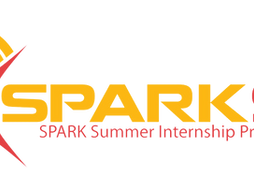
10 Software Engineering Programs for High School Students
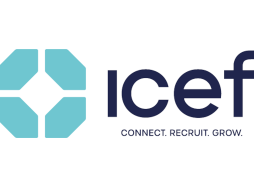
8 ICEF Conferences You Should Be Attending as an Educational Consultant

11 Ways to Use AI Ethically in the College Admissions Process

NYU's Science and Technology Entry Program (STEP) - Our Review

10 Animation Summer Programs for High School Students
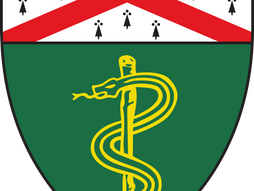
Discovery to Cure (DTC) High School Internship - Is It Worth It?
PCACAC's 2024 Conference - Should You Attend It?
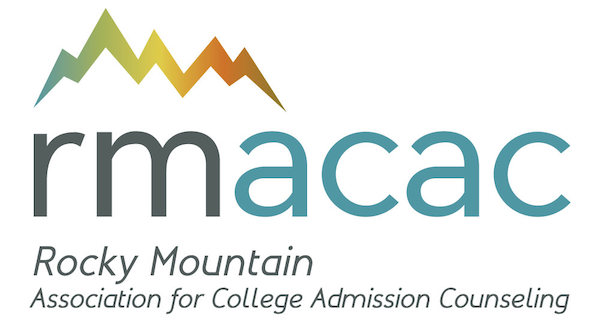
RMACAC's Conference in 2024 - Should You Attend?
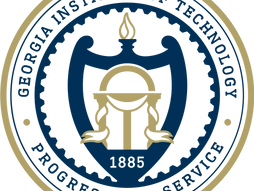
CEISMC's Summer P.E.A.K.S Program At Georgia Tech - Is It Worth It?

10 Kinesiology Summer Programs for High School Students
15 Research Competitions for High School Students
Students benefit from participating in research competitions in a variety of ways, including learning how to present their findings and gaining experience in an important field of their interest. Competitions are not only a strong extracurricular activity, but reaching the finals can also help students earn college scholarships. Being a significant achievement, it may even open opportunities, such as laying the groundwork for a career in research and helping one land an internship.
It also aids them in becoming competitive candidates for college admissions by demonstrating students' intellectual prowess and capacity to work on a rigorous project, either individually or as part of a team. Even if they don't win or place in the competition, students can use their participation to demonstrate what they have learned about their chosen academic field and how they have explored their passion for the discipline.
In this post, we have compiled a list of 15 well-respected research competitions that are sure to boost your high school profile.
Here are 15 Research Competitions for High School Students:
1. Regeneron Science Talent Search
This talent hunt, which began in 1942 as a program of the Society for Science & the Public (the Society), is widely regarded as the nation's most renowned high school science research competition. Young scientists present their original findings to a panel of nationally recognized professional scientists as part of the competition. 300 Regeneron STS scholars are chosen from 1,800 applicants, and they and their schools are each granted $2,000. From the group of scholars, forty finalists are chosen, who get an all-expenses-paid trip to Washington, D.C., and compete for another $1.8 million in prizes, including a top prize of $250,000.
2. MIT THINK Scholars Program
Most research competitions require participants to have already completed the project, but the THINK program is different in that students only need to have completed background research for a project in the science, technology, or engineering fields before applying. Those whose projects are selected receive $1,000 funding and mentorship from MIT students. They also get a paid trip to MIT's campus to meet professors in their field of research, tour labs, and attend MIT's xFair. Students in grades 9th to 12th are eligible.
3. Google Science Fair
Students aged 13 to 18 submit science research ideas to be judged by a panel of scientists and experts in this competition. At various levels, victors are rewarded generous scholarships, cool gear, and unique opportunities such as internships. Past projects include battery-free lighting and wearable sensors to improve the safety of Alzheimer's patients.

4. AAN Neuroscience Research Prize
The nervous system/brain is the center of this competition, with students investigating and solving problems linked to it. Students do their own neuroscience research, which is evaluated based on its relevance to neuroscience, originality, data interpretation, and research reports. The competition is open to students in grades 9 through 12, and only individual entries are accepted.
5. Odyssey of the Mind
This challenge encourages high school students to think outside the box by identifying problems and developing innovative solutions. After a school or community group purchases membership, they qualify for the competition, which takes place at the regional, state, and national levels. The competition is open to students from grades 9th to 12th. 6. International BioGENEius Challenge
Recognizing outstanding research in biotechnology, this challenge gives students the opportunity to win cash awards for their work. Finalists present their research before a panel of expert biotech judges. Students receive the unique opportunity of being able to meet top industry professionals and gain valuable advice and insight on their projects.
7. Davidson Fellows
Students 18 and under who have completed a project in one of several subjects, including STEM, are eligible for the Davidson Fellows Scholarship, which awards $50,000, $25,000, and $10,000 scholarships. It's a prestigious and competitive scholarship to obtain, and the projects the recipients generate are frequently on par with those produced by college graduates. Research projects should "contribute a work that is acknowledged as an extraordinary accomplishment by experts in the field and has the potential to benefit society."
8. ExploraVision
The Toshiba/NSTA ExploraVision initiative is a competition for students to improve their STEM skills. Participants research a current technology and then envision what it will look like in 20 years, including development processes, benefits and drawbacks, and challenges. Students work in groups of 2-4 with the help of a teacher who serves as a mentor.
9. Regeneron International Science and Engineering Fair (Regeneron ISEF)
As the premier science fair in the United States, Regeneron ISEF is one of the best-known high school science competitions. Even ranking within the top 100 is enough to help one's university application stand out.
Unlike Regeneron STS, students can't apply directly to the ISEF. Instead, they have to first participate in a regional science fair. Doing well there helps the student qualify for the next ISEF rounds. Key factors for winning include innovation and originality. To show originality for the ISEF, students need to tackle a problem that's interesting to the scientific community. It is important to have a good overview of academic science literature in the field that one's project is in, and it helps to have a professional academic scientist or engineer as a mentor.

10. Stemanities Research Competition
A national competition, this event invites students in their freshman, sophomore, junior, or senior year to conduct research in STEM and the humanities to develop a more sophisticated understanding of a topic. Stemanities is sponsored by the Institute for Biomedical Sciences, and finalists are invited to La Jolla, California to present their work and compete for monetary awards.
11. Destination ImagiNation
For students who have a penchant for problem solving, Destination ImagiNation helps one refine their critical thinking skills. An international competition for students in kindergarten through college, Destination ImagiNation teaches life skills while encouraging imagination, through problem solving, creativity, and research. In this competition, students work in groups of five to seven to develop solutions to Team Challenges.
12. Stockholm Junior Water Prize
Students compete in this competition to provide solutions to the world's present and future water problems. State winners receive a medal and an all-expenses-paid travel to the national competition at The Ohio State University. Previous winning themes at the state level include "Protecting the Aquatic Environment from Household Microfibers" and "Optimizing Straw Mulch Use in Agriculture." A $10,000 scholarship and a free ticket to the international competition in Stockholm, Sweden are awarded to the national winner. The international winner receives a prize of $15,000 for themselves and $5,000 for their school.
13. TOPPS Competition for High School Psychology Students
Students write a 3,000-word essay on a specific topic, using peer-reviewed psychological research. "Non-human animals in psychology" was the research theme for 2019. Four winners are selected for a prize of $250. Students from grades 9th to 12th are eligible to compete.
14. Clean Tech Competition
Students must identify a problem with our natural world and resource consumption that they wish to address, develop a sustainable solution, and submit a research paper to the judges as part of the Clean Tech Competition research and design challenge. There are no topic restrictions; entrants must just have one goal: to develop a long-term solution to an environmental problem.
Each team should consist of one to three students who must be between the ages of 15 and 18 at the time of submission. Following the submission of papers, the top 10 teams from the worldwide pool will be chosen to compete in the virtual global finals. They'll submit their research and prototypes to the judges and win cash awards, with the winning team receiving continued mentorship from an expert in their field.
15. Junior Science and Humanities Symposium
This scholarship competition encourages students to pursue research in the fields of science, engineering, technology, or mathematics. Students can submit their original research findings in front of a judging panel and their peers at the symposia. Furthermore, attending regional or national symposia provides students with a variety of opportunities, such as seminars, panel discussions, career exploration, research lab visits, and networking events.
How to select which research competition to participate in:
While the above list includes a number of prestigious competitions, it is definitely not exhaustive in nature. If you don't find one that fits what you're looking for, it is encouraged to find one that does, with careful research! Be sure to use your judgment when considering unknown competitions, and only select those that have ample information about them transparently available. Be sure to also look out for competitions that charge unnecessarily high fees to participate.
Typically, older and national competitions are better known and have a larger chance of standing out on college applications. It is also important to remember that a cash prize may not be the only criteria to decide on what competition is worth participating in. Several competitions also give out other benefits to winners, such as mentorships and invitations to conferences, each of which are equally important as a stepping stone in a student's research career aspirations.
Additionally, you can also work on independent research in AI to present at these competitions, through Veritas AI's Fellowship Program!
Veritas AI focuses on providing high school students who are passionate about the field of AI a suitable environment to explore their interests. The programs include collaborative learning, project development, and 1-on-1 mentorship.
These programs are designed and run by Harvard graduate students and alumni and you can expect a great, fulfilling educational experience. Students are expected to have a basic understanding of Python or are recommended to complete the AI scholars program before pursuing the fellowship.
The AI Fellowship program will have students pursue their own independent AI research project. Students work on their own individual research projects over a period of 12-15 weeks and can opt to combine AI with any other field of interest. In the past, students have worked on research papers in the field of AI & medicine, AI & finance, AI & environmental science, AI & education, and more! You can find examples of previous projects here .
Location : Virtual
$1,790 for the 10-week AI Scholars program
$4,900 for the 12-15 week AI Fellowship
$4,700 for both
Need-based financial aid is available. You can apply here .
Application deadline : On a rolling basis. Applications for fall cohort have closed September 3, 2023.
Program dates : Various according to the cohort
Program selectivity : Moderately selective
Eligibility : Ambitious high school students located anywhere in the world. AI Fellowship applicants should either have completed the AI Scholars program or exhibit past experience with AI concepts or Python.
Application Requirements: Online application form, answers to a few questions pertaining to the students background & coding experience, math courses, and areas of interest.
One other option – Lumiere Research Scholar Program
If you are interested in a selective, structured research program, consider applying to the Lumiere Research Scholar Program , a selective online high school program for students founded by Harvard and Oxford researchers. The program pairs you with a full-time researcher to develop your own independent research project, in any discipline of your choice. Last year over 1500 students applied to 500 slots in the research program! You can find the application form here.
An official website of the United States government Here's how you know
Official websites use .gov A .gov website belongs to an official government organization in the United States.
Secure .gov websites use HTTPS A lock ( Lock A locked padlock ) or https:// means you’ve safely connected to the .gov website. Share sensitive information only on official, secure websites.
Excellence in Highway Safety Data Awards
Awards program encourages students to prepare for a career in highway safety by using high-quality data and prioritizing safety in research..
Award Details
The Federal Highway Administration (FHWA) is pleased to announce the Excellence in Highway Safety Data Award, part of the Highway Data Analysis Excellence Awards Program. The award is designed to encourage university students to use Highway Safety Information System (HSIS) data to investigate a topic that advances highway safety and to develop a paper to document their original research.
The Excellence in Highway Safety Data Award encourages university students and potential future highway safety professional to use HSIS data. The goal is to introduce students to using high-quality safety data and appropriate research methods to derive recommendations, and the practice of using data to make decisions.
View the award flyer
Eligibility and Guidelines
The Excellence in Highway Safety Data Award research paper competition is open to undergraduate and graduate students in degree-granting programs that support highway safety.
Current graduate and undergraduate students are encouraged to develop papers for the competition based on their use of HSIS data for class projects or for their graduate theses and dissertation projects. Individuals who have graduated from a program within 6 months prior to the submission date are also eligible, if the paper is based on work conducted as part of their program.
The following requirements must be met by all applicants and submissions for the 2024 Award:
- Eligibility Applicant(s) must be enrolled as a graduate or undergraduate student in the 2023– 2024 academic year or have graduated from a university located in the United States during the 2023– 2024 academic year or have recently graduated in the Spring, Summer, or Fall semester of 2023.
- Topic In their submitted papers, applicants must use HSIS data, which includes data from the States of California, Illinois, Maine, Minnesota, North Carolina, Ohio, Washington, and the city of Charlotte, NC, to investigate a topic that advances highway safety. Analysis must be conducted on data requested and acquired from HSIS. https://highways.dot.gov/research/safety/hsis/data While not mandatory, applicants are encouraged to use data from other sources in support of the primary analysis using HSIS data, such as data from the following sources: Other States or localities; Long-Term Pavement Performance program; Motorcycle Crash Causation Study database; Roadway Lighting Database; National Oceanic and Atmospheric Administration; second Strategic Highway Research Program, such as Naturalistic Driving Study or Roadway Information Database; U.S. Bureau of Labor Statistics; and/or U.S. Census Bureau. For more information, please contact Carol Tan, Safety Data and Analysis Team Leader at [email protected] .
- Word count The length of each paper must be 2,500–5,000 words, including the abstract, text, references, and tables. Each table counts as 250 words. If 4 tables are submitted, the abstract, text, and references may total no more than 4,000 words. Papers not meeting this requirement may be rejected without review.
- Original research For authors who have submitted papers to, and received awards for, previous competitions, HSIS expects that 2024 papers contain new, original material. All 2024 papers should contain at least 50 percent new, original content, and the remaining 50 percent should not be verbatim to previously published work and/or a manuscript previously submitted to the HSIS paper competition.
- Individual or group work Submissions by individual students or groups of students will be considered. Teams, however, must define one lead student and contributing students for the project (prizes reflect this requirement). Faculty can participate in an advisory role but cannot be coauthors on the paper.
Evaluation Criteria
Papers submitted to the 2024 competition will be evaluated on the following criteria and assigned point values:
Objective of the paper and emphasis on safety (10 points) Is the objective of the paper clearly stated and relevant to the safety community? For example, using the HSIS data to model the impacts of signal spacing on capacity does not have an emphasis on safety. However, using HSIS data to model the impact of signal spacing on crashes is a more appropriate topic.
Importance of HSIS data to paper topic (20 points) Was the use of HSIS data critical to achieving the objective of the paper? The paper should focus on the use of the HSIS and how critical it is in completing the objective of the study. HSIS can be used in conjunction with other data sources linked together.
Soundness of methodology (20 points) Is the approach appropriate for the data? The paper should describe and use appropriate data analysis techniques that suit the objective.
Analysis of HSIS data (40 points) Was the analysis of the HSIS data specifically, correctly, and clearly conducted? The paper should analyze the HSIS data using the proposed statistical analysis techniques.
Discussion of results (10 points) Were the results discussed appropriately? The specific findings of the analysis are not part of the evaluation criteria; instead, this evaluation focuses on the discussion of results. For example, if a study on signal spacing found no effect on crashes, this will not affect the evaluation of the paper. The student should discuss the implication of the results, including a critical review of methodology and potential for future research.
Submission Details and Deadline
The 2024 online submission process is open, via the Institute of Transportation Engineers (ITE) Awards website and process.
- Step 1: Develop and write paper per above requirements and guidelines.
- Step 2: Download 2024 Submission Cover Sheet .
- Step 3: Submit PDF (of all materials) via instructions/process outlined on the ITE website. Note: Make sure to “Login with ITE” before submitting a paper.
Papers due: May 1, 2024, 11:59 p.m. Eastern Standard Time.
The turnaround time for requested HSIS data is normally less than 2 weeks; however, time needed to conduct analysis of these data varies per project. Please be sure to plan accordingly and in advance of the paper submission deadline.
Download the award flyer for prize information.
Click on drop-downs below to see all Excellence in Highway Safety Data Award winners.
Awards program recognized students who prioritized safety in research.

The Federal Highway Administration (FHWA) is pleased to announce the Excellence in Highway Safety Data Award winners:
Zihang Wei - Texas A&M University Equitable Traffic Crash Prediction Framework to Support Improvement Grants Allocation Abimbola Ogungbire - The University of North Carolina at Charlotte Panick Kalambay - The University of North Carolina at Charlotte Vehicle Crashes on Highway Segments with a Rail Grade Crossing: Insights into the Key Risk Factors in North Carolina Hamza Bani Khalaf - Cleveland State University Using Probabilistic Reasoning Approach on Road Familiarity, Distracted Driving, At-fault, and Crash Injury Severity in Work Zone Crashes
View 2023 Winning Paper
Cleveland State University Student Receives 2022 HSIS Excellence in Highway Safety Data Award

NEW ORLEANS, LOUISIANA (August 30, 2022) – Cleveland State University graduate student Norris Novat received first place in the 2022 Highway Safety Information System's (HSIS's) Excellence in Highway Safety Data Award competition for a paper titled, "Predicting Drivers' Injury Occurrence in Vehicle Crashes Occurring at Horizontal Curve and Grade Combination Segments." Novat, the paper's lead author, co-authored the work with graduate student colleagues Sia Mwende, Hellen Shita, and Grace Mbiaji. Dr. Carol Tan, Safety Data & Analysis Team Leader at the Federal Highway Administration (FHWA) Office of Safety & Operations R&D, presented the award during the 2022 ITE (Institute of Transportation Engineers) Annual Meeting and Exhibition's Awards Lunch on August 2, 2022 in New Orleans, Louisiana.
Download complete announcement (PDF)
View 2022 winning paper (PDF)
Florida International University Student Receives 2021 HSIS Excellence in Highway Safety Data Award

WASHINGTON, D.C. (August 9, 2021) – Florida International University graduate student Henrick Haule received first place in the 2021 Highway Safety Information System's (HSIS's) Excellence in Highway Safety Data Award competition. Haule won the top 2021 award for a paper that he, as a lead author, co-authored with MD Sultan Ali and Angela E. Kitali, Ph.D., titled, "Factors Influencing the Severity of Crashes Near Exit Ramps in North Carolina." The award was presented during the virtually hosted 2021 ITE (Institute of Transportation Engineers) Annual Meeting and Exhibition's Power Plenary Session on July 22.
View 2021 winning paper (PDF)
Texas A&M University Student Receives 2020 HSIS Excellence in Highway Safety Data Award

WASHINGTON, D.C. (August 6, 2020) – Texas A&M University Ph.D. candidate Xiaoyu "Sky" Guo received first place for the 2020 HSIS Excellence in Highway Safety Data Award competition. The winning paper, "Safety Criteria for Selecting a Smart Corridor: Random Forest Approach using HSIS Data from Washington State," demonstrates how the Washington State HSIS data set was used to identify 13 key safety criteria to select a smart corridor using a Random Forest (RF) machine learning algorithm. Guo and coauthors, Yongxin Peng and Chaolun Ma, were presented with the top 2020 HSIS Award during the 2020 ITE Virtual Annual Meeting and Exhibition's Power Plenary session on Thursday, August 6.
View 2020 winning paper (PDF)
Florida International University Student Receives 2019 HSIS Excellence in Highway Safety Data Award

AUSTIN (July 22, 2019)—Florida International University Ph.D. candidate Seyedmirsajad Mokhtarimousavi received first place for the 2019 HSIS Excellence in Highway Safety Data Award competition. The winning paper, "A Time of Day Analysis of Pedestrian-Involved Crashes in California: Investigation of Injury Severity, a Logistic Regression and Machine Learning Approach Using HSIS Data," explores the contributing factors for pedestrian-involved crashes in California. Mokhtarimousavi was recognized during the Award Luncheon at the 2019 Joint ITE International and Texas District Annual Meeting and Exhibit in Austin, Texas.
The HSIS Excellence in Highway Safety Data Award is part of the Highway Data Analysis Excellence Awards Program. It was created to introduce future highway safety professionals to HSIS safety data, the process of applying the appropriate research methods to derive recommendations, and the practice of using that data to make decisions. The competition is jointly administered by the Federal Highway Administration (FHWA) and the Institute of Transportation Engineers (ITE).
"This year's winning paper is a great illustration of how the HSIS database allows young researchers to gain insights into and explore transportation safety topics of interest to them," said Brian Cronin, FHWA's Acting Associate Administrator for Research, Development, and Technology. "The goal of the awards program is to inspire university students to use HSIS data to investigate a topic that advances highway safety, and we hope these young researchers will continue exploring important transportation safety challenges in the future."
"This prestigious award gives me recognition and exposure, which enables me to inspire other students as I, myself, was inspired by previous winners," said Mokhtarimousavi. "I used the HSIS database to investigate pedestrian-involved crashes in California by time-of-day, which was interesting and important to me because, in recent years, California has ranked among the States with the highest pedestrian fatalities in traffic crashes across the country."
The competition's second-place recipient is Alyssa Ryan, University of Massachusetts Amherst, for the paper "Evaluating Crash Type Likelihood at Various Control Devices: A Multinomial Logistic Regression Using HSIS Data." The third-place recipient is Jianqing Wu, University of Nevada, Reno, for the paper "Analysis of Crash Severity for Hazard Material Transportation Using Highway Safety Information System Data."
This year's HSIS Excellence in Highway Safety Data winning paper will be published in the October 2019 issue of ITE Journal.
As lead author, Mokhtarimousavi received a commemorative plaque, as well as travel and registration for the 2019 ITE Annual Meeting and Exhibit.
View 2019 winning paper (PDF)
2018 HSIS Excellence in Highway Safety Data Competition Awarded to Two Iowa State University Students

Awards program encourages students to prepare for a career in highway safety by using high quality data and prioritizing safety in research
MINNEAPOLIS — Two Iowa State University students take the top prize for the 2018 HSIS Excellence in Highway Safety Data Award competition. Megat-Usamah Megat-Johari and co-author Justin Cyr creatively used Highway Safety Information System (HSIS) data to develop the winning paper, "Transferability of Safety Performance Functions (SPFs) Across Jurisdictions: A Comparison of Interstate SPFs between Minnesota, Ohio, and Washington Using HSIS Data," and will be recognized at the Joint ITE International and Midwestern/Great Lakes Districts (MWITE/GLITE) Annual Meeting and Exhibit in Minneapolis, Minn., on August 21.
The competition's second-place recipients are Snehanshu Banerjee and Nashid K. Khadem, both from Morgan State University, for the paper "Factors Influencing Injury Severity in Alcohol-Related Crashes: A Neural Network Approach Using HSIS Crash Data." The third-place recipients are Chennan Xue and Dan Xu, Auburn University, for the paper "Factors Influencing Crash Severity at Rural Horizontal Curves in Maine."
View full 2018 announcement (PDF)
View 2018 winning paper
(No document available)
Jason Anderson and Shangjia Dong
Two Oregon State University Students Receive 2017 HSIS Excellence in Highway Safety Data Award

WASHINGTON, D.C. Two Oregon State University students innovatively used Highway Safety Information System (HSIS) data to develop the paper that took the top prize in the 2017 HSIS Excellence in Highway Safety Data Award paper competition. Jason Anderson and co-author Shangjia Dong submitted the winning paper, "Heavy Vehicle Driver Injury Severity Analysis by Time of Week: A Mixed Logit Approach Using HSIS Crash Data," and were recognized at the Joint Institute of Transportation Engineers (ITE)/Canadian ITE 2017 Annual Meeting and Exhibit in Toronto, Canada, on July 31.
The competition's second-place recipients are Majbah Uddin and Fahim Ahmed, both from the University of South Carolina, for the paper "Analysis of Pedestrian Injury Severity in Motor Vehicle Crashes in Ohio." The third-place recipient is Jin Wang, Auburn University, for the paper "Evaluating the Effects of Intersection Balance on Wrong-way Movements at Partial Cloverleaf Interchanges Terminals to Improve Highway Safety."
View full 2017 announcement (PDF)
View 2017 winning paper (PDF)
Mahdi Pour-Rouholamin, Ph.D
Auburn University Ph.D. Student Wins First Highway Safety Data Research Paper Competition

The HSIS Research Paper Competition encourages university students to use HSIS data with the intent of introducing potential future highway safety professionals to quality safety data, the application of appropriate research methods to derive recommendations and the practice of using data to make decisions. The competition is jointly administered by the Federal Highway Administration (FHWA) and ITE.
View full 2016 announcement (PDF)
View 2016 winning paper (PDF)
HSIS is a safety database that contains crash, roadway inventory, and traffic volume data for a select group of States and cities. The participating agencies were selected based on the quality and quantity of data available, and their ability to merge data from various files. FHWA uses the HSIS to support the FHWA safety research program and provides input for program policy decisions.
The FHWA has used HSIS data to analyze a large number of safety problems. These safety problems can range from the more basic "problem identification" issues to identifying the size and extent of a safety problem to modeling efforts that attempt to predict future crashes from roadway characteristics and traffic factors.
The FHWA also provides HSIS data to professionals conducting research under the National Cooperative Highway Research Program, universities, and others studying highway safety. Results from many of the studies have been used to develop new safety policies and establish improved safety practices.
The HSIS Research Paper Competition is jointly administered by FHWA and the Institute of Transportation Engineers.

Research Paper Competition & Awards
Weinberg center / irrci research paper competition.
This research competition is the successor to the IRRCi Investor Research Paper Award, which had become a prominent award garnering significant attention amongst the investment community, academia and policymakers. The John L. Weinberg/IRRCi Research Paper Award, as its predecessor did, highlights innovative research.
Research Paper Winners
- 2024 Winners
- 2023 Winners
- 2022 Winners
- 2021 Winners
- 2020 Winners
2024 Research paper competition winners
The three John L. Weinberg/IRRCi research paper competition winners were announced at the 2024 Corporate Governance Symposium on March 17, 2023. The other eight finalist papers were also presented.
Congratulations to the winning papers:
- Do board connections between product market peers impede competition? Authors: Radhakrishnan Gopalan (Washington University in St. Louis, deceased), Renping Li (Washington University in St. Louis), Alminas Zaldoka ( National University of Singapore ) Read the Paper
- The Social Cost of Liquidity Disclosure: Evidence from Hospitals Authors: Thomas Bourveau (Columbia University), Xavier Giroud (Columbia University, Yifan Ji (University of South Carolina), Xuelin Li (Columbia University) Read the Paper
- Specialist Directors| Authors: Yaron Nili (University of Wisconsin Law School) and Roy Shapira (Reichman University) Read the Paper
Read more about the 2024 Symposium and the papers on the 2024 Corporate Governance Symposium Event page
2023 Research paper competition winners
The two John L. Weinberg/IRRCi research paper competition winners were announced at the 2023 Corporate Governance Symposium on March 17, 2023. The other eight finalist papers were also presented.
• “Female Equity Analysts and Corporate Environmental and Social Performance” Authors: Kai Li (University of British Columbia), Feng Mai (Stevens Institute of Technology), Gabriel Wong (Cardiff University), Chelsea Yang (University of British Columbia), and Tengfei Zhang (Rutgers University)
• “Conflicting Fiduciary Duties and Fire Sales of VC-backed Start-ups” Bo Bian (University of British Columbia), Yingxiang Li (University of British Columbia), and Casimiro A. Nigro (Goethe University)
Read more about the 2023 Symposium and the papers HERE .
Research paper competition winners announced March 2022 at the virtual Symposium
John L. Weinberg/IRRCi research paper competition winners were announced at the 2022 virtual Symposium on March 11, 2022. The six other finalist papers were also presented.
- Is History Repeating Itself? The (Un)predictable Past of ESG Ratings Florian Berg (MIT), Kornelia Fabisik (Frankfurt), and Zacharias Sautner (Frankfurt)
- Bargaining with Private Equity: Implications for Hospital Prices and Patient Welfare Tong Liu (Wharton)
Read more about the 2022 Symposium and the papers.
2020-2021 Research Paper Award Competition
Research paper competition winners to be presented at the virtual 2021 symposium on march 16, 2021.
John L. Weinberg/IRRCi research paper competition winners were presented at the 2021 virtual Symposium on March 16, 2021.The six finalist papers were also presented.
- The ESG-Innovation Disconnect: Evidence from Green Patenting Lauren Cohen (Harvard & NBER) (Presenter) , Umit Gurun (UT Dallas) and Quoc Nguyen (DePaul U.)
- The Distribution of Voting Rights to Shareholders Vyacheslav Fos (Boston College) (Presenter) , Cliff Holderness (Boston College)
Read more about the Symposium
Virtual 2021 Corporate Governance Symposium – Academic Portion Tuesday, March 16, 2021 / 9:45 am to 3:00 pm
2019-2020 Research Paper Award Competition
Weinberg center announces winners of the john l. weinberg/irrci research paper award.
John L. Weinberg/IRRCi research paper winners will be presented at the 2020 Symposium on March 17, 2020.
The winning papers are:
- “Does Revlon Matter? An Empirical and Theoretical Study” by Matthew D. Cain, Berkeley Center for Law and Business; Sean J. Griffith, Fordham Law School (Presenter); Robert J. Jackson, Jr., New York University School of Law; Steven Davidoff Solomon, University of California, Berkeley, School of Law
- “Corporate Culture: Evidence from the Field” by John R. Graham, Duke University & NBER; Jillian Grennan, Duke University (Presenter); Campbell R. Harvey, Duke University & NBER; Shivaram Rajgopal, Columbia University
Read more about the upcoming Symposium.
2020 Corporate Governance Symposium “Critical Issues for Boards and Investors in 2020″John L. Weinberg/IRRCi Investor
Tuesday, March 17, 2020 / 8:00 am to 5:00 pm Clayton Hall, University of Delaware
Join Our Mailing List
Sign up to receive periodic newsletters and event listings. (You'll be directed to our form)
Our Location
102 Alfred Lerner Hall 20 Orchard Road University of Delaware Newark, DE 19716, USA

Contact Info
Phone : 302-831-6157
Nicole Rich | Administrative Specialist [email protected]
Louisa Cresson | Assistant Director [email protected]
Justin P. Klein | Director [email protected]
- © University of Delaware
- Legal Notices
- Accessibility Notice
May 11-16, 2024 in Honolulu, Hawaiʻi
Home » For Authors » Student Research Competition
Recent Posts
- Surfing CHI 2024 with Global Plaza sessions!
- Artifacts at CHI 2024
- CHI 2024 Registration is now open
- CHI 2024 – Papers track, post-PC outcomes report
- Special Recognition for Sustainable Practices
Student Research Competition
Quick facts.
The Student Research Competition is a forum for undergraduate and graduate students to showcase their research, exchange ideas, and improve their communication skills while competing for prizes. CHI 2024 will be a hybrid conference from May 11-16, 2024 in Honolulu, Hawaii, USA.
Important Dates
All times are in Anywhere on Earth (AoE) time zone. When the deadline is day D , the last time to submit is when D ends AoE. Check your local time in AoE.
- Submission deadline: Thursday, January 18th, 2024
- Notification: Thursday, February 8th, 2024
- e-rights completion deadline: Thursday, February 15th, 2024
- Publication-ready deadline: Thursday, February 29th, 2024
- TAPS Closes: Thursday, March 7th, 2024
Submission Details
- Online submission: PCS Submission System
- Template: ACM Master Article Submission Templates (single column)
- Student(s) must be currently enrolled in a university or college at the time of the initial submission deadline. For further details see the Eligibility and Guidelines section below.
Submission Format
- Extended abstract (maximum of 8 pages excluding references), poster, and proof of student status. Both poster and abstract submissions must meet SIGCHI accessibility requirements . See details in the Preparing Your Student Research Competition Submission section below.
- Submissions are not anonymous and should include all author names, affiliations, and contact information.
Selection Process
Update July 26, 2023
We recommend that authors read the following two policies before submitting:
- The April 2023 ACM Policy on Authorship and use of large language models (LLMs), and the SIGCHI blog post about it.
- The 2021 ACM Publications policy on research involving humans .
Message from the Student Research Competition Chairs
The Student Research Competition (SRC) is a forum for undergraduate and graduate students to showcase their research, exchange ideas, and improve their communication skills while competing for prizes at CHI 2024. The CHI SRC competition is a branch of the ACM Student Research Competition which hosts similar competitions at other ACM conferences.
The Student Research Competition has the following goals:
- to give undergraduate and graduate students the opportunity to share their research ideas and results at CHI in a special forum that provides visibility for their work
- to recognize and reward outstanding student research
- for students to receive feedback about their research and presentation, from a panel of distinguished judges from industry and academia
- to give students the opportunity to meet with and interact with CHI attendees to share ideas, gain new insights, and understand possible practical applications
- to give students an opportunity to sharpen their communication skills
Eligibility and Guidelines
Authorship requirements follow the requirements for the ACM Student Research Competition :
- Student(s) must be currently enrolled in a university or college at the time of the initial submission deadline.
- Graduate students (Masters or PhD program) submissions must submit individually their research project (i.e., single-author).
- Undergraduate students can submit as an individual or in a team project. Team projects may have multiple student authors with one author designated to present. Should they win, the designated presenter will be the recipient of the medal and monetary award.
- Research completed while the student was an undergraduate may be submitted to the undergraduate category even if the student is now a first-year graduate student.
- If the submission is selected, the designated presenter must have active ACM student membership and register to attend the CHI 2024 conference.
- If an individual is part of a group research project and wants to participate in the SRC, they can only present their part of the research.
Note that supervisors are not allowed as co-authors.
Students can apply for a Gary Marsden Travel Award . The application can be filed as early as 9th January, independent of submitting to the Student Research Competition.
Prizes and Awards
Three winners will be selected in each category: Undergraduate and Graduate. The top three winners at CHI 2024 in each category will receive prizes of US$ 500, US$ 300, and US$ 200, respectively. All winners will receive a medal and a one-year complimentary ACM student membership with a subscription to the ACM Digital Library. Winners will be recognized during the closing plenary session of the CHI 2024 conference. The first-place winners will also go on to compete in the ACM grand finals with winners from other ACM conferences.
Preparing Your Student Research Competition Submission
A submission to the Student Research Competition should describe recently completed or ongoing student research in any of the topic areas covered by CHI. For undergraduate students, a group of undergraduate students who worked together on a project can submit the research with all their names on it, but all students must be undergraduates and the faculty advisor cannot be listed as an author. Graduate student submissions must be single author– even if the research was completed under the supervision of a supervisor, the submission must be authored by the graduate student alone. Submissions should be original work that is neither in submission elsewhere nor already published in CHI or another conference or journal. Abstracts should describe:
- The research problem and motivation for the work
- Background and related work
- Novelty of the research
- Research approach
- Contributions to the field of HCI
For examples of extended abstracts, we recommend checking accepted submissions from previous years. You can find them in the past CHI proceedings on the ACM Digital Library or on SIGCHI.org (open access). Select “Extended Abstract” and look for “Student Research Competition” session. Winners of previous years are listed on ACM website, search for “CHI” on these pages: 2021 , 2020 , and 2019 . For earlier years, select on the navigation bar. Note that the published extended abstracts have a different layout from the submission template.
For guidance on how to create a research poster, see this XRDS article by Lorrie Cranor .
To participate in the Student Research Competition:
- The submission must be a maximum length of 8 pages. References are not included in this page limit.
- The initial submission for this venue is *not* anonymized. Please include the name of the author(s) and the acknowledgment section as they will appear in the camera-ready version of the abstract.
- Posters should include (1) the title, authors’ names, and affiliations, (2) a concise overview of the research, (3) clear illustrations of key aspects of the work, and (4) a compelling visual design. Posters might also include QR codes to link to online materials (e.g., scenario videos, interactive prototypes). The typical poster size recommended is a maximum of ~39.3 inches tall by ~39.3 inches wide (or a maximum of 1 meter tall by 1 meter wide).
- The poster design must be reduced to one standard letter page in size and submitted in PDF format. The file can be no larger than 4 megabytes.
- For this year, we recommend designing posters in the landscape format because they can be shown on-screen without zooming-out as much as in the portrait format.
- your university
- whether you were a graduate (i.e., Masters or Doctoral level) or undergraduate (i.e., Bachelor level) when the work was done
- confirm that you are either currently registered in an academic program full-time, or will return to be a student in the upcoming 180 days (starting submission deadline).
(Optional) Apply for a Gary Marsden Travel Award
Students may apply for a Gary Marsden Travel Award at the Gary Marsden Travel Award page. Note that the Travel Award’s application deadline is on 9 January. It is possible to apply before submitting to the Student Research Competition.
Metadata Integrity
All submission metadata, including required fields in PCS like author names, affiliations, and order, must be complete and correct by the submission deadline. This information is crucial to the integrity of the review process and author representation . No changes to metadata after this deadline will be allowed.
Accessibility
Authors are strongly encouraged to work on improving the accessibility of their submissions before peer review begins, using recommendations found in the Guide to an Accessible Submission for their paper and in the technical requirements for video content for their video. For any questions or concerns about creating accessible submissions, please contact the Accessibility Chairs at [email protected] .
Submissions will be evaluated by a minimum of three reviewers according to the ACM Student Research Competition scoring system :
- Problem and motivation: 5 points
- Background and related work: 5 points
- Approach and uniqueness: 10 points
- Results and contribution: 10 points
- Total possible score: 30 points
The official publication date is the date the proceedings are made available in the ACM Digital Library. This date may be up to two weeks prior to the first day of the conference. The official publication date affects the deadline for any patent filings related to published work.
Confidentiality of submissions is maintained during the review process. All rejected submissions will be kept confidential in perpetuity. All submitted materials for accepted submissions will be kept confidential until the start of the conference or the release of conference abstracts in the ACM Digital Library, with the exception of title and author information which will be published on the website prior to the conference. Submissions should not contain sensitive, private, or proprietary information that cannot be disclosed at publication time.
Up to twenty-five submissions in total will be chosen to participate in the competition at CHI 2024.
Upon Acceptance of Your Student Research Competition
Student Research Competition abstracts will be archived in the ACM Digital Library. Publishing in the Student Research Competition will not constrain future submissions (e.g., as a conference paper or a journal article). Your abstract and poster are not considered to be a prior publication of the work for the purposes of a future conference or journal publication.
Authors of all accepted submissions will receive instructions on how to submit the publication-ready copy of their abstract. Deadline and instructions regarding publication-ready submissions are emailed to accepted authors. This email will also contain instructions of how to notify the Student Research Competition and Accessibility Chairs of any necessary accommodations. Authors will also receive instructions by email about poster design for presentation at the conference.
Contact authors of accepted papers will receive instructions on how to prepare and submit a final version by the Publication-Ready Deadline. If the authors are unable to meet these requirements by the Publication-Ready deadline, the venue Chairs will be notified and may be required to remove the paper from the program.
The publication-ready version has to follow the LaTeX and Word templates from ACM. Should you need technical assistance, please direct your technical query to: [email protected] .
At the Conference
The first round of the competition evaluates the research during a poster presentation at CHI.
The poster presentation will be evaluated by multiple judges according to the ACM Student Research Competition scoring system :
- Oral presentation: 10 points
- Visual presentation: 10 points
- Research methods: 15 points
- Significance of contribution: 10 points
- Total possible score: 45 points
Based on the results from the poster session, the judges will select three submissions for each category to advance to the second round. During the second round, students will have the opportunity to give a short presentation of their research followed by a question and answer session, which will be evaluated by a panel of judges according to the ACM Student Research Competition scoring system :
- Knowledge of research area: 15 points
- Contribution of research: 10 points
- Presentation: 10 points
- Total possible score: 35 points
Winners will be announced during the closing plenary.
In-person attendance
The CHI 2024 Student Research Competition relies on in-person attendance, so that all students can benefit most from the experience. Accepted submissions are expected to attend CHI 2024 to participate in the Student Research Competition. If you have an exceptional circumstance which prevents your in-person attendance, please contact the Chairs.
Competition Reviewers
The following reviewers from across the CHI community were convened to discuss finalists’ presentations and select the finalist:
- Alan Angeluci, University of São Paulo, São Paulo, Brazil
- Syed Arshad, Data61, CSIRO, Sydney, NSW, Australia
- Mark Billinghurst, Data61, CSIRO, Auckland, New Zealand
- Alessandro Bozzon, Delft University of Technology, Delft, Netherlands
- Stephen Brewster, University of Glasgow, Glasgow, United Kingdom
- Laura Cabrera-Quiros, Costa Rican Institute of Technology, Cartago, Costa Rica
- Gustavo Calixto, University of São Paulo, São Paulo, Brazil
- Lamogha Chiazor, IBM Research, Hursley, United Kingdom,
- Elizabeth Churchill, Google LLC, San Francisco, California, United States
- César Collazos, Universidad del Cauca, Popayán, Colombia
- Benjamin Cowan, University College Dublin, Dublin, Ireland
- Cleidson de Souza, UFPA, Belem, PA, Brazil
- Philip Doyle, IBM, Dublin, Ireland
- Sindhu Kiranmai Ernala, Georgia Institute of Technology, Atlanta, Georgia, United States
- Thomas Eskridge, Florida Institute of Technology, Melbourne, Florida, United States
- Jeanette Falk, University of Salzburg, Salzburg, Austria
- Juliana França, Universidade Federal do Rio de Janeiro, Rio de Janeiro, Brazil
- André Freire, Universidade Federal de Lavras, Lavras, MG, Brazil
- Julian Frommel, Utrecht University, Utrecht, Netherlands
- Laura Sanely Gaytán-Lugo, Universidad de Colima, Colima, Mexico
- David Geerts, KU Leuven Digital Society Institute, KU Leuven, Leuven, Belgium
- Carla Griggio, Aalborg University, Copenhagen, Denmark
- Ridhima Gupta, Georgia Institute of Technology, Atlanta, Georgia, United States
- Jesus Gutiérrez, Grupo de Tratamiento de Imágenes, Universidad Politécnica de Madrid, Madrid, Spain
- Valeria Herskovic, Pontificia Universidad Católica de Chile, Santiago, Chile
- Katherine Isbister, University of California Santa Cruz, Santa Cruz, California, United States
- Matt Jones, Swansea University, Swansea, United Kingdom
- Esther Kang, Carnegie Mellon University, Pittsburgh, Pennsylvania, United States
- Keeheon Lee, Yonsei University, Seoul, Republic of Korea
- Minha Lee, Eindhoven University of Technology, Eindhoven, Netherlands
- Jie Li, Global Research Institute, EPAM, Hoofddorp, Netherlands
- Eddy Zexin Liang, Apple Inc. (AIML), Seattle, Washington, United States
- Gustavo Lopez, University of Costa Rica, San Jose, Costa Rica
- Leticia Machado, Federal University of Rio Grande do Sul, Brazil
- Sven Mayer, LMU Munich, Munich, Germany
- Gonzalo Mendez, Universidad Complutense de Madrid, Madrid, Spain
- Pejman Mirza-Babaei, University of Ontario Institute of Technology, Oshawa, Ontario, Canada
- Michael Muller, IBM Research, Cambridge, Massachusetts, United States
- Philippe Palanque, ICS-IRIT, University Paul Sabatier – Toulouse III, Toulouse, France
- Roberto Pereira, Federal University of Paraná, Brazil
- Pablo Perez, XR Lab, Nokia, Madrid, Spain
- Mark Perry, Brunel University, United Kingdom
- Aaron Quigley, Science Director and Deputy Director, CSIRO’s Data61, Sydney, NSW, Australia
- Amon Rapp, University of Turin, Torino, Italy
- Pedro Reynolds-Cuéllar, MIT, Boston, Massachusetts, United States
- Kamila Rodrigues, University of São Paulo, São Paulo, Brazil
- Asreen Rostami, RISE Research Institutes of Sweden, Stockholm, Sweden
- Luciana Salgado, Fluminense Federal University (UFF), Rio de Janeiro, Brazil
- Saiph Savage, Northeastern University, Boston, United States
- Stephan Schlögl, The Entrepreneurial University, Innsbruck, Austria
- Kelsea Schulenberg, Clemson University, South Carolina, United States
- Harish Varma Siravuri, Northern Illinois University, Illinois, United States
- Jean Song, DGIST, Daegu, Republic of Korea
- Arthur Theil, Birmingham City University, Birmingham, United Kingdom
- Kaisa Väänänen, Tampere University, Tampere, Finland
- Paula Veske, Imec and Ghent University, Ghent, Belgium
- Vinoba Vinayagamoorthy, Samsung, London, United Kingdom
- Marisol Wong-Villacres, Escuela Superior Politécnica del Litoral, Guayaquil, Ecuador
- Chengyuan Xu, University of California, California, United States
- Cheng Yao, Zhejiang University, Hangzhou, China
- Hye Jun Youn, Harvard Graduate School of Design, Cambridge, United States
- Xinjia Yu, Nanyang Technological University, Singapore
After the Conference
The first-place winners from each category will advance to the ACM Grand Finals of the Student Research Competition where the winners of several ACM conferences compete for more prizes and recognition. Accepted Student Research Competition abstracts will be distributed in the CHI Conference Extended Abstracts. They will be placed in the ACM Digital Library , where they will remain accessible to thousands of researchers and practitioners worldwide.
Frequently asked questions
Can I submit to the Student Research Competition and submit the same work in parallel with other tracks (e.g., Late-breaking work)?
For each work, authors must choose only one track and submit their submissions to a single track. Any concurrent submissions must be declared and should follow ACM policies on Redundant Publication or Self-Plagiarism . Any duplicate submissions across tracks will be rejected.
Can high school students submit to Student Research Competition?
Unfortunately, no. CHI Student Research Competition follows ACM Student Research Competition rules that limits the participants to undergraduate and graduate students.
Can I reuse the content of my Student Research Competition paper in my future paper?
The copyright of the content in the Extended Abstracts is typically retained by the authors, not assigned to the ACM. Thus, the authors may reuse their content.
Suppose the authors plan to reuse the content as a part of their future paper. In that case, we recommend reaching out to the paper chairs or editors of the target venue to clarify the re-publishability early on. Their decision will depend on the policies at the time of your future submission. For the CHI conferences, relevant policies are the ACM policies on Prior Publication and Simultaneous Submissions , Guidelines and Criteria for Evaluation of Submissions for ACM Publications , and Policy on Plagiarism, Misrepresentation, and Falsification .
According to these policies, as of 2024, material published in a semi-archival, widely disseminated publication, such as the CHI Extended Abstracts, should not be republished unless the work has been “significantly” revised. A significant revision would contain at least 25% unpublished material and amplify or clarify the original material. These are subjective measures left to the interpretation of the reviewers and committee members – authors are wise to revise well beyond the Policy guidelines. Whenever submitting material that has partially appeared in a widely disseminated publication, it is good practice to cite the prior publication and explicitly state the differences between the new and prior material.
Table of Contents
Quick Facts Important Dates Submission Details Selection Process Message from the Chairs Eligibility and Guidelines Funding Prizes and Awards Preparing and Submitting Gary Marsden Travel Award Selection Process Upon Acceptance At the Conference Competition Reviewers After the Conference FAQs
Student Research Competition Chairs
Pablo Cesar, Heloisa Candello [email protected]
© 2024 | ACM SIGCHI - ACM Privacy Policy

Annual Three-Minute Thesis Competition Provides Research Capsule Talks
Creating an elevator pitch from information gleaned through years of specialized research takes clear thinking, precise wording and a flair for presenting to an audience. Just ask the participants of this year’s Three-Minute Thesis (3MT) competition. Ten graduate and doctoral students took part in the contest’s final round last month.
3MT provides participants with the chance to share details about their research and creative work in a compelling way—within a three-minute time limit. It was first developed by the University of Queensland in Australia and is now held at colleges and universities around the world.
“3MT forces students to come up with ways to describe their research succinctly to non-specialists in a way that is not just comprehensible, but is also interesting and engaging. That’s a skill set that will pay off on the job market, and even beyond, as far as interacting with the media and others who can help disseminate your work and findings more broadly,” says Glenn Wright, executive director of career and professional development for the Graduate School, who runs the competition.
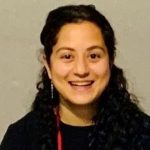
Nimisha Thakur
This year’s top winner is Nim isha Thakur , a Ph.D. student in anthropology, whose topic was “ River Song: Riverine Futures Amidst Climate Change on the Brahmaputra Floodplains .” Thakur, a graduate research associate at the South Asia Center in the Maxwell School of Citizenship and Public Affairs , won a 16-inch MacBook Pro M3 and a year membership in the Anthropological Association of America. Thakur also has the chance to represent Syracuse University in the regional 3MT competition hosted by the Northeastern Association of Graduate Schools.

Qingyang Liu
Qingyang Liu , a Ph.D. student in human developm ent and family science, was named the “People’s Choice” winner by audience vote. Liu conducts research in the SELF Regulation Laboratory in the David B. Falk College of Sport and Human Dynamics . Her topic was “ Material Hardship’s Influence on Self-Regulation Across Childhood: Which Hardship Truly Matters ?” The prize was a set of Bose noise-cancelling headphones.
Additional finalists were:
- Caroline Barraco , master’s student in history, “Authenticity, Commodity and Empire in the Early Modern Spanish Relic Trade”
- Yener Çağla Çimendereli , Ph.D. student in philosophy, “Nonnative Speaking and Linguistic Justice”
- Nicholas Croce , Ph.D. student in social science, “America’s Forgotten Labor Colony Experiment”
- Nardini Jhawar , Ph.D. student in clinical psychology, “Racial Reflections: Examining ADHD Help-Seeking Among Asian American College Students”
- Matthew D. O’Leary , Ph.D. student in anthropology, “Entangled Frontiers: Capitalism and Artifacts of Power at Fort St. Frédéric”
- Andrew Ridgeway , Ph.D. student in composition and cultural rhetoric, “Evil We Desire: Akrasia and Conspiracy Rhetoric”
- Paul Sagoe , Ph.D. student in biomedical engineering, “From Joint Pain to Joy Gain: Delivering Drugs for Osteoarthritis Cure”’
- Julia Zeh , Ph.D. student in biology, “From Baby Babbles to Masterful Melodies: Investigating Vocal Development in Humpback Whales”
Judges were Sarah Hamersma, associate professor and director of doctoral studies in public administration and international affairs, and Chung-Chin Eugene Liu, assistant professor of economics, both of the Maxwell School; and Corey Williams, a Syracuse City School District employee and a Common Councilor for Syracuse’s Third District.
Diane Stirling
- ‘The Droll (Or, a Stage-Play about the END of Theatre)’ Closes Out Department of Drama 2023-24 Season Thursday, April 18, 2024, By Joanna Penalva
- Auxiliary Services Welcomes New Executive Chef for Campus Dining Thursday, April 18, 2024, By Abby Haessig
- Campus Dining and Stores to Become Fully Cashless in Fall 2024 Thursday, April 18, 2024, By Abby Haessig
- Chancellor Syverud Provides Updates to University Senate on Shared Governance Related to Honorary Degrees, Benefits, Sustainability and Athletics Thursday, April 18, 2024, By News Staff
- Professor Receives NSF CAREER Award to Research Context Sensitive Fuzzing for Networked Systems Thursday, April 18, 2024, By Kwami Maranga
More In Campus & Community
Auxiliary services welcomes new executive chef for campus dining.
A Syracuse native, Chef Ilana (Ih-lah-nah) Cahill’s culinary journey began at one of the city’s most iconic restaurants: Dinosaur BBQ. She spent nine years there, starting out as the hostess and working her way up through the ranks. When Cahill…
Campus Dining and Stores to Become Fully Cashless in Fall 2024
Beginning at the start of the Fall 2024 semester, all Syracuse University Campus Dining and Campus Store locations will operate on a fully cashless basis, joining many other campus departments, including the JMA Wireless Dome and Parking and Transportation Services….
Chancellor Syverud Provides Updates to University Senate on Shared Governance Related to Honorary Degrees, Benefits, Sustainability and Athletics
Thank you, Professor Reed. Can we all clap for the professor? Twenty-five days to Commencement. It’s hard to believe and package it. Today I’m going to be very brief. I do want to note with great sorrow the passing last…
Department of Public Safety Seeking Community Feedback
The Department of Public Safety (DPS) in collaboration with the Office of Institutional Research and Assessment, is currently conducting an online survey to learn from campus community members about their experiences with and perspectives on public and campus safety. The…
University Names 2024-25 Remembrance Scholars
Thirty-five students have been chosen as the 2024-25 Syracuse University Remembrance Scholars. The scholarships, now in their 35th year, were founded as a tribute to—and means of remembering—the students studying in London and Florence through Syracuse University who were killed…
Subscribe to SU Today
If you need help with your subscription, contact [email protected] .
Connect With Us
For the media.
- Office of Postdoctoral Scholars >
- Postdoc News >
Art of Research competition conveys research through imagery
research news

Patrons view the artwork at last year's Art of Research event in the Buffalo Museum of Science. Photo: Meredith Forrest Kulwicki
UBNOW STAFF
Published April 5, 2024
The Art of Research competition celebrating the work of UB graduate students and postdoctoral scholars through a showcase of original images will be on view to the public from 6-8 p.m. April 16 at the Buffalo Museum of Science.
“By highlighting the work of our graduate students and postdoctoral scholars through visually captivating images and engaging captions, the Art of Research competition not only celebrates their achievements but also inspires others to pursue innovative solutions to pressing challenges,” says Graham Hammill, vice provost for academic affairs and dean of the Graduate School.
The competition features 102 images submitted by graduate students and postdocs from across the disciplines. Submissions include photographs, illustrations, visualizations and renderings of anything produced during the course of the scientific process. Entries are judged on their creativity, aesthetic appeal, how well the image demonstrates or reflects the research, the caption and overall artistic and visual impact.
There will be a total of 10 winners:
- Grand Prize: $1,000.
- Judge’s Choice (eight available): $500 each.
- People’s Choice: $500.
The finalists’ artwork will be printed and displayed at the event; the work of the non-finalists can be viewed on TV screens that will be placed at each corner of the room. The People’s Choice winner will be determined by a vote of those attending. All winning images will be added to the competition website after the event.
Earlier that day, high school students from the Buffalo Public Schools will take a field trip to the museum to explore the Art of Research display, as well as attend a presentation from Undergraduate Admissions. There will also be tables from various UB programs, including the Science and Technology Entry Program (STEP) and the School of Pharmacy and Pharmaceutical Sciences.
To learn more, visit the Art of Research competition website .
Thank you for visiting nature.com. You are using a browser version with limited support for CSS. To obtain the best experience, we recommend you use a more up to date browser (or turn off compatibility mode in Internet Explorer). In the meantime, to ensure continued support, we are displaying the site without styles and JavaScript.
- View all journals
- My Account Login
- Explore content
- About the journal
- Publish with us
- Sign up for alerts
- Open access
- Published: 17 April 2024
Diversity-dependent speciation and extinction in hominins
- Laura A. van Holstein ORCID: orcid.org/0000-0003-1222-9593 1 &
- Robert A. Foley ORCID: orcid.org/0000-0003-0479-3039 1
Nature Ecology & Evolution ( 2024 ) Cite this article
134 Altmetric
Metrics details
- Biological anthropology
The search for drivers of hominin speciation and extinction has tended to focus on the impact of climate change. Far less attention has been paid to the role of interspecific competition. However, research across vertebrates more broadly has shown that both processes are often correlated with species diversity, suggesting an important role for interspecific competition. Here we ask whether hominin speciation and extinction conform to the expected patterns of negative and positive diversity dependence, respectively. We estimate speciation and extinction rates from fossil occurrence data with preservation variability priors in a validated Bayesian framework and test whether these rates are correlated with species diversity. We supplement these analyses with calculations of speciation rate across a phylogeny, again testing whether these are correlated with diversity. Our results are consistent with clade-wide diversity limits that governed speciation in hominins overall but that were not quite reached by the Australopithecus and Paranthropus subclade before its extinction. Extinction was not correlated with species diversity within the Australopithecus and Paranthropus subclade or within hominins overall; this is concordant with climate playing a greater part in hominin extinction than speciation. By contrast, Homo is characterized by positively diversity-dependent speciation and negatively diversity-dependent extinction—both exceedingly rare patterns across all forms of life. The genus Homo expands the set of reported associations between diversity and macroevolution in vertebrates, underscoring that the relationship between diversity and macroevolution is complex. These results indicate an important, previously underappreciated and comparatively unusual role of biotic interactions in Homo macroevolution, and speciation in particular. The unusual and unexpected patterns of diversity dependence in Homo speciation and extinction may be a consequence of repeated Homo range expansions driven by interspecific competition and made possible by recurrent innovations in ecological strategies. Exploring how hominin macroevolution fits into the general vertebrate macroevolutionary landscape has the potential to offer new perspectives on longstanding questions in vertebrate evolution and shed new light on evolutionary processes within our own lineage.
Similar content being viewed by others
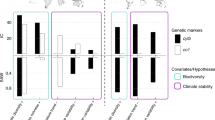
Evolutionary history and past climate change shape the distribution of genetic diversity in terrestrial mammals
Spyros Theodoridis, Damien A. Fordham, … David Nogues-Bravo
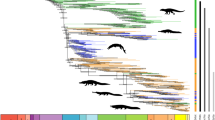
Decoupling speciation and extinction reveals both abiotic and biotic drivers shaped 250 million years of diversity in crocodile-line archosaurs
Alexander R. D. Payne, Philip D. Mannion, … Katie E. Davis

Clade density and the evolution of diversity-dependent diversification
Marcio R. Pie, Raquel Divieso & Fernanda S. Caron
The diversification of a lineage is the net output of speciation minus extinction. A theme that runs through much research into human evolution is whether the determinants of hominin diversification conform to or diverge from those seen in other taxa. At one extreme lie ideas such as Wolpoff’s ‘single species hypothesis’ 1 , which suggested that there can be no speciation in the hominin lineage, as its niche is ‘culture’. Culture, in Wolpoff’s view, is uniquely human and prevents boundaries between populations from occurring; hence, speciation was prohibited in hominins, but not in other clades. At the other extreme are interpretations that emphasize commonalities between patterns of hominin speciation and extinction and those of other clades 2 . Within this group, research interest has primarily been devoted to examining the role of climate in shaping hominin diversification 2 , 3 , 4 , 5 , 6 , 7 . What has received far less attention as a potential driver of hominin diversification than climate, however, is competition.
Competition occurs across taxonomic scales, from interindividual competition within populations 8 to intergroup competition within species 9 and interspecific competition 10 . Competition at each of these levels has been shown to act as an important driver of evolution at equal or higher scales 11 , 12 , 13 . Here we focus on interspecific competition for niches (hereafter ‘competition’) and its consequences above the species level. Although the concept of ‘niche’ has only rarely been formally defined in previous work on diversity-dependent speciation 14 , 15 , 16 , its implicit definition in previous work is that of a Hutchinsonian ecological niche 17 —an n -dimensional hypervolume describing all environmental resources and conditions required for species persistence. We adopt this conventional definition throughout this paper. The consequences of competition can include three processes: speciation, extinction and morphological change through, for example, character displacement 13 , 18 . There is some indirect evidence that competition resulted in morphological evolution in our lineage: competition between Homo and Paranthropus in East Africa probably led to character displacement in the mandibular premolar morphology of these two groups 19 . However, much less work has been devoted to exploring the effects of competition on hominin speciation or extinction.
Ecological competition with large carnivores is thought to have exerted a strong effect on hominin ranging patterns 20 , 21 , hunting behaviour 22 and, of particular interest at a macroevolutionary scale, geographic dispersals 23 , 24 . Although it is unknown whether competition with large carnivores had direct effects on hominin speciation or extinction, the link between dispersals and these macroevolutionary processes is well established 25 . Compared with competition between hominins and non-hominins, the dynamics and effects of competition between hominin species have received comparatively little attention. Although competition may have contributed to a pulse of hominin extinction around 1.5 million years ago 26 , and some recent reviews have used evidence for hominin sympatry in East and South Africa to suggest the possibility of competition 27 , 28 , an explicit investigation of the extent to which competition drove hominin diversification is lacking.
Competition has probably had a major role in animal diversification, however, leaving signals in correlations between species diversity, on the one hand, and speciation and extinction on the other 14 , 16 , 29 , 30 , 31 . Speciation can be both positively or negatively diversity dependent or occur independently of a clade’s own diversity. Under positive diversity dependence, speciation rates rise as a function of the novel evolutionary opportunities and interactions created by other species 32 . This pattern is exceptionally rare among all forms of life, however, having been reported only in island-dwelling beetles 33 , plants and arthropods 34 , and this latter case is contentious 35 , 36 . Instead, if a relationship exists between vertebrate speciation and diversity, this is usually negative 14 , 16 , 30 , 31 . There are two processes by which speciation may be negatively controlled by diversity: competition for (1) niche space, or (2) geographic space 15 . In both, speciation is regulated by bounded ecological opportunities. In classical Darwinian diversity dependence 16 , 37 , speciation into a niche occupied by a closely related species is prohibited, producing a negative relationship. At a higher level of taxonomic organization, models of asymptotic diversity predict slowdowns in speciation as a finite number of niches within an adaptive grade, or a finite number of ranges within bounded space, become occupied by closely related species as a clade grows 25 , 38 . However, findings of diversity-independent speciation in some clades has led to intense debate about whether negative diversity dependence is universal across vertebrates; the same is true for the related question of whether absolute limits to niches or geographic ranges even exist 39 , 40 .
The relationship between extinction and diversity has received less explicit empirical attention than that between speciation and diversity. However, when a relationship is reported, extinction is typically positively diversity dependent 41 , 42 . These patterns align with expectations based on theory. Under Darwinian diversity dependence, competition between ecologically similar species should result in extinction of outcompeted species 37 even in the absence of absolute limits to species diversity. Models of asymptotic diversity 16 , 43 predict increased rates of extinction as species diversity approaches an explicitly predicted diversity limit. Asymptotic diversity dynamics have been reported for multiple vertebrate clades 44 , 45 , although other studies have suggested that these trends are unclear among terrestrial vertebrates 32 . As is the case for speciation, then, there is some empirical evidence for a typical direction of the relationship between diversity and extinction—in this case, positive—but the universality of this pattern among vertebrates, too, remains an open question.
Hominin evolution is represented by a well-studied and rich fossil record and occurs across temporal and spatial scales that sit squarely at the expected intersection of climatic and competitive processes 46 . Therefore, exploring how hominin macroevolution fits into the general vertebrate macroevolutionary landscape has the potential to offer new perspectives on longstanding questions in vertebrate evolution, as well as addressing the comparative dearth of explicit research on diversity-dependent macroevolution in the hominin lineage.
Here we ask whether hominins also follow the pattern of diversity-dependent diversification that characterizes many other vertebrate clades. More specifically, we ask: were hominins characterized by negative diversity-dependent speciation and positive diversity-dependent extinction?
At which taxonomic level should these patterns be expected? Negative diversity-dependent speciation and positive diversity-dependent extinction at the level of the hominin clade as a whole would imply either that hominins were characterized by species’ inabilities to diverge ecologically from each other, as in Darwinian diversity dependence—and in an extension of Wolpoff’s ‘culture’ argument—or that hominins occupy a bounded set of niches in broader ecological context, as in asymptotic diversity dependence. One possibility is that hominin diversification is not diversity dependent, either because hominin speciation and extinction are purely climate-driven and not determined by diversity-mediated competitive dynamics 2 , 3 , 4 , 5 , 6 , 7 , or because the lineage was characterized by consistent ecological divergence, or because a limit to species diversity did not exist or was not reached. A second possibility is that hominins, overall, conform to the expected patterns. This would indicate a powerful and underappreciated role for interspecific competition in hominin evolution.
However, Darwinian diversity dependence 16 , 37 predicts stronger signals of diversity-dependent dynamics within and not across adaptive grades 15 , 16 , 37 , as species within adaptive grades should be more ecologically similar to each other. Given that there is strong support for Homo having occupied an adaptive grade distinct from earlier hominins 47 , 48 , we contrast the patterns found between Homo and Plio-Pleistocene non- Homo species ( Australopithecus and Paranthropus ). In addition to the two possible patterns described above, this comparison presents a third possibility: conflicting patterns between adaptive grades. Such a pattern will have resonance with the major issue of how far hominin evolution conforms to general evolutionary patterns, and why it might diverge.
Analyses based on speciation and extinction times
To explore whether species diversity predicts species origination and extinction, we ran birth–death models in a validated Bayesian framework 49 , 50 on five datasets of estimated times of species origination and extinction. The first dataset comprised published first and last appearance dates (FADs and LADs), which are conventionally used as proxies for times of species origination and extinction without accounting for variability in fossil preservation rates. The subsequent four datasets were based on our database of hominin fossil occurrences, recorded at two operational definitions of localities (at the finest-grained occurrence level available ( n = 385 occurrences) and at the broadest occurrence level (that in which all occurrences at a site complex were merged into a single occurrence; n = 267 occurrences)). We applied two sets of explicit fossil preservation rate priors (time-based variability and within-lifetime variability; both models also included between-lineage variability) to these two occurrence datasets, generating four new sets of times of species origination and extinction. As there were no differences in the direction of inferred relationships between these datasets, we report results for both models of preservation from the most fine-grained occurrence level here. Results for the broadest occurrence level are provided in Supplementary Table 1 .
Times of speciation and extinction estimated for fine-grained occurrences under (1) lineage- and time-based variability and (2) lineage- and within-species lifetime variability in fossil preservation rates are presented in Table 1 . Those for the same analyses across the broadest occurrence level are reported in Supplementary Table 2 . Speciation times were significantly different between the new dates estimated under both preservation rate priors and between dates estimated under preservation rate priors and the published FADs and LADs of fossil species (pairwise paired t -tests with Bonferroni correction, P < 0.05). Extinction times did not differ significantly between dates estimated under both preservation rate priors, but both of these did differ significantly from the published FADs and LADs (pairwise paired t -tests with Bonferroni correction, P < 0.05). Compared to published FADs, estimates of speciation and extinction times that account fossil preservation extended species’ lifespans. These models estimate that species originated, on average, 0.49 million years earlier (within-lifetime variability) and 0.37 million years earlier (time-based variability) than published dates suggest, and that they went extinct 0.27 million years later (within-lifetime variability) and 0.15 million years later (time-based variability) than published dates suggest (Fig. 1a and Table 1 ).

a , Species lifespans, comprising the time between speciation and extinction dates based on three datasets. Orange: published fossil FADs and LADs estimated without taking fossil preservation into account. Light blue: speciation and extinction dates estimated in a Bayesian framework incorporating time-based variability in fossil preservation rates. Dark blue: speciation and extinction dates estimated in a Bayesian framework incorporating within-lineage variability in fossil preservation rates. Note that these taxa are those the published dates and our new database have in common; actual analyses incorporated Homo ergaster in the no-preservation-prior dataset and Homo rudolfensis in the preservation prior datasets. Homo erectus s.l. refers to Homo erectus sensu lato. b , The Parins-Fukuchi et al. 87 phylogeny used in this study, with species coloured by taxonomic grouping (yellow: Homo; green: non- Homo ).
Across each of the three datasets, the results suggest at reasonable confidence that speciation was a negatively diversity-dependent process across the hominin clade as a whole (Fig. 2a and Table 2 ). The 50% credible intervals did not overlap with 0, although the 95% credible intervals did. In two models, >75% of the posterior distribution was negative. For non- Homo species, the signal was more diffuse. Although mean correlation parameter estimates were negative, the 50% credible interval overlapped with 0 in all cases (Fig. 2a ). By contrast, the results suggest at reasonable confidence that speciation in Homo was positively diversity-dependent across all three datasets (Fig. 2a and Table 2 ). In the model with no preservation priors, the 50% credible interval overlapped with 0, but the correlation parameter was positive in 67.9% of the iterations. In models incorporating fossil preservation variability, the 50% credible intervals did not overlap with 0, although the 95% credible intervals did (Fig. 2a ). In these models, the correlation parameter was positive in 78% and 83.8% of the iterations of the time-based preservation variability model and the within-lifetime preservation variability models, respectively.
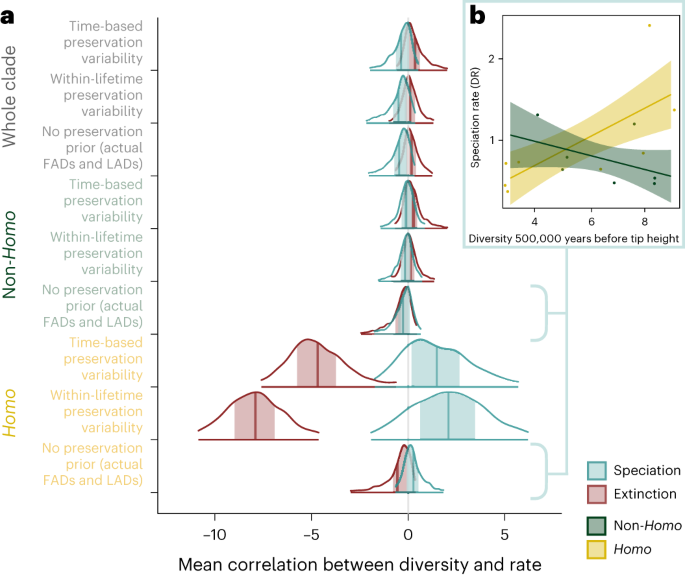
a , Results from PyRate birth–death models, run across three datasets with different fossil preservation priors (no preservation priors: published FADs and LADs; time-based preservation variability, where preservation is allowed to vary every 1 million years—prior applied to fossil occurrence data from three databases; and within-lifetime preservation variability, where preservation rate is allowed to vary across a species’ lifespan—prior applied to fossil occurrence data from three databases). In the latter two models, the preservation rate was also allowed to vary between lineages. The posterior distribution of the correlation parameter is shown, with the 50% credible interval shaded and the 95% credible interval indicated by the outline. The mean correlation parameter is indicated by a thick line. Results for speciation are indicated in blue; those for extinction are shown in red. b , The relationship between diversity 500,000 years before tip height and speciation rate (tip DR) across the Parins-Fukuchi et al. 87 phylogeny. Shaded area indicates 95% confidence interval.
The strongest signal across both processes was that extinction in Homo was unexpectedly negatively diversity dependent. For all three models, >75% of the posterior distribution of the diversity correlation parameter was negative, and the 50% credible intervals did not overlap with 0; and in the two models incorporating fossil preservation variability, >99% of the distribution was negative (Fig. 2a and Table 2 ). The pattern in Homo stands in stark contrast to the lack of a strong signal within non- Homo or the hominin clade as a whole. Although the mean of the posterior distribution of the correlation parameter was positive in all but one model (non- Homo , no preservation priors), <75% of the posterior distributions for these models was positive, and the 50% and 95% credible intervals overlapped with 0 in all cases (Fig. 2a and Table 2 ).
Phylogeny-based analyses of speciation rate
To explore support for the results from models incorporating variability in fossil preservation versus those from the model without, we developed a complementary but independent analytical approach and calculated the speciation rate across a phylogeny. There was a statistically significant difference in the relationship between diversity and speciation between Homo and non- Homo groups (phylogenetic generalized least squares (GLS): difference between Homo and non- Homo regression slope, P < 0.05). In non- Homo species, speciation rate decreased as a function of diversity, consistent with a negative diversity-dependent speciation regime, whereas Homo was characterized by a significant positive relationship between speciation rate and diversity (Fig. 1b ). Model outputs are provided in Supplementary Table 3 .
The differences between Homo and non- Homo are unlikely to be the consequence of higher undersampling of non- Homo species richness: the same result was obtained across 99% of trees with 12.5% increased non- Homo species richness and 98%, 95% and 94% of trees with 25%, 37.5% and 50% increased non- Homo species richness, respectively.
The phylogeny-based method performs reasonably well across small datasets; across the small trees simulated under a diversity-dependent process, it correctly inferred negative diversity dependence across 73% of the trees, and this remained 73% when up to 40% species were randomly removed from the phylogenies to simulate incomplete sampling. The method falsely identified a relationship between diversity and speciation across 31% of the simulated constant-rate birth–death trees, and this rose to 41% when up to 40% species were randomly removed from the phylogenies. In the incorrect sample of 31%, negative diversity dependence was inferred across nearly all trees (97%), and this did not change across the phylogenies across which incomplete sampling was simulated. Positive diversity-dependent speciation was incorrectly inferred across 0.02% of the complete simulated constant-rate birth–death trees and 0.3% of the trees across which incomplete sampling was simulated. Taken together, these results suggest that there can be reasonable but not total confidence that non- Homo speciation was characterized by negative diversity dependence; there is a 69% chance that it was not a false positive result across a tree generated under a non-diversity-dependent process. There is only a 0.02% chance that the positive diversity-dependent speciation of Homo is a methodological artefact.
We investigated whether hominin speciation and extinction are correlated with species diversity, as they are across many—but not all—vertebrate clades. Our results across the clade as a whole suggest that speciation was probably negatively regulated by diversity, and that this was also true for the group comprising Australopithecus and Paranthropus , although the signal was weaker in this subclade. By contrast, there is reasonably strong evidence that the relationship between speciation and diversity in the genus Homo diverges from that in other hominins and many other vertebrates: across two analytical approaches, Homo speciation was positively diversity dependent. Homo extinction, furthermore, showed a very strongly negatively diversity-dependent pattern, which differs from the lack of a relationship between extinction and diversity found both across hominins as a whole and in the Australopithecus and Paranthropus subgroup.
From a broader vertebrate perspective, the reasonably strong evidence for negative diversity-dependent speciation across the clade as a whole (mean 79% and 77% of the posterior distributions <0 for all Bayesian models and Bayesian models accounting for fossil preservation bias, respectively; Table 1 ), paired with the much more diffuse signal of negative diversity dependence in non- Homo (mean 62.8% and 60.5% of the posterior distributions <0 for all Bayesian models and Bayesian models accounting for fossil preservation bias, respectively, and a 69% chance that the patterns across the phylogeny were not false positives) echoes theoretical uncertainty about the taxonomic scale across which diversity dependence should operate 16 . Previous work in higher taxonomic groupings within birds and squamates found evidence of negative diversity-dependent speciation 14 , 29 , 31 , whereas work within terrestrial vertebrate orders, including Primates, recovered no such relationship 39 . Although our analyses were conducted at a lower scale, we recovered a corresponding pattern, with stronger evidence for diversity-dependent speciation at higher taxonomic scales. Turning to broader questions about whether ecological limits to species diversity are even to be expected 51 , the comparison between signal strength at the two scales we report here suggests that limits to diversity should exist at higher taxonomic levels. One potential explanation is that if limits to ecologically similar species diversity exist, subclades may often not reach these individually before extinction begins to outpace speciation. Through a Darwinian diversity-dependent lens, this ‘limit’ may simply reflect the point at which species are no longer able to diverge ecologically from one another 16 and so has more to do with the evolvability of the clade itself, whereas an asymptotic view holds that there is a set number of niches or limited geographic space to speciate into a priori. We cannot distinguish between these alternatives based on the models we present here, but our results are consistent with clade-wide diversity limits that governed speciation overall but were not quite reached by the non- Homo subclade before its extinction.
Notably, neither non- Homo subclade extinction nor that across the clade as a whole carried a strong signal of diversity dependence (Table 1 ). This aligns with previous work reporting an absence of diversity-dependent extinction—for example, the lack of empirical evidence for extinctions in ‘saturated’ communities following species invasions 52 . Previous work has made a strong case that hominin extinction is more closely linked to climate than hominin speciation 53 , and climate-driven extinction before a theoretical cap on diversity—whether Darwinian or asymptotic—was reached can explain these results.
Contrary to expectations, we found reasonably strong evidence for positively diversity-dependent speciation in Homo (mean 76.6% and 80.9% of the posterior distributions >0 for all Bayesian models and Bayesian models accounting for fossil preservation bias, respectively, and a 0.02% chance that the patterns across the phylogeny were false positives). This pattern is much rarer than negatively diversity-dependent speciation and non-diversity-related speciation across all forms of life, having been reported for only a few groups, including island-dwelling beetles 33 , plants and arthropods 34 , with this last case being contentious 35 , 36 . In the vertebrate context, then, our results not only expand the set of reported associations between diversity and speciation but, crucially, underscore previous findings that the relationship between speciation and diversity is complex 39 , 52 , 54 .
This complexity is no doubt at least in part the consequence of the fact that both extrinsic factors and intrinsic traits modify any feedback loop between species diversity and speciation 18 , 55 . One explanation that incorporates both is repeated dispersals. Homo is the only hominin genus to expand its range outside of Africa 56 , 57 , and recurrent expansions into new habitats that promote new adaptations, and therefore speciation, while source populations persist, will result in a positive correlation between speciation rate and diversity. This correlation may reflect no causal relationship between competition and speciation at all, but a complementary model is that high levels of competition between closely related and ecologically similar taxa in the ‘source’ location drove dispersal in the first place 58 , 59 . For example, Carbonell and colleagues 60 suggested that the earliest European hominins were competitively displaced from Africa by populations that developed the Acheulian.
A second and non-mutually exclusive explanation is that ‘diversity begets diversity’ 32 —that is, that existing species provide evolutionary pressure and opportunities for (the evolution of) new species 61 , 62 , 63 . Increased species diversity may produce interactions that can promote speciation and can extend species’ lifespans providing that the activities of the species upon which the niche of another is built persist. Species may create novel ecological opportunities for new species to exploit through ecosystem modification 64 , 65 , 66 . Ecosystem modification is particularly likely to lead to evolutionary consequences if it increases structural and resource heterogeneity 64 . Although the time-averaged nature of the fossil record makes it difficult to reconstruct the ecological effects of hominin behaviour, it is not unlikely that hominins, particularly those belonging to the genus Homo , were ecosystem engineers 67 , 68 , and that the ecological opportunities afforded by their behaviour promoted the appearance of novel hominin species. Behaviours that may have contributed particularly strongly to such dynamics are the use of fire 69 , which can cause widespread landscape modification, and the adoption of active and intensive hunting, which will have exerted new pressures on the distribution and population sizes of hominin prey 68 .
An adaptive ‘trait’ potentially critical to repeated geographic expansions—whether caused by competition or not—as well as creating ecological opportunities for new species and exploiting ecological opportunities afforded by other hominins, is technology 70 , 71 . Of course, lithic technology predates Homo 72 , but what can be said with some certainty is that neither Australopithecus and Paranthropus , nor other vertebrates, rely on stone tool technology to the same degree as Homo 73 . The suggestion that repeated and ratcheted technological innovation promoted speciation stands in stark contrast to Wolpoff’s single species hypothesis 1 .
However, it may be that Homo speciation merely appears to be positively diversity dependent because non- Homo taxa were present at the time of Homo species origination, and that it is not necessarily the presence of these taxa that resulted in Homo speciation. What is incongruous about this explanation, in the context of the evidence for negative diversity dependent speciation across the clade as a whole, is why the presence of these other species did not restrict Homo speciation as predicted. This overlap hints at competitive displacement from occupied niches, rather than the opportunistic replacement documented in, for example, carnivores 74 .
Homo is characterized, finally, by negative diversity-dependent extinction (mean 92.3% and 99.7% of the posterior distributions <0 for all Bayesian models and Bayesian models accounting for fossil preservation bias, respectively). To the best of our knowledge, this pattern has not been documented in other clades. It may be the case that negative diversity-dependent extinction is a statistical artefact of coeval extinction events unrelated to diversity—presumably precipitated by climate change 53 . Although we cannot rule this out, because we did not explicitly contrast the effects of climate and diversity in our models, there are problems with a climate-only explanation for this pattern. Given that Homo evolution occurred during a period of increased climatic deterioration and change 5 , 75 , 76 , and that estimated extinction times did not occur at exactly the same time, and both before and after episodes of major cooling (Table 1 ), it is difficult to pinpoint a single climatic event that underlies Homo extinctions. We propose two alternative explanations for this pattern. First, it may be the case that repeated innovations in adaptive strategies in Homo resulted in coeval competitive replacement of a number of species by a single innovator species. For instance, shifts in life history and dietary strategy within Homo erectus sensu lato 77 may have allowed this taxon to replace competitively early forms of Homo , and the same may have been true for the cognitive and behavioural innovations of Homo sapiens relative to Late Pleistocene hominins 78 . This echoes a recent point made by Bokma and colleagues 79 . A related explanation for late Pleistocene replacement by Homo sapiens is that most roughly coeval hominin extinctions are caused by climate, but that the extreme generalism of Homo sapiens prevents late-surviving forms from speciating 16 . These mechanisms, which may interact with climatic and environmental shifts which stimulated the adaptive novelties, would produce a negative diversity signal.
Accounting for variability in fossil preservation rates within and between lineages, and across time, resulted in longer estimated species lifespans (Fig. 1a ) than those based on published FADs and LADs, and these extended lifespans are more in line with the mammalian average of 1 million years 80 , 81 . That actual hominin fossil FADs and LADs do not fully represent species’ lifespans aligns with findings that hominin fossils are comparatively rare within mammal assemblages 82 . Further implications of these results relate to phylogeny: there are three sets of conventionally hypothesized ancestor–descendant relationships that our new origination and extinction times suggest cannot have occurred unless in the context of non-Hennigian speciation 83 , in which the ancestral species persists alongside its daughter species. Paranthropus boisei originated ~0.1 million years after its putative ancestor Paranthropus aethiopicus 84 , and they overlapped temporally for >0.5 million years. This latter pattern is also true for Homo heidelbergensis and Homo neanderthalensis , and for Australopithecus anamensis and Australopithecus afarensis 85 . In the case of Au. anamensis and Au. afarensis , our results echo recent evidence for the contemporaneity of the two species 86 . Further, the earlier origination date of Homo floresiensis aligns with that inferred across the Parins-Fukuchi et al. 87 phylogeny. Overall, these new datasets underscore previous calls 82 to account for incomplete sampling in analyses of hominin macroevolution. Our results suggest that using conventional FADs and LADs underestimates species’ temporal ranges, with attendant problems for the validity of conclusions.
Evolution is clearly a pluralistic process, with the attendant expectation that climatic processes and competition both influence vertebrate macroevolution. Disentangling their relative roles is an area of ongoing research 13 , 88 , 89 , and the first step in doing so in hominins was addressing the comparative dearth of explicit research on diversity-dependent macroevolution. The evidence for negative diversity dependence in speciation across the clade overall and the strong and unexpected evidence for the part that interspecific competition may have played in both speciation and extinction in the genus Homo are difficult to reconcile with conventional models that place exclusive emphasis on the role of climate in hominin macroevolution. Ultimately, the climatic ‘Court Jester’ must set the stage upon which the ‘Red Queen’ of interspecific competition ‘dances’ 90 , and our results point to a need to further explore the relationship between climate and competition, and how this relationship drove macroevolution, in our own lineage. Finally, an important effect of the inferred longer species lifespans is notably extended periods of temporal overlap between sympatric species, such as P. boisei and early Homo in East Africa 19 as well as Paranthropus robustus and Australopithecus africanus in South Africa. Extended periods of sympatry provide the context for interspecific competition at smaller scales, with effects at equivalent scales, such as microevolutionary morphological evolution driven by competition-mediated niche separation 10 , 13 , 91 . Our results, then, point to the need to further explore the possible effects of interspecific competition at all scales 16 .
In vertebrates, speciation is often negatively diversity dependent, and extinction is expected to show positive diversity dependence. Our results are consistent with diversity limits at the level of the hominin tribe that governed speciation in hominins overall, and with these not being quite reached by the Australopithecus and Paranthropus subclade before its extinction. There was no signal of diversity dependence in Australopithecus and Paranthropus subclade extinction, or that of hominins overall: this is concordant with climate playing a bigger part in hominin extinction than speciation. Homo emerged as an evolutionary outlier amongst its hominin and vertebrate relatives. There is strong evidence that Homo extinction was negatively diversity dependent. Whether this reflects a process of repeated replacements of numerous older forms by more modern species of Homo or simply a correlation with pulsed climatic events, or a more complex relationship between climate and diversity, are new questions raised by these results. Finally, speciation in Homo was found to be relatively robustly positively diversity dependent across two analytical approaches. We argue that the comparatively unusual pattern of positive diversity-dependent speciation we report is concordant with a set of underappreciated and non-mutually exclusive drivers of speciation in Homo : interspecific competition, repeated geographic expansions potentially driven by interspecific competition, and ecosystem engineering by other members of Homo opening up new niches. Whatever the exact processes driving these patterns, the results presented here suggest that Homo was characterized by comparatively unusual and unexpected macroevolutionary dynamics.
Data collection
Occurrence data and fads and lads.
Fossil occurrence data were obtained in November 2023 from the Paleobiology Database ( https://paleobiodb.org/#/ ), using a taxon search for ‘hominin’; the NOW Database 92 ; and the ROCEEH ROAD Database 93 . The taxonomy of the Paleobiology Database occurrence data was checked for spelling errors using the PyRate ‘check_names’ function 49 and manually for synonyms. Occurrence data from the three databases were merged. Duplicates were identified manually, and records with most up-to-date age estimates were retained. If occurrences did not have a specified accession number, duplicates were identified based on location (geological formation and/or member, latitude and longitude) in combination with inspection of specified source publications (if available). To account for differences in the three databases’ approach to defining occurrence localities (for example, Au. afarensis at Laetoli comprises two entries in the Paleobiology Database, both of which are composites of more than two find spots, whereas all find spots are separate entries in the NOW database), we took a hierarchical approach to recording occurrences, recording ‘Site complex’ (for example, the Woranso-Mille palaeoanthropological research area), ‘Site’ (for example, Taung), ‘Subsite’ (for example, localities or surface find spots within a ‘site’; subsite ‘type’ was also recorded), ‘Formation’ (for example, Koobi Fora) and ‘Stratigraphic unit’ (for example, Member 4). Not all occurrences had information for all variables: for example, the Mauer site is not part of a larger ‘Site’ complex. We supplemented and updated the merged database with occurrence information obtained from literature reviews of papers published after 2016 and cross-checked our database with occurrence information supplied in published overviews of research where available 84 , 94 , 95 .
Species’ published FADs and LADs, which are conventionally taken as speciation and extinction ‘times’, were taken from Wood and Boyle 96 and supplemented with dates of more recently published species in the manner described by van Holstein and Foley 97 .
We used the phylogeny with the best Akaike information criterion score from Parins-Fukuchi et al. 87 . In contrast to other hominin phylogenies 98 , 99 , 100 , this phylogeny combines probabilistic models of morphological evolution and fossil preservation to recover anagenetic relationships between hominin species. It therefore uniquely recovers ancestor–descendant relationships that are (1) likely to be more realistic than those on phylogenies that do not incorporate them, and (2) broadly accepted based on morphological evidence alone (for example, between Au. anamensis and Au. afarensis 85 ).
The species diversification rate, tip DR, of Jetz et al. 101 , which calculates the tip-specific speciation rate, was calculated for every tip using R code from Upham et al. 102 :
where DR is the tip DR for species i , N i is the number of edges between species I and the root, and l is the length of edge j (with j = 1 being the edge closest to the extant tip). For each tip, the number of extant species at 500,000 years before the tip height was obtained using the ‘getExtant’ function in the phytools package 103 .
To determine whether speciation and extinction times were correlated with species diversity, we ran birth–death models, with diversity as predictor, in a validated Bayesian framework 49 , 50 on five datasets with estimated times of species origination and extinction. The first dataset was based on the conservative FADs and LADs estimated by Wood and Boyle 96 , with additions from van Holstein and Foley 97 , and thus incorporates no variability in fossil preservation rates. The subsequent four datasets were based on our new hominin occurrence database. From these data, we estimated four new sets of times of speciation and extinction with two sets of explicit fossil preservation rate priors and two operational definitions of localities (at the finest-grained occurrence level available ( n = 385 occurrences) and at the broadest occurrence level (that is, with all occurrences at a site complex merged into a single occurrence; n = 267 occurrences). As there were no differences in the direction of inferred relationships between these datasets, we report results for both models of preservation from the most fine-grained occurrence level; results for the broadest occurrence level are provided Supplementary Table 1 .
In the first dataset, we modelled fossil preservation as a function of a time-variable Poisson process. Preservation rates were allowed to vary every 1 million years. In the second dataset, we allowed fossil preservation to vary over the course of a species’ lifespan by modelling it with a non-homogeneous Poisson process of preservation 49 . This allowed us to take into account that fossils are less likely to form at the start and end of a species’ lifespan, as the number of individuals belonging to a species is low. In both datasets, fossil preservation was also allowed to vary between lineages by incorporating a gamma model of rate heterogeneity 49 . We generated ten replicates of estimated times of species origination and extinction for both preservation regimes using the Reversible Jump MCMC algorithm in the python programme PyRate 49 , to incorporate dating uncertainty into the results 104 . All analyses described below were then performed on the ten replicates, and results were joined into a single posterior sample.
We generated lineage-through-time estimates for all three datasets in PyRate. We then applied a PyRate birth–death model in which Homo and non- Homo speciation and extinction rates were determined by an exponential correlation to a time-variable predictor, in this case clade-wide lineage-through-time estimates for each set of times of origination and extinction. To compare these results with the pattern across the whole clade, we ran an exponential diversity-dependent birth–death model, in which the whole clade’s own diversity was used as the predictor variable. As the sample size was inevitably relatively small, we ran each model for 2,000,000 iterations, sampling every 1,000 iterations.
Analyses based on phylogeny
These analyses were performed in R 4.01 (ref. 105 ). To explore further the relationship between speciation and diversity—and, in particular, the difference between Homo and non- Homo species—we ran phylogenetic GLS regressions to determine whether there were differences between Homo and non- Homo in the relationship between speciation rates and previous clade-wide diversity:
where DR is the tip DR and SD is the phylogeny-based species diversity at 500,000 years before the tip.
The phylogenetic correlation structure of residual error in the phylogenetic GLS was accounted for in the nlme ‘correlation’ argument 106 . The model assumed a Brownian motion model for residual error structure, following previous work on regressions including speciation rates 101 , 107 , 108 . Non-contemporaneity of tips was represented in the nlme argument ‘weights’.
To test the ability of the phylogeny-based approach described above to correctly distinguish between diversity-dependent and non-diversity-dependent speciation, we simulated 1,000 phylogenies under a constant-rate birth–death process using the ‘pbtree’ function in the phytools package 103 , preserving extinct tips, and repeated the analyses described above for equation ( 2 ) to estimate how often diversity-dependent speciation was erroneously inferred across non-ultrametric trees generated under a non-diversity-dependent process. We then generated 1,000 phylogenies simulated under a diversity-dependent regime using the ‘ddsim’ function in the DDD package 109 . These phylogenies were simulated with birth and death rates and carrying capacities randomly drawn from a normal distribution with means that produced trees with similar tip numbers to those of the Parins-Fukuchi et al. 87 phylogeny in a trial run, and with a maximum tree height of 7, so as to produce similarly small phylogenies to the Parins-Fukuchi et al. 87 tree. We then randomly removed up to 40% of tips and repeated the analyses to investigate the sensitivity of results to incomplete sampling.
We also tested the sensitivity of the results of phylogeny-based analyses using equation (2) to the increased probability of species discovery towards the present 82 , which could have resulted in underrepresentation of non- Homo species relative to the younger Homo species included in the analyses. To do so, we generated 4,000 phylogenies with up to +50% non- Homo species added in random locations and with random tip heights to the original Parins-Fukuchi et al. 87 phylogeny, using the ‘bind_tip’ function in the phytools package 103 . We repeated the analyses described above for equation (2) and calculated the proportion of trees across which the original results were maintained.
Reporting summary
Further information on research design is available in the Nature Portfolio Reporting Summary linked to this article.
Data availability
All data are available on figshare: https://figshare.com/s/46fe37e09047513e31b0 (ref. 110 ).
Code availability
All code is available on figshare: https://figshare.com/s/46fe37e09047513e31b0 (ref. 110 ).
Wolpoff, M. H. Competitive exclusion among Lower Pleistocene hominids: the single species hypothesis. Man 6 , 601 (1971).
Article Google Scholar
Vrba, E. S. Paleoclimate and Evolution, with Emphasis on Human Origins (Yale Univ. Press, 1995).
Vrba, E. S. Turnover-pulses, the Red Queen, and related topics. Am. J. Sci. 293 A , 418–452 (1993).
Faith, J. T. & Behrensmeyer, A. K. Climate Change and faunal turnover: testing the mechanics of the turnover-pulse hypothesis with South African fossil data. Paleobiology 39 , 609–627 (2013).
Potts, R. Environmental hypotheses of hominin evolution. Yearb. Phys. Anthropol. 107 , 93–136 (1998).
Potts, R. Variability selection in hominid evolution. Evol. Anthropol. https://doi.org/10.1002/(SICI)1520-6505(1998)7:3<81::AID-EVAN3>3.0.CO;2-A (1998).
Potts, R. & Faith, J. T. Alternating high and low climate variability: the context of natural selection and speciation in Plio-Pleistocene hominin evolution. J. Hum. Evol. 87 , 5–20 (2015).
Article PubMed Google Scholar
West-Eberhard, M. Sexual selection, social competition, and evolution. Proc. Am. Philos. Soc. 123 , 222–234 (1979).
Google Scholar
Wrangham, R. W. An ecological model of female-bonded primate groups. Behaviour 75 , 262–300 (1980).
Schreier, B. M., Harcourt, A. H., Coppeto, S. A. & Somi, M. F. Interspecific competition and niche separation in primates: a global analysis. Biotropica 41 , 283–291 (2009).
Clutton-Brock, T. H. & Huchard, E. Social competition and selection in males and females. Philos. Trans. R. Soc. Lond. B Biol. Sci. 368 , 20130074 (2013).
Article CAS PubMed PubMed Central Google Scholar
Stockley, P. & Bro-Jørgensen, J. Female competition and its evolutionary consequences in mammals. Biol. Rev. 86 , 341–366 (2011).
Drury, J. P. et al. Contrasting impacts of competition on ecological and social trait evolution in songbirds. PLoS Biol. 16 , e2003563 (2018).
Article PubMed PubMed Central Google Scholar
Phillimore, A. B. & Price, T. D. Density-dependent cladogenesis in birds. PLoS Biol. 6 , e71 (2008).
Moen, D. & Morlon, H. Why does diversification slow down? Trends Ecol. Evol. 29 , 190–197 (2014).
Rabosky, D. L. Diversity-dependence, ecological speciation, and the role of competition in macroevolution. Annu Rev. Ecol. Evol. Syst. 44 , 481–502 (2013).
Hutchinson, G. E. & MacArthur, R. H. A theoretical ecological model of size distributions among species of animals. Am. Nat. 93 , 117–125 (1959).
Schluter, D. Ecological character displacement in adaptive radiation. Am. Nat. 156 , S4–S16 (2000).
Schroer, K. & Wood, B. The role of character displacement in the molarization of hominin mandibular premolars. Evolution 69 , 1630–1642 (2015).
Egeland, C. P. Taphonomic estimates of competition and the role of carnivore avoidance in hominin site use within the Early Pleistocene Olduvai Basin. Quat. Int. 322-323 , 95–106 (2014).
Starkovich, B. M. & Conard, N. J. in Human Behavioural Adaptations to Interglacial Lakeshore Environments (eds García-Moreno, A. et al.) Ch. 6 (Propylaeum, 2020).
Stiner, M. C. Carnivory, coevolution, and the geographic spread of the genus Homo. J. Archaeol. Res. 10 , 1–63 (2002).
Rodríguez-Gómez, G., Rodríguez, J., Martín-González, J. A. & Mateos, A. Evaluating the impact of Homo-carnivore competition in European human settlements during the early to middle Pleistocene. Quat. Res. 88 , 129–151 (2017).
Brantingham, P. J. Hominid-carnivore coevolution and invasion of the predatory guild. J. Anthropol. Archaeol. 17 , 327–353 (1998).
Gavrilets, S. & Vose, A. Dynamic patterns of adaptive radiation. Proc. Natl Acad. Sci. USA 102 , 18040–18045 (2005).
Grove, M. Amplitudes of orbitally induced climatic cycles and patterns of hominin speciation. J. Archaeol. Sci. 39 , 3085–3094 (2012).
Maslin, M. A. et al. East African climate pulses and early human evolution. Quat. Sci. Rev. 101 , 1–17 (2014).
Maslin, M. A., Shultz, S. & Trauth, M. H. A synthesis of the theories and concepts of early human evolution. Philos. Trans. R. Soc. B Biol. Sci. 370 , 20140064 (2015).
Rabosky, D. L. & Lovette, I. J. Density-dependent diversification in North American wood warblers. Proc. R. Soc. B Biol. Sci. 275 , 2363–2371 (2008).
Etienne, R. S. et al. Diversity-dependence brings molecular phylogenies closer to agreement with the fossil record. Proc. R. Soc. B Biol. Sci. 279 , 1300–1309 (2012).
Weir, J. T. & Mursleen, S. Diversity-dependent cladogenesis and trait evolution in the adaptive radiation of the auks (Aves: Alcidae). Evolution 67 , 403–416 (2013).
Benton, M. J. & Emerson, B. C. How did life become so diverse? The dynamics of diversification according to the fossil record and molecular phylogenetics. Palaeontology 50 , 23–40 (2007).
Emerson, B. C. & Oromi, P. Diversification of the forest beetle genus Tarphius on the Canary Islands, and the evolutionary origins of island endemics. Evolution 59 , 586–598 (2005).
PubMed Google Scholar
Emerson, B. C. & Kolm, N. Species diversity can drive speciation. Nature 434 , 1015–1017 (2005).
Article CAS PubMed Google Scholar
Kiflawi, M., Belmaker, J., Brokovich, E., Einbinder, S. & Holzman, R. Species diversity can drive speciation: comment. Ecology 88 , 2132–2135 (2007).
Emerson, B. C. & Kolm, N. Response to comments on Species diversity can drive speciation. Ecography 30 , 334–338 (2007).
Darwin, C. On the Origin of Species (John Murray, 1859).
Schluter, D. Ecological causes of adaptive radiation. Am. Nat. 148 , S40–S64 (1996)
Pie, M. R., Divieso, R. & Caron, F. S. Clade density and the evolution of diversity-dependent diversification. Nat. Commun. 14 , 4576 (2023).
Shoemaker, L. & Clauset, A. Body mass evolution and diversification within horses (family Equidae). Ecol. Lett. 17 , 211–220 (2014).
Aguilée, R., Gascuel, F., Lambert, A. & Ferriere, R. Clade diversification dynamics and the biotic and abiotic controls of speciation and extinction rates. Nat. Commun. 9 , 3013 (2018).
Quental, T. B. & Marshall, C. R. How the Red Queen drives terrestrial mammals to extinction. Science 341 , 290–292 (2013).
Alroy, J. Geographical, environmental and intrinsic biotic controls on Phanerozoic marine diversification. Palaeontology 53 , 1211–1235 (2010).
Barry, J. C. et al. Faunal and environmental change in the late Miocene Siwaliks of northern Pakistan. Paleobiology 28 , 1–71 (2002).
Alroy, J. Speciation and extinction in the fossil record of North American mammals. Ecol. Rev. 2009 , 301–323 (2009).
Benton, M. J. The Red Queen and the Court Jester: species diversity and the role of biotic and abiotic factors through time. Science 323 , 728–732 (2009).
Collard, M. & Wood, B. in Handbook of Paleoanthropology 2nd edn (eds Henke, W. & Tattersall, I.) 2107–2144 (Springer, 2015).
Foley, R. A. Mosaic evolution and the pattern of transitions in the hominin lineage. Philos. Trans. R. Soc. B Biol. Sci. 371 , 20150244 (2016).
Silvestro, D., Salamin, N. & Schnitzler, J. PyRate: a new program to estimate speciation and extinction rates from incomplete fossil data. Methods Ecol. Evol. 5 , 1126–1131 (2014).
Silvestro, D., Salamin, N., Antonelli, A. & Meyer, X. Improved estimation of macroevolutionary rates from fossil data using a Bayesian framework. Paleobiology 45 , 546–570 (2019).
Harmon, L. J. & Harrison, S. Species diversity is dynamic and unbounded at local and continental scales. Am. Nat. 185 , 584–593 (2015).
Sax, D. F. et al. Ecological and evolutionary insights from species invasions. Trends Ecol. Evol. 22 , 465–471 (2007).
Foley, R. A. Speciation, extinction and climatic change in hominid evolution. J. Hum. Evol. 26 , 275–289 (1994).
Alroy, J. Dynamics of origination and extinction in the marine fossil record. Proc. Natl Acad. Sci. USA 105 , 11536–11542 (2008).
Heard, S. B. & Hauser, D. L. Key evolutionary innovations and their ecological mechanisms. Hist. Biol. 10 , 151–173 (1995).
Lordkipanidze, D. et al. A complete skull from Dmanisi, Georgia, and the evolutionary biology of early Homo . Science 342 , 326–331 (2013).
Scardia, G., Neves, W. A., Tattersall, I. & Blumrich, L. What kind of hominin first left Africa? Evol. Anthropol. 30 , 122–127 (2021).
Metz, J. A. J. & Gyllenberg, M. How should we define fitness in structured metapopulation models? Including an application to the calculation of evolutionarily stable dispersal strategies. Proc. R. Soc. B Biol. Sci. 268 , 499–508 (2001).
Article CAS Google Scholar
De Meester, N., Derycke, S., Rigaux, A. & Moens, T. Active dispersal is differentially affected by inter- and intraspecific competition in closely related nematode species. Oikos 124 , 561–570 (2015).
Carbonell, E., Mosquera, M., Rodríguez, X. P. & Sala, R. The first human settlement of Europe. J. Anthropol. Res 52 , 107–114 (1996).
Nosil, P. & Crespi, B. J. Experimental evidence that predation promotes divergence in adaptive radiation. Proc. Natl Acad. Sci. USA 103 , 9090–9095 (2006).
Tokeshi, M. Species Coexistence: Ecological and Evolutionary Perspectives (Blackwell, 1999).
Erwin, D. H. Seeds of diversity. Science 308 , 1752–1753 (2005).
Erwin, D. Macroevolution of ecosystem engineering, niche construction and diversity. Trends Ecol. Evol. 23 , 304–310 (2008).
Wright, J. P. & Jones, C. G. The concept of organisms as ecosystem engineers ten years on: progress, limitations, and challenges. BioScience 56 , 203–209 (2006).
Jones, C. G., Lawton, J. H. & Shachak, M. Positive and negative effects of organisms as physical ecosystem engineers. Ecology 78 , 1946–1957 (1997).
Braun, D. R. et al. Ecosystem engineering in the Quaternary of the west coast of South Africa. Evol. Anthropol. 30 , 50–62 (2021).
Root‐Bernstein, M. & Ladle, R. Ecology of a widespread large omnivore, Homo sapiens , and its impacts on ecosystem processes. Ecol. Evol. 9 , 10874–10894 (2019).
Roebroeks, W. & Villa, P. On the earliest evidence for habitual use of fire in Europe. Proc. Natl Acad. Sci. USA 108 , 5209–5214 (2011).
Bird, D. W. & O’Connell, J. F. Behavioral ecology and archaeology. J. Archaeol. Res. 14 , 143–188 (2006).
Blumenschine, R. J. & Pobiner, B. in Evolution of the Human Diet: The Known, the Unknown, and the Unknowable (ed. Ungar, P. S.) Ch. 10 (Oxford Univ. Press, 2007).
Harmand, S. et al. 3.3-million-year-old stone tools from Lomekwi 3, West Turkana, Kenya. Nature 521 , 310–315 (2015).
Shea, J. J. Occasional, obligatory, and habitual stone tool use in hominin evolution. Evol. Anthropol. 26 , 200–217 (2017).
Van Valkenburgh, B. Major patterns in the history of carnivorous mammals. Annu. Rev. Earth Planet Sci. 27 , 463–493 (1999).
Potts, R. Hominin evolution in settings of strong environmental variability. Quat. Sci. Rev. 73 , 1–13 (2013).
Potts, R. Evolution and climate variability. Science https://doi.org/10.1126/science.273.5277.922 (1996).
Antón, S. C. Natural history of Homo erectus . Am. J. Phys. Anthropol. 122 , 126–170 (2003).
Timmermann, A. Quantifying the potential causes of Neanderthal extinction: abrupt climate change versus competition and interbreeding. Quat. Sci. Rev. 238 , 106331 (2020).
Bokma, F., van den Brink, V. & Stadler, T. Unexpectedly many extinct hominins. Evolution 66 , 2969–2974 (2012).
Rosenzweig, M. L. Species Diversity in Space and Time (Cambridge Univ. Press, 1995).
Rosenblum, E. B. et al. Goldilocks meets Santa Rosalia: an ephemeral speciation model explains patterns of diversification across time scales. Evol. Biol. 39 , 255–261 (2012).
Maxwell, S. J., Hopley, P. J., Upchurch, P. & Soligo, C. Sporadic sampling, not climatic forcing, drives observed early hominin diversity. Proc. Natl Acad. Sci. USA 115 , 4891–4896 (2018).
Ezard, T. H. G., Pearson, P. N., Aze, T. & Purvis, A. The meaning of birth and death (in macroevolutionary birth-death models). Biol. Lett. 8 , 139–142 (2012).
Wood, B. & Schroer, K. in Human Paleontology and Prehistory (eds Marom, A. & Hovers, E.) Ch. 8 (Springer, 2017); https://doi.org/10.1007/978-3-319-46646-0_8
Kimbel, W. et al. Was Australopithecus anamensis ancestral to A. afarensis ? A case of anagenesis in the hominin fossil record. J. Hum. Evol. 51 , 134–152 (2006).
Haile-Selassie, Y., Melillo, S. M., Vazzana, A., Benazzi, S. & Ryan, T. M. A 3.8-million-year-old hominin cranium from Woranso-Mille, Ethiopia. Nature 573 , 214–219 (2019).
Parins-Fukuchi, C., Greiner, E., MacLatchy, L. M. & Fisher, D. C. Phylogeny, ancestors, and anagenesis in the hominin fossil record. Paleobiology 45 , 378–393 (2019).
Drury, J., Clavel, J., Manceau, M. & Morlon, H. Estimating the effect of competition on trait evolution using maximum likelihood inference. Syst. Biol. 65 , 700–710 (2016).
Clavel, J. & Morlon, H. Accelerated body size evolution during cold climatic periods in the Cenozoic. Proc. Natl Acad. Sci. USA 114 , 4183–4188 (2017).
Barnosky, A. D. Distinguishing the effects of the Red Queen and Court Jester on Miocene mammal evolution in the northern Rocky. J. Vertebr. Paleontol. 21 , 172–185 (2001).
Legault, G., Bitters, M. E., Hastings, A. & Melbourne, B. A. Interspecific competition slows range expansion and shapes range boundaries. Proc. Natl Acad. Sci. USA 117 , 26854–26860 (2020).
Žliobaitė, I. et al. in Evolution of Cenozoic Land Mammal Faunas and Ecosystems (eds Casanovas-Vilar, I. et al.) 33–42 (Springer, 2023).
Kandel, A. W. et al. The ROCEEH Out of Africa Database (ROAD): a large-scale research database serves as an indispensable tool for human evolutionary studies. PLoS ONE 18 , e0289513 (2023).
Bobe, R. & Wood, B. Estimating origination times from the early hominin fossil record. Evol. Anthropol. 31 , 92–102 (2022).
Kimbel, W. H. & Delezene, L. K. ‘Lucy’ redux: a review of research on Australopithecus afarensis . Am. J. Phys. Anthropol. 140 , 2–48 (2009).
Wood, B. & K. Boyle, E. Hominin taxic diversity: fact or fantasy? Am. J. Phys. Anthropol. 159 , 37–78 (2016).
van Holstein, L. A. & Foley, R. A. A process‐based approach to hominin taxonomy provides new perspectives on hominin speciation. Evol. Anthropol. 31 , 166–174 (2022).
Dembo, M. et al. The evolutionary relationships and age of Homo naledi : an assessment using dated Bayesian phylogenetic methods. J. Hum. Evol. 97 , 17–26 (2016).
Püschel, H. P., Bertrand, O. C., O’Reilly, J. E., Bobe, R. & Püschel, T. A. Divergence-time estimates for hominins provide insight into encephalization and body mass trends in human evolution. Nat. Ecol. Evol. 5 , 808–819 (2021).
Mongle, C. S., Strait, D. S. & Grine, F. E. Expanded character sampling underscores phylogenetic stability of Ardipithecus ramidus as a basal hominin. J. Hum. Evol. 131 , 28–39 (2019).
Jetz, W., Thomas, G. H., Joy, J. B., Hartmann, K. & Mooers, A. O. The global diversity of birds in space and time. Nature 491 , 444–448 (2012).
Upham, N. S., Esselstyn, J. A. & Jetz, W. Inferring the mammal tree: species-level sets of phylogenies for questions in ecology, evolution, and conservation. PLoS Biol. 17 , e3000494 (2019).
Revell, L. J. phytools: an R package for phylogenetic comparative biology (and other things). Methods Ecol. Evol. 3 , 217–223 (2012).
Pimiento, C. et al. Selective extinction against redundant species buffers functional diversity. Proc. R. Soc. B Biol. Sci. 287 , 20201162 (2020).
R Development Core Team. R: A Language and Environment for Statistical Computing (R Foundation for Statistical Computing, 2016).
Pinheiro, J., Bates, D., DebRoy, S., Sarkar, D. & R Core Team. nlme: linear and nonlinear mixed effects models, version 3.1 – 164 (R Foundation for Statistical Computing, 2020).
Freckleton, R. P., Phillimore, A. B. & Pagel, M. Relating traits to diversification: a simple test. Am. Nat. 172 , 102–115 (2008).
Harvey, M. G. & Rabosky, D. L. Continuous traits and speciation rates: alternatives to state-dependent diversification models. Methods Ecol. Evol. 9 , 984–993 (2018).
Etienne, R. S. et al. Diversity-dependence brings molecular phylogenies closer toagreement with the fossil record. Proc. Biol. Sci. 279 ,1300–1309 (2012).
van Holstein, L. A. Diversity-dependent speciation and extinction in hominins. figshare https://doi.org/10.6084/m9.figshare.24183417 (2024).
Download references
Acknowledgements
We thank J. Saers and M. Mirazón-Lahr for insightful discussion of this manuscript. This work was supported by a Clare College (University of Cambridge) Junior Research Fellowship (2022-2025) awarded to L.v.H.
Author information
Authors and affiliations.
Leverhulme Centre for Human Evolutionary Studies, Department of Archaeology, University of Cambridge, Cambridge, UK
Laura A. van Holstein & Robert A. Foley
You can also search for this author in PubMed Google Scholar
Contributions
L.v.H. conceived the study, collected data, performed analyses, interpreted results and wrote the manuscript. R.A.F. contributed to study conceptualization and interpretation of results and critically edited the manuscript.
Corresponding author
Correspondence to Laura A. van Holstein .
Ethics declarations
Competing interests.
The authors declare no competing interests.
Peer review
Peer review information.
Nature Ecology & Evolution thanks the anonymous reviewers for their contribution to the peer review of this work. Peer reviewer reports are available.
Additional information
Publisher’s note Springer Nature remains neutral with regard to jurisdictional claims in published maps and institutional affiliations.
Supplementary information
Supplementary information.
Supplementary Tables 1–3.
Reporting Summary
Peer review file, rights and permissions.
Open Access This article is licensed under a Creative Commons Attribution 4.0 International License, which permits use, sharing, adaptation, distribution and reproduction in any medium or format, as long as you give appropriate credit to the original author(s) and the source, provide a link to the Creative Commons licence, and indicate if changes were made. The images or other third party material in this article are included in the article’s Creative Commons licence, unless indicated otherwise in a credit line to the material. If material is not included in the article’s Creative Commons licence and your intended use is not permitted by statutory regulation or exceeds the permitted use, you will need to obtain permission directly from the copyright holder. To view a copy of this licence, visit http://creativecommons.org/licenses/by/4.0/ .
Reprints and permissions
About this article
Cite this article.
van Holstein, L.A., Foley, R.A. Diversity-dependent speciation and extinction in hominins. Nat Ecol Evol (2024). https://doi.org/10.1038/s41559-024-02390-z
Download citation
Received : 08 July 2022
Accepted : 08 March 2024
Published : 17 April 2024
DOI : https://doi.org/10.1038/s41559-024-02390-z
Share this article
Anyone you share the following link with will be able to read this content:
Sorry, a shareable link is not currently available for this article.
Provided by the Springer Nature SharedIt content-sharing initiative
Quick links
- Explore articles by subject
- Guide to authors
- Editorial policies
Sign up for the Nature Briefing newsletter — what matters in science, free to your inbox daily.
Cookies on GOV.UK
We use some essential cookies to make this website work.
We’d like to set additional cookies to understand how you use GOV.UK, remember your settings and improve government services.
We also use cookies set by other sites to help us deliver content from their services.
You have accepted additional cookies. You can change your cookie settings at any time.
You have rejected additional cookies. You can change your cookie settings at any time.
- Business and industry
- Science and innovation
- Artificial intelligence
CMA outlines growing concerns in markets for AI Foundation Models
The CMA has outlined 3 key risks to effective competition on AI Foundation Models and has set out plans for further action in the market.

- CMA outlines growing concerns regarding foundation models in CEO speech and update paper , as the market continues to develop at a “whirlwind pace”
- CMA identifies 3 key interlinked risks to fair, effective, and open competition
- CMA CEO: “When we started this work, we were curious. Now, we have real concerns.”
The move from the Competition and Markets Authority (CMA) follows its initial report on AI Foundation Models (FMs) last year. The report proposed a set of principles to help sustain innovation and guide these markets toward positive outcomes for businesses, consumers, and the wider economy.
Speaking at a conference in Washington DC, Chief Executive Officer Sarah Cardell shared highlights from the CMA’s update to its FMs work. In her remarks, Sarah Cardell describes the transformative promise of FMs as a potential “paradigm shift” for societies and economies. She also outlines a range of fast-moving developments across FM markets which, underpinned by the CMA’s deepening understanding of the FM ecosystem, have prompted a marked increase in concern.
The speech highlights the growing presence across FM markets of a small number of incumbent technology firms which already hold positions of market power in many of today’s most important digital markets. The firms have strong positions in both the development of FMs (including through the supply of critical inputs like compute, data, and talent), and in the deployment of models, through key access points or routes to market, like apps and platforms.
The CMA is concerned that some firms may have both the ability and the incentive to shape these markets in their own interests – both to protect existing market power and to extend it into new areas. This could profoundly impact fair, open, and effective competition in FM-related markets, ultimately harming businesses and consumers, for example through reduced choice, lower quality, and higher prices, as well as stunting the flow of potentially unprecedented innovation and wider economic benefits from AI.
The CMA’s update paper, to be published today, identifies an “interconnected web” of over 90 partnerships and strategic investments involving the same firms: Google, Apple, Microsoft, Meta, Amazon, and Nvidia (which is the leading supplier of AI accelerator chips). The CMA recognises the huge wealth of resources, expertise and innovation capability these large firms can bring to bear, and the role they will likely have in FM markets, as well as the fact that partnerships and arrangements of this kind can play a pro-competitive role in the technology ecosystem.
However, the CMA cautions that powerful partnerships and integrated firms should not reduce rival firms’ ability to compete, nor should they be used to insulate powerful firms from competition. Maintaining diversity and choice in the market is also vital for safeguarding against the risk of over-dependence on a handful of major firms – particularly considering the breadth of potential use for FMs, across all sectors of the economy, such as finance, healthcare, education, defence, transport, and retail. The benefits of AI for businesses and consumers are much more likely to be realised in a world where the most powerful technology firms are subject to fair, open, and effective competition – both from potential challengers and between themselves – rather than one where they are able to leverage FMs to further entrench and extend their existing positions of power in digital markets.
Reflecting on the decade of experience the CMA has gained in digital markets, where “winner takes all dynamics” led to the rise of a small number of powerful platforms, Sarah Cardell says the CMA is “determined to apply the lessons of history” at this pivotal moment in the emergence of a new, potentially transformative technology.
The speech and update paper highlight 3 key interlinked risks to fair, open, and effective competition:
- firms controlling critical inputs for developing FMs may restrict access to shield themselves from competition
- powerful incumbents could exploit their positions in consumer or business facing markets to distort choice in FM services and restrict competition in deployment
- partnerships involving key players could exacerbate existing positions of market power through the value chain
The CMA’s update paper provides details on how each risk would be mitigated by its principles, as well as the actions the CMA is taking now, and considering taking in the near future, to address these concerns. This includes existing measures, like market investigations and merger review, but also consideration of developments in FMs as the CMA decides which digital activities to prioritise for investigation under the Digital Markets, Competition and Consumers Bill. The speech also highlights examples of current relevant work, such as the CMA’s ongoing cloud services market investigation , which includes a forward-looking assessment of the potential impact of FMs on competition in cloud services, and its review of Microsoft’s partnership with OpenAI to understand how it could affect competition in various parts of the ecosystem.
Sarah Cardell notes that the CMA is “keeping very close watch on current and emerging partnerships”. This includes use of merger control powers to assess whether, and in what circumstances, these kinds of arrangements fall within the merger rules and whether they raise competition concerns – particularly given the complex and opaque nature of some partnerships and arrangements.
Sarah Cardell remarks, “By stepping up our merger review, we hope to gain more clarity and that clarity will also benefit the businesses themselves.”
Sarah Cardell, CEO of the CMA, said:
When we started this work, we were curious. Now, with a deeper understanding and having watched developments very closely, we have real concerns. The essential challenge we face is how to harness this immensely exciting technology for the benefit of all, while safeguarding against potential exploitation of market power and unintended consequences. We’re committed to applying the principles we have developed, and to using all legal powers at our disposal – now and in the future – to ensure that this transformational and structurally critical technology delivers on its promise.
The CMA’s more detailed technical update report on FMs, including its finalised principles, will be published next week.
For more information, visit the AI Foundation Models case page .
Notes to editors
Sarah Cardell’s remarks can be read in full here. The CMA’s update paper will be published later today and will be available on the AI Foundation Models case page . A more detailed technical update report will be published next week.
The CMA has not yet taken any provisional decisions on which areas to prioritise for investigation under the new DMCC Bill, and any designation would be subject to a prior investigation.
A CMA independent group of panel experts is already examining the conditions of competition in the provision of public cloud infrastructure services, as part of the ongoing Cloud Market Investigation.
All media enquiries should be directed to the CMA press office by email on [email protected] , or by phone on 020 3738 6460.
Share this page
The following links open in a new tab
- Share on Facebook (opens in new tab)
- Share on Twitter (opens in new tab)
Is this page useful?
- Yes this page is useful
- No this page is not useful
Help us improve GOV.UK
Don’t include personal or financial information like your National Insurance number or credit card details.
To help us improve GOV.UK, we’d like to know more about your visit today. We’ll send you a link to a feedback form. It will take only 2 minutes to fill in. Don’t worry we won’t send you spam or share your email address with anyone.

You are here
Marquette law review summer 2024 write-on competition.
MARQUETTE LAW REVIEW | Vol. 108 – A Proud Tradition of Scholarship and Service
How to Earn Membership:
- Participate in the Summer 2024 Writing Competition, or
Note: To participate in the competition, you must complete all required 1L courses and have at least two semesters remaining by the end of the spring semester.
SUMMER 2024 WRITING COMPETITION
The write-on competition consists of two parts:
- Issue Analysis —A concise, analytical treatment of a relevant legal issue addressed in the cases and legal scholarship provided to you. Your Issue Analysis will not be a reiteration of case law. Rather, it will explain the issue and provide a reasoned conclusion as to which legal result you think is justified. More specific information will be provided prior to the Writing Competition’s start date.
- Bluebook Editing Exercise —An exercise in identifying and correcting errors in citation, formatting, grammar, and punctuation according to the Bluebook and provided excerpts from the Texas Law Review Manual on Usage & Style (TLR).
- The Marquette Law Review Vol. 108 Write-On Competition Westlaw Web Course (TWEN) will contain all materials, instructions, and the platform for submission.
- Step 2: Receive anonymous number and additional instructions for the competition.
- You must turn in your submission by 8:00 p.m. on Sunday, June 30, for your materials to be graded. Late submissions will not be accepted.
- The Editorial Board’s decision is final.
How to Prepare for the Competition:
- These examples will guide you through content, structure, format, and citation form.
- Browse through published Marquette Law Review articles and comments.
- Submitting a technically perfect Issue Analysis may give you an advantage in the competition, and basic familiarity with the Bluebook will make the editing exercise easier. Have your copy of the Bluebook ready for the competition.
Law School News is intended for Marquette law students, faculty and staff. It is updated every Monday and Wednesday, except during summer and academic breaks. The deadline for Monday posts is noon Friday . The deadline for Wednesday posts is noon Tuesday . Submit an announcement now.

IMAGES
VIDEO
COMMENTS
2024 ICPSR Data Communication Scholarship. Times are changing, and so is the ICPSR Research Paper Competition. Since 2007, the annual competition has showcased undergraduate and graduate students' research papers that have used data archived at ICPSR.
3. Regeneron International Science and Engineering Fair (ISEF) Grades: 9-12. Type: Local, Regional, and International. The Regeneron ISEF is the world's largest international pre-college science competition—more than 1,800 high school students, representing more than 75 countries, regions, and territories, take part.
The paper competition is open to students enrolled full- or part-time in associate, undergraduate, or graduate programs during the period of September 2023 to June 2024 in U.S. higher education institutions. All entries must be submitted by June 7, 2024, to Lisa Rajchel, [email protected]. A cash prize of $2,000 will be given to the first place ...
The Research Papers Competition is an ideal way to build your reputation within the field of sports analytics. This year's competition will feature six sports tracks - Basketball, Baseball, Soccer, Football, Business of Sports, and Other Sports. Abstract Submissions for SSAC24 are now closed. Abstracts are selected based on the novelty ...
Closed: 22 April 2022 (registration); 29 April 2022 (paper submission deadline) The Clean Tech Competition research and design challenge asks students to identify a problem with our natural world and resource use that they want to change, innovate a sustainable solution and submit a research paper to the judges. This year there is no topic ...
See the competition website for details. The deadline for submissions is January 31, 2022. About the ICPSR Paper Competitions. The ICPSR Research Paper Competition accepts entries of papers for analyses on any topic using data from ICPSR. The purpose of the competitions is to highlight exemplary research papers based on quantitative analysis ...
The Student Research Competition is a forum for undergraduate and graduate students to showcase their research, exchange ideas, and improve their communication skills while competing for prizes. ... Publishing in the Student Research Competition will not constrain future submissions (e.g., as a conference paper or a journal article). Your ...
The International Research Competition (IRC) is an epitome of the organization's commitment to knowledge and research. True to its mission, IIARI upholds the value of research and education for intellectual growth and development. ... (10) papers from each category to advance to the final round of the competition. All accepted papers will be ...
Application Process: Papers must be submitted electronically via the ICPSR Research Paper Competition Entry and Publication Release Form Please complete all information and save the files (entry form and the research paper) using the appropriate file-naming format from among the following.
Accepted Papers. The ACM Student Research Competition (SRC) offers undergraduate and graduate students a unique forum to showcase their research, exchange ideas, and improve their communication skills while competing for prizes at ASE 2021. The ASE SRC consists of a research abstract submission and a presentation competition during the conference.
The winner of the student competition will receive: a $500 check, a handsome commemorative plaque, and complimentary publication of the paper in the Atlantic Economic Journal. The winner will be selected at the International Atlantic Economic Conference annual conference in October. The submission deadline is June 15.
The Commission on Cancer (CoC) and American Cancer Society host an annual paper competition for physicians-in-training to foster the importance of oncologic research in support of its mission. Papers can be submitted under one of the two following categories: First-, second-, and third-place winners will be selected from each category.
PARTNERS. Indigo Research is an online program that lets high school and graduate students research the topics that fascinate them. At Indigo, students build expertise, deepen their intellectual curiosity, and stand out on their college applications through advanced research. Over 300 students have worked with Indigo since 2019, and over 170 ...
FORT MEADE, Md. — Today, the National Security Agency announced the winning paper in the 9 th annual "Best Cybersecurity Research Paper Competition." Established in 2013, the competition encourages the development of scientific foundations in cybersecurity and supports cybersecurity improvements within devices, computers, and systems through rigorous research, solid scientific ...
Opportunity Description: Students from ICPSR member institutions are eligible to win scholarships of $1,000 (first place) or $750 (second place) for creating a short video to promote a study in the ICPSR catalog. Realizing that coursework requirements and assignments have changed since the ICPSR Paper Competition was launched in 2007, we are giving the competition a major facelift to better ...
Research Paper Competition. This competition is open current HCAP students. Only papers sponsored by the faculty member teaching the class for which the paper was written will be accepted. Submissions are limited to papers related to scholarly research. This includes original research or reviews of existing research or literature.
Here are 15 Research Competitions for High School Students: 1. Regeneron Science Talent Search. This talent hunt, which began in 1942 as a program of the Society for Science & the Public (the Society), is widely regarded as the nation's most renowned high school science research competition.
1. Introduction. Coopetition, the simultaneous cooperation and competition between rival firms to create value, has developed into a compelling strategy to leverage complementary resources more effectively (Bengtsson, Kock, Lundgren-Henriksson, & Näsholm, 2016; Bouncken, Gast, Kraus, & Bogers, 2015).Despite its advantages, the contradictory and risky dynamic of coopetition challenges firms ...
The HSIS Research Paper Competition encourages university students to use HSIS data with the intent of introducing potential future highway safety professionals to quality safety data, the application of appropriate research methods to derive recommendations and the practice of using data to make decisions. The competition is jointly ...
Research Paper Competition. Team Research Papers are allowed again this year, with up to three members on the team. A research paper consists of student or team Investigative Research, which is the written presentation of your investigation and experimentation. Research papers are only allowed for students in 6th-12th grade competing in the ...
Research Paper Competition. Have you written an outstanding research paper for an OCC class? The OCC Libraries are once again rewarding outstanding student work. Thanks to our cosponsor, the OCC Foundation, for providing these generous cash awards! 1st Place = $250.00. 2nd Place = $150.00.
The three John L. Weinberg/IRRCi research paper competition winners were announced at the 2024 Corporate Governance Symposium on March 17, 2023. The other eight finalist papers were also presented. Congratulations to the winning papers: Do board connections between product market peers impede competition? Read more about the 2024 Symposium and ...
Quick Facts. The Student Research Competition is a forum for undergraduate and graduate students to showcase their research, exchange ideas, and improve their communication skills while competing for prizes. CHI 2024 will be a hybrid conference from May 11-16, 2024 in Honolulu, Hawaii, USA.
Creating an elevator pitch from information gleaned through years of specialized research takes clear thinking, precise wording and a flair for presenting to an audience. Just ask the participants of this year's Three-Minute Thesis (3MT) competition. Ten graduate and doctoral students took part in the contest's final round last month.
The Art of Research competition celebrating the work of UB graduate students and postdoctoral scholars through a showcase of original images will be on view to the public from 6-8 p.m. April 16 at the Buffalo Museum of Science. "By highlighting the work of our graduate students and postdoctoral ...
However, research across vertebrates more broadly has shown that both processes are often correlated with species diversity, suggesting an important role for interspecific competition.
With sticky nominal discount rates, the central bank may be able to lower real discount rates and raise investment by directly targeting inflation expectations, for instance, through the central bank's long-run inflation target. Changes in the central bank's short-term interest rate become less effective when discount rates are sticky ...
11 April 2024. CMA outlines growing concerns regarding foundation models in CEO speech and update paper, as the market continues to develop at a "whirlwind pace". CMA identifies 3 key ...
Step 1: Register on TWEN (available now) before 11:59 p.m. on Friday, June 14, at which point enrollment will close. The Marquette Law Review Vol. 108 Write-On Competition Westlaw Web Course (TWEN) will contain all materials, instructions, and the platform for submission. Step 2: Receive anonymous number and additional instructions for the ...
Competition for funding from the foundation has also grown. From 2011 to 2016, about 24 per cent of applicants received financial support but by 2021, that rate had dropped to 16.5 per cent.